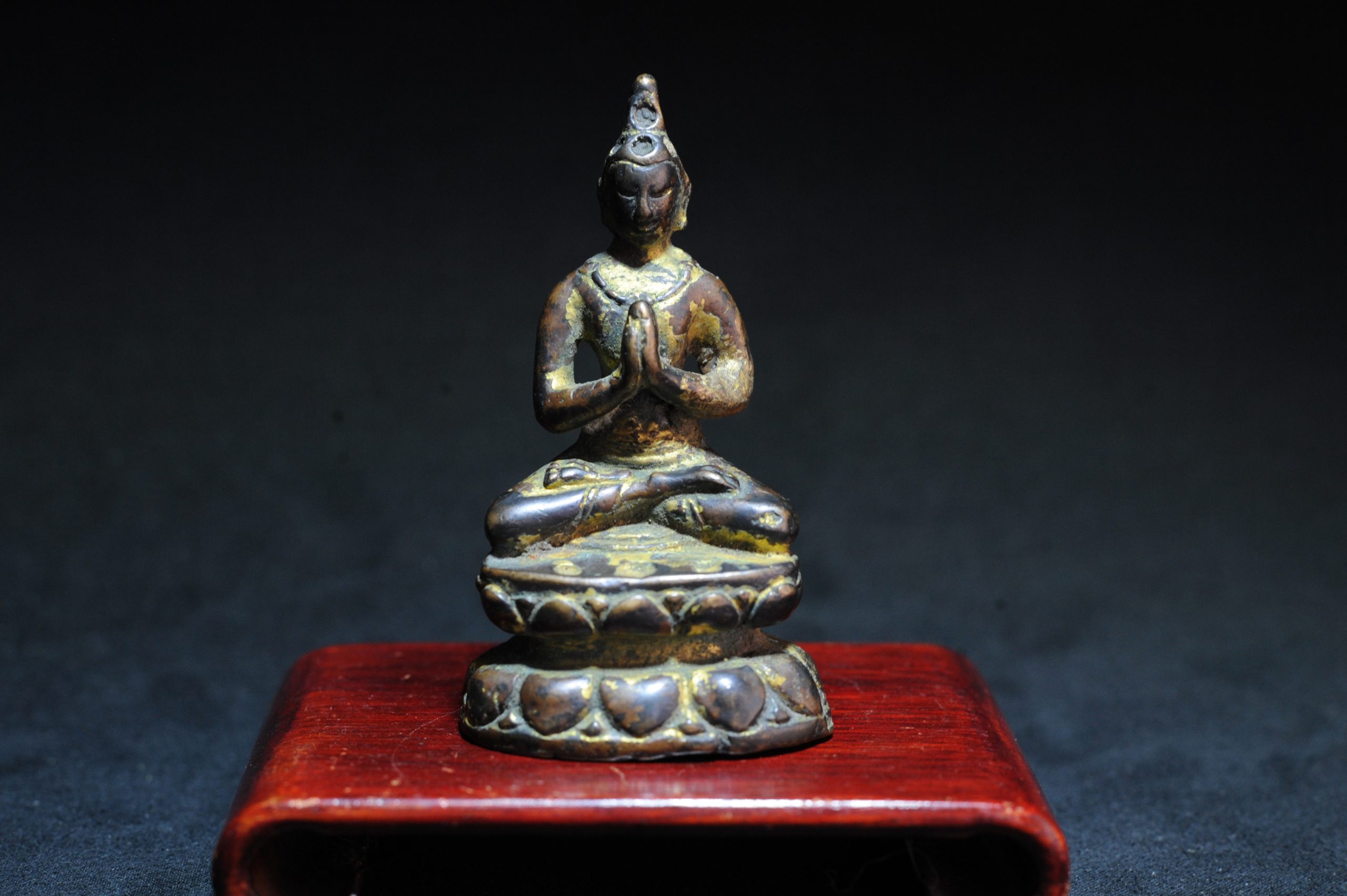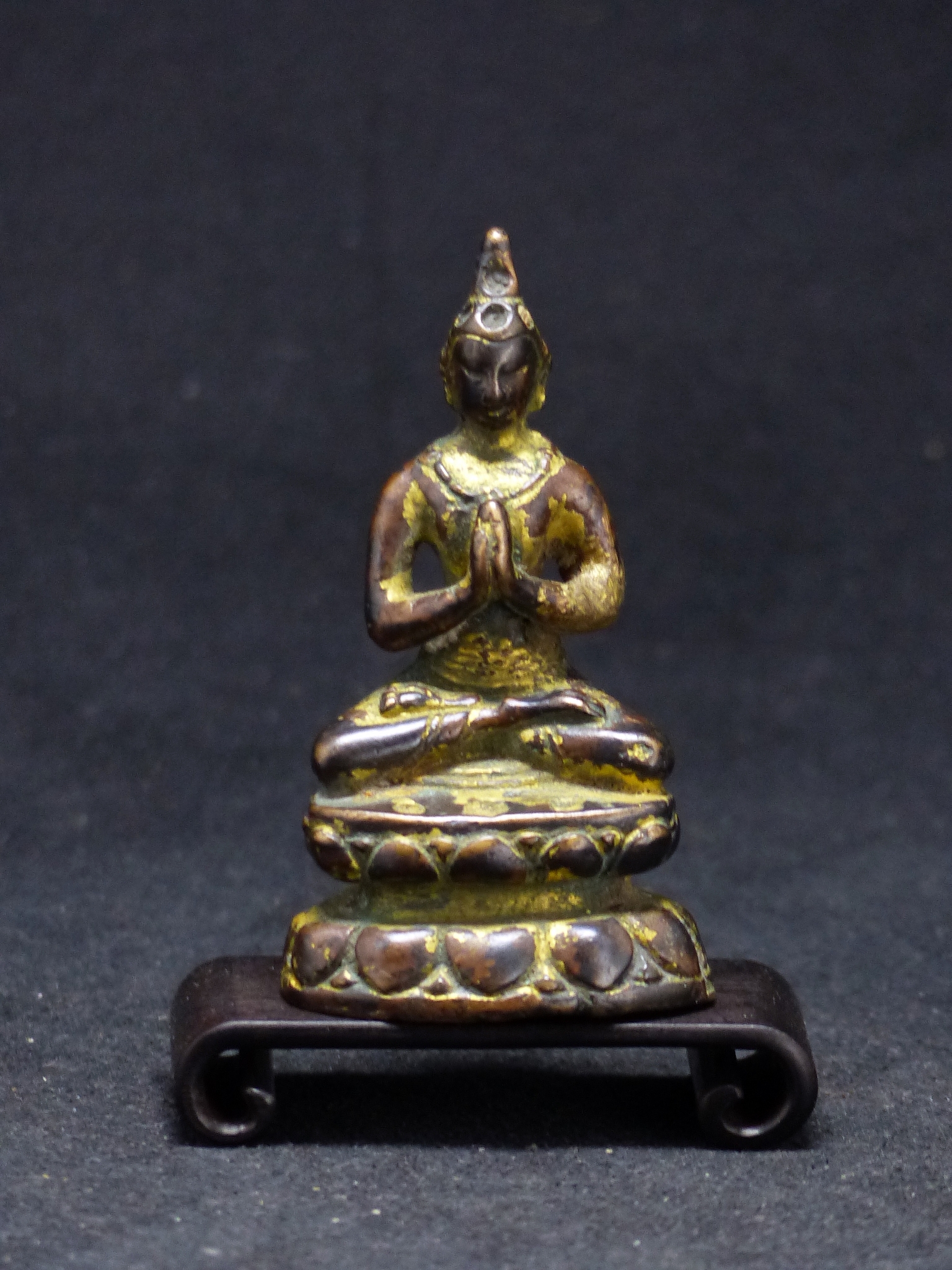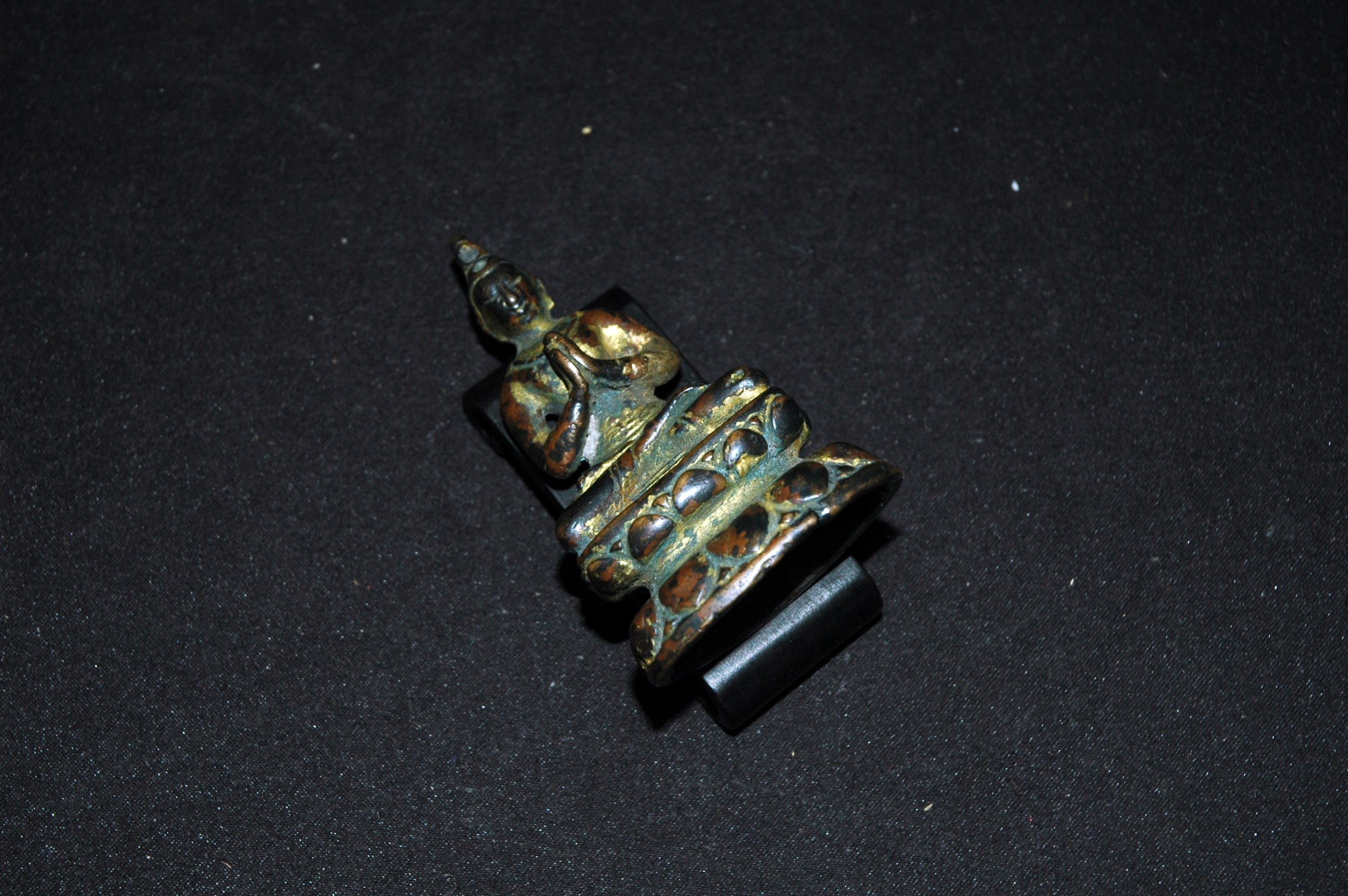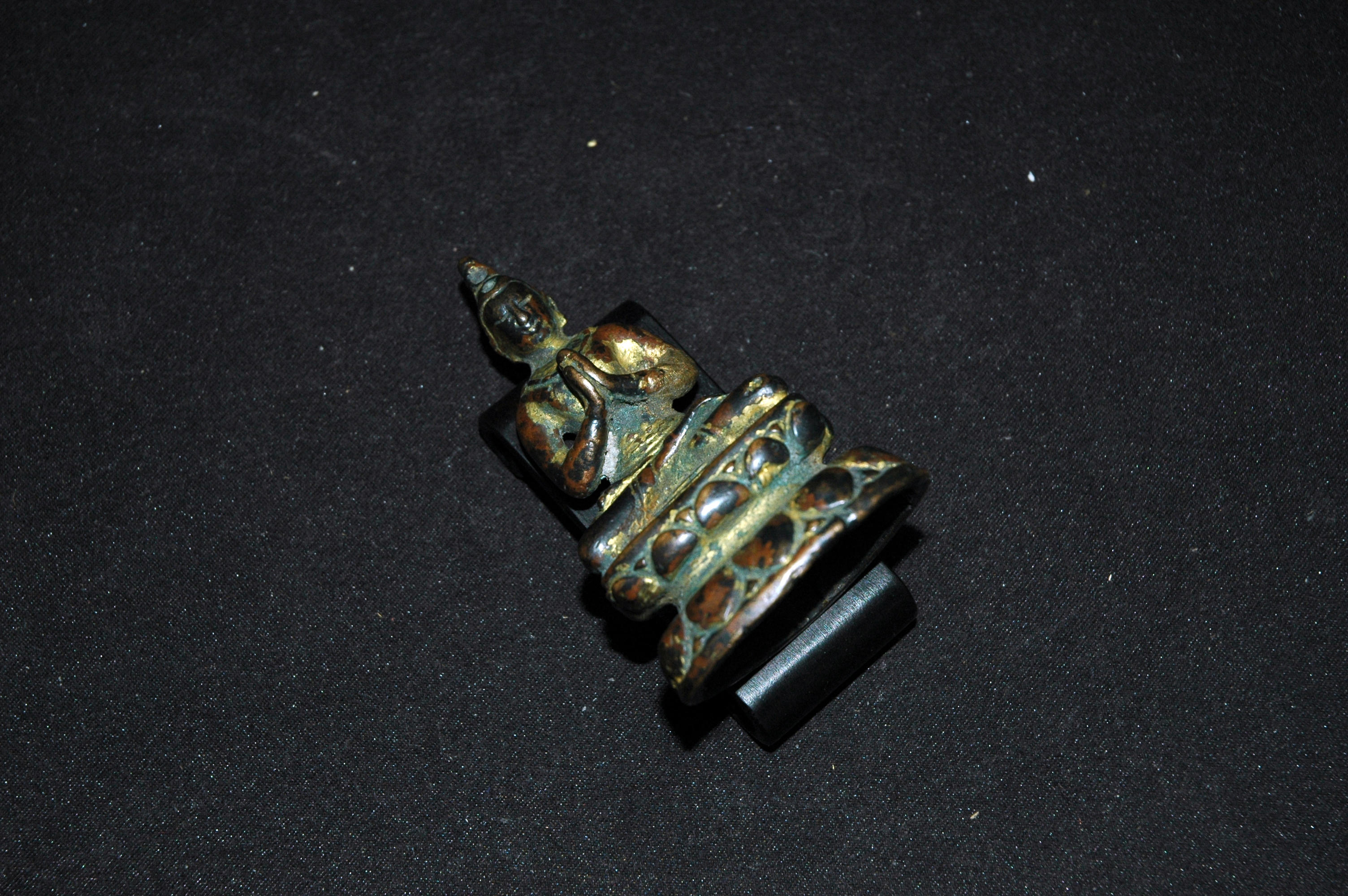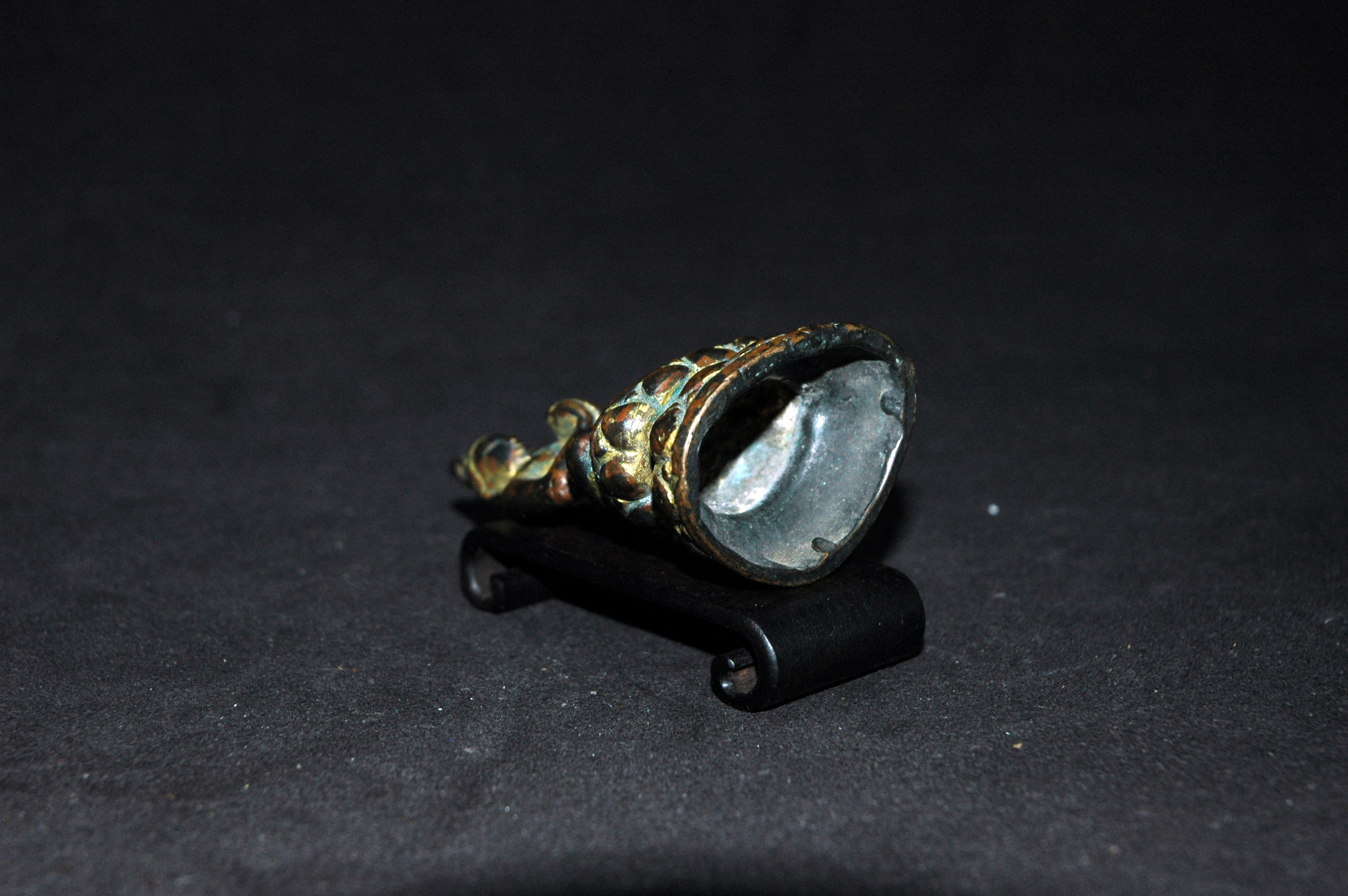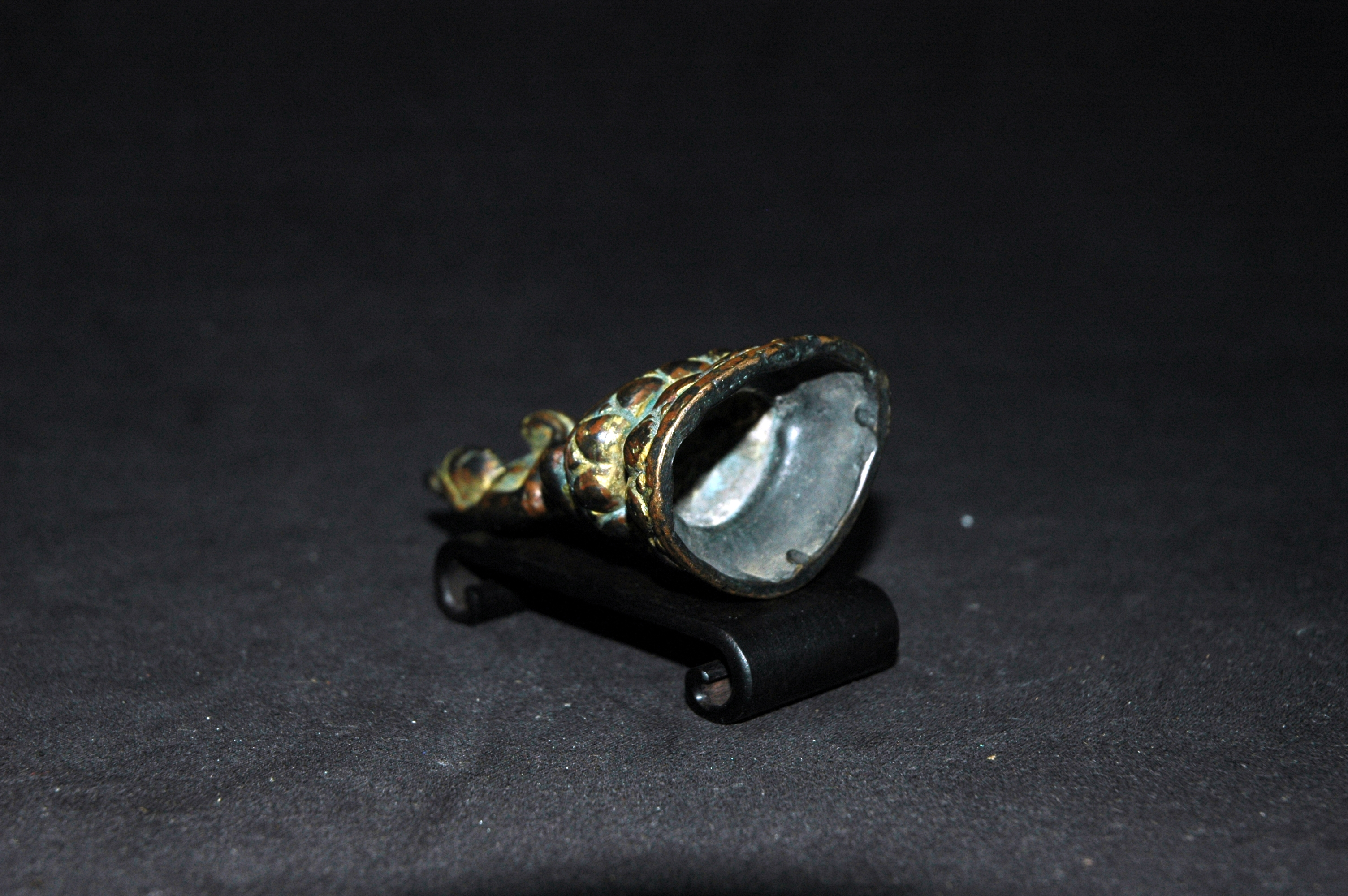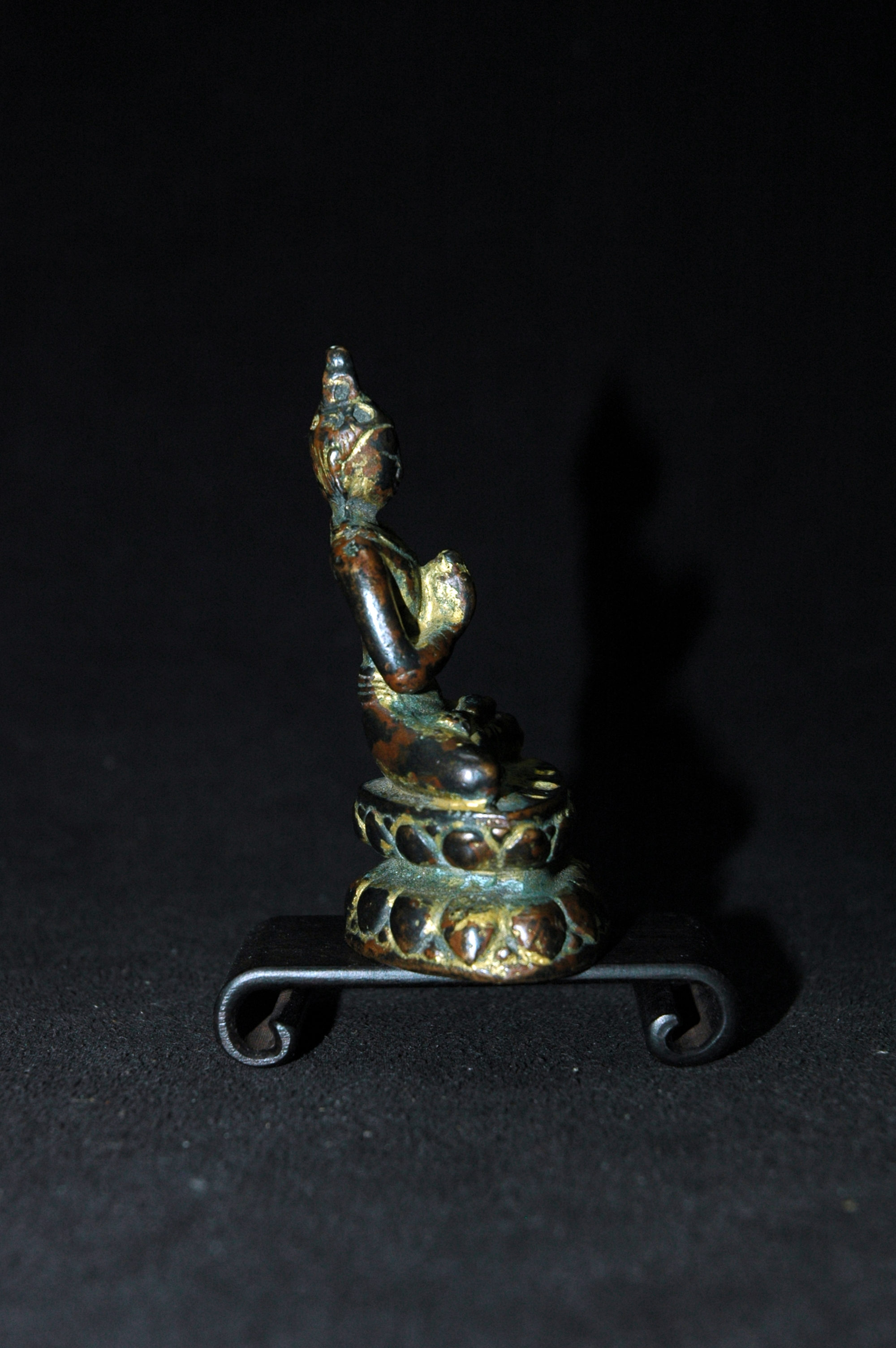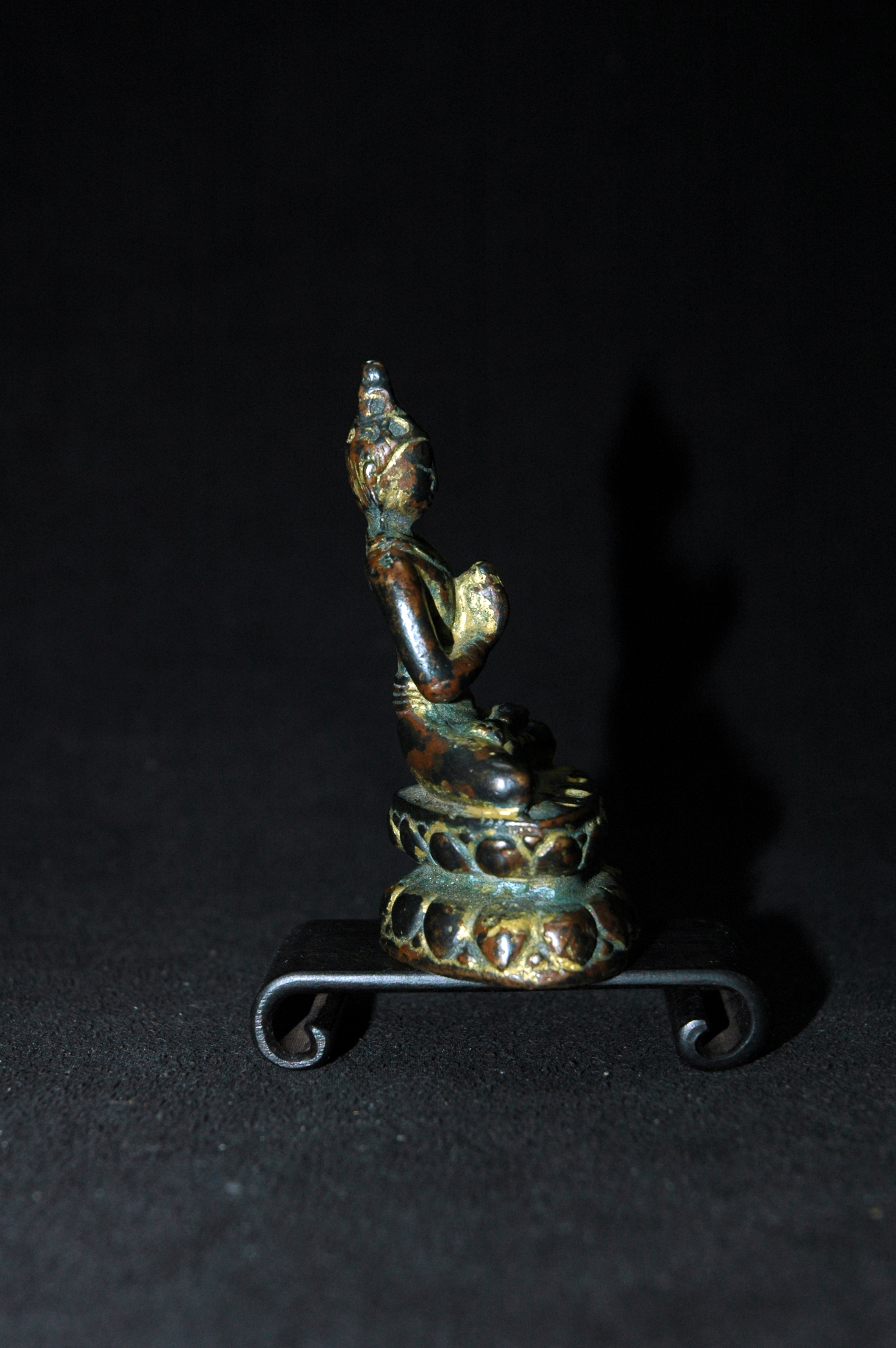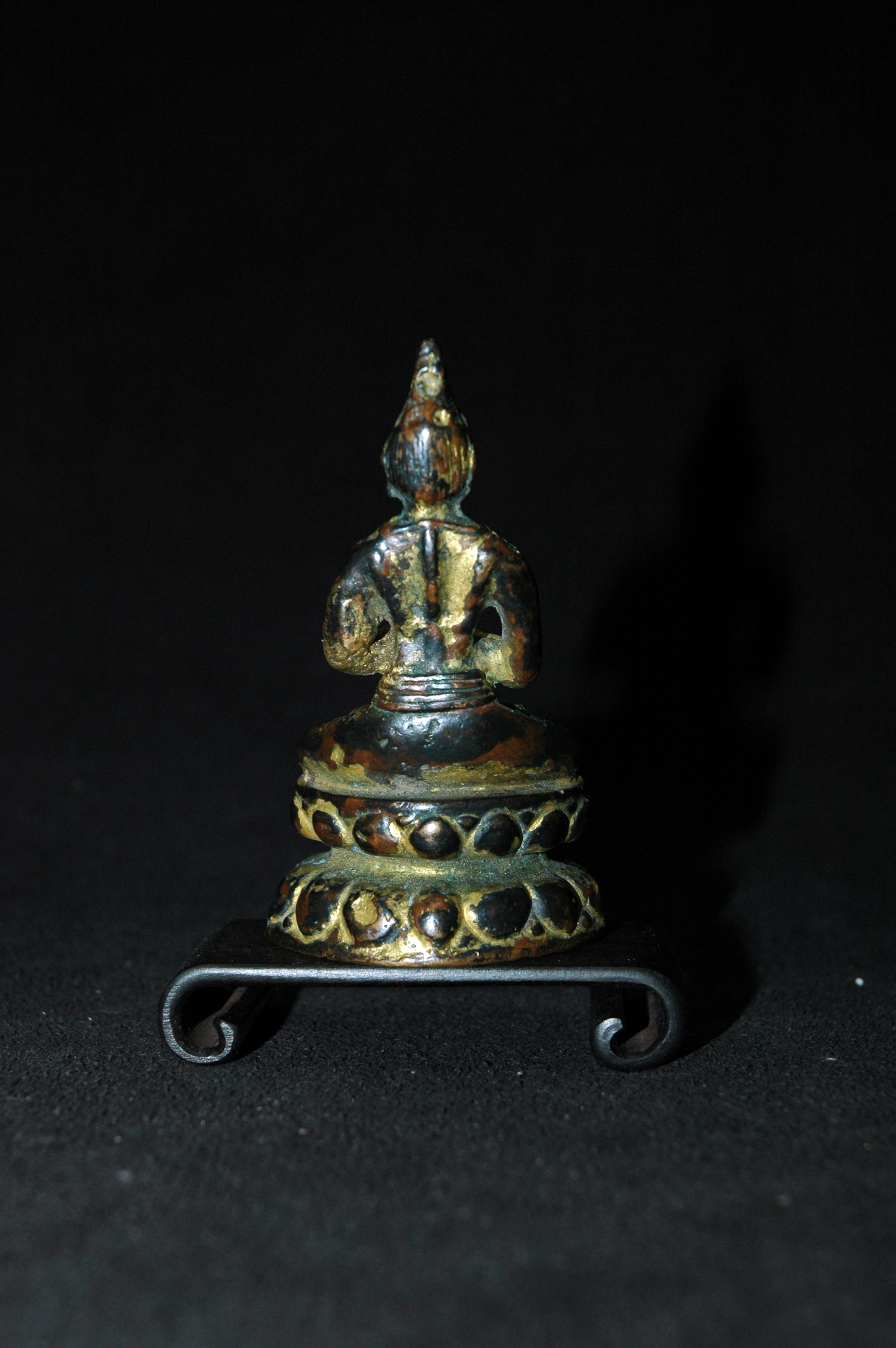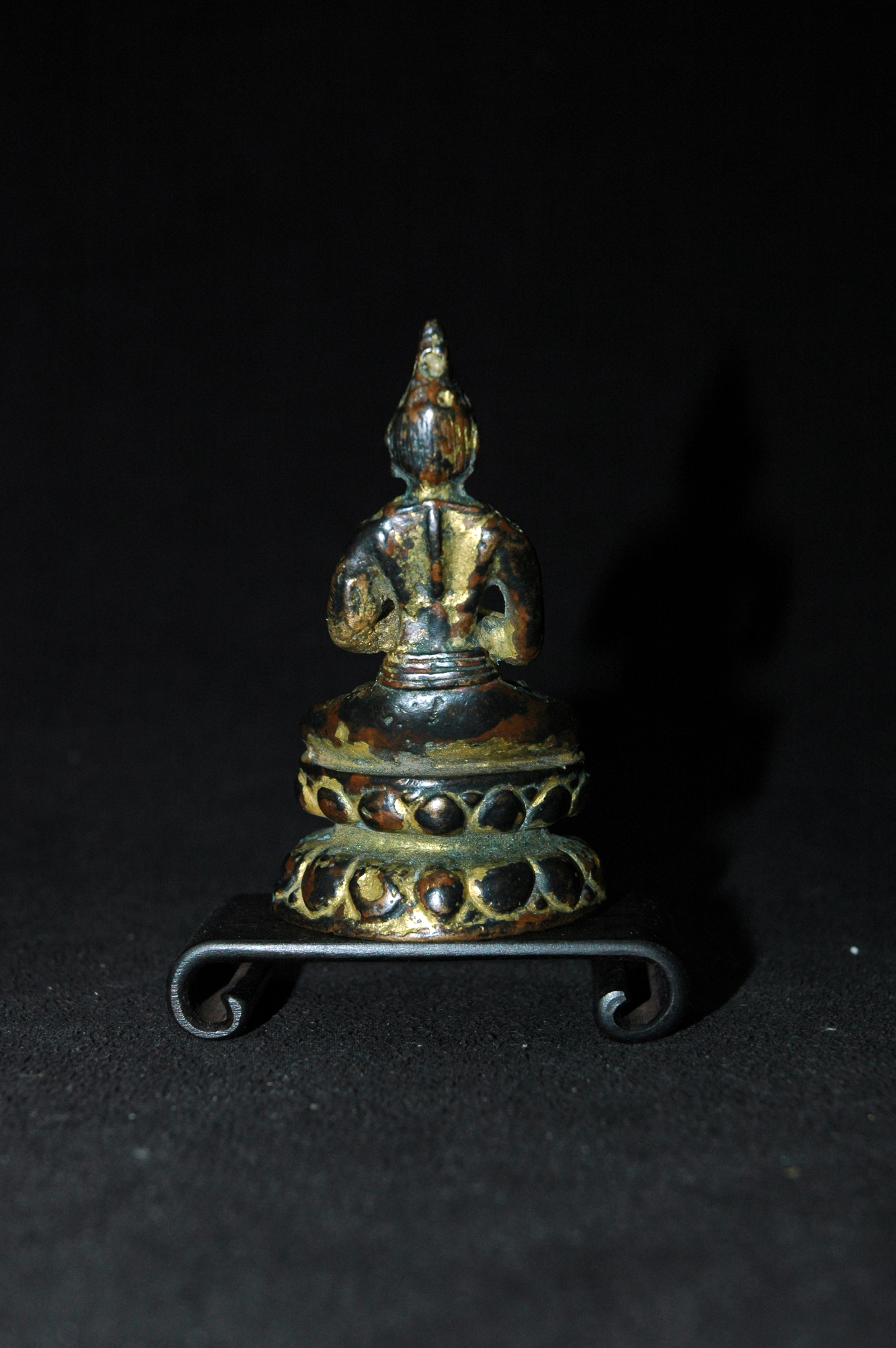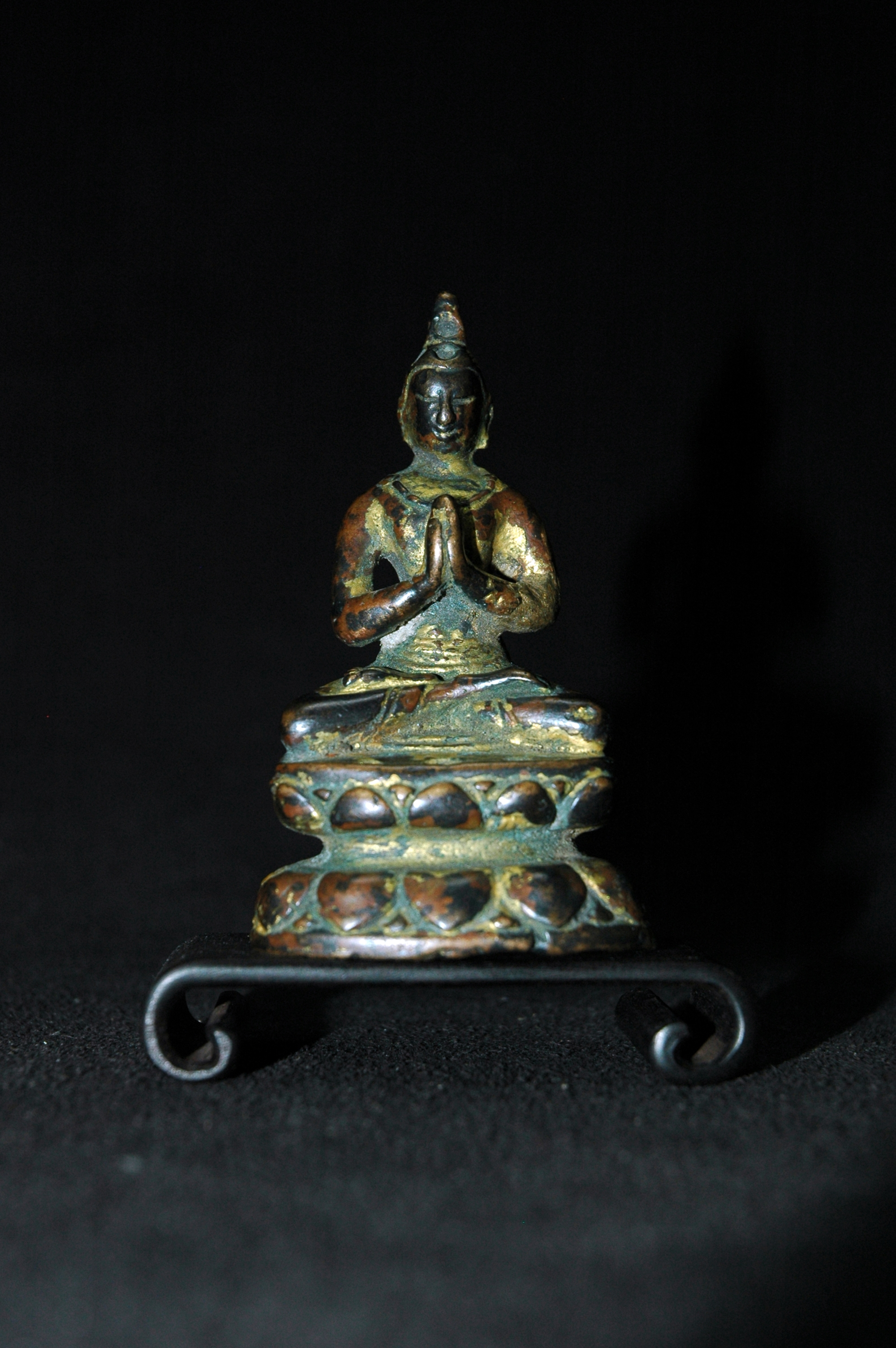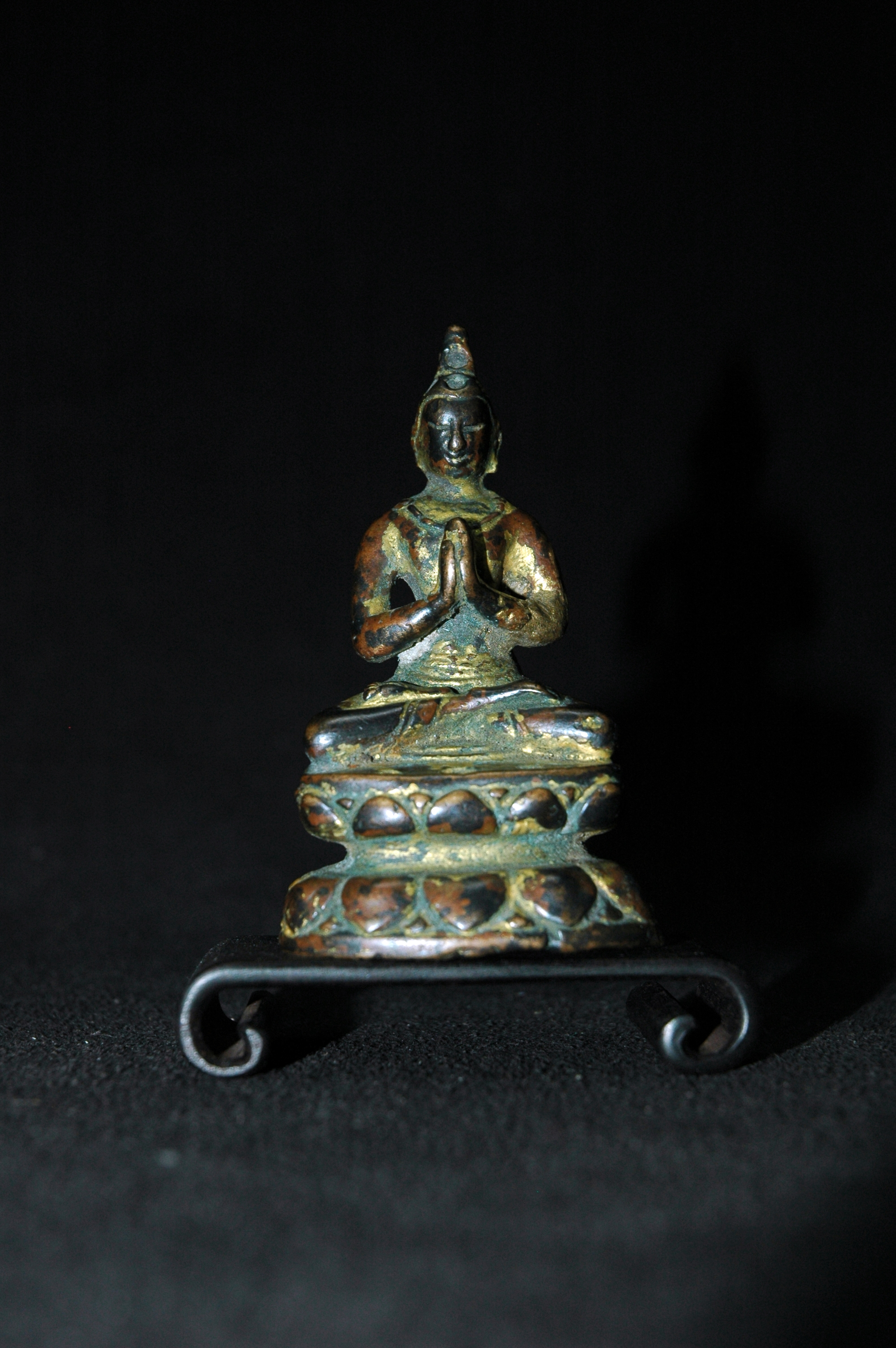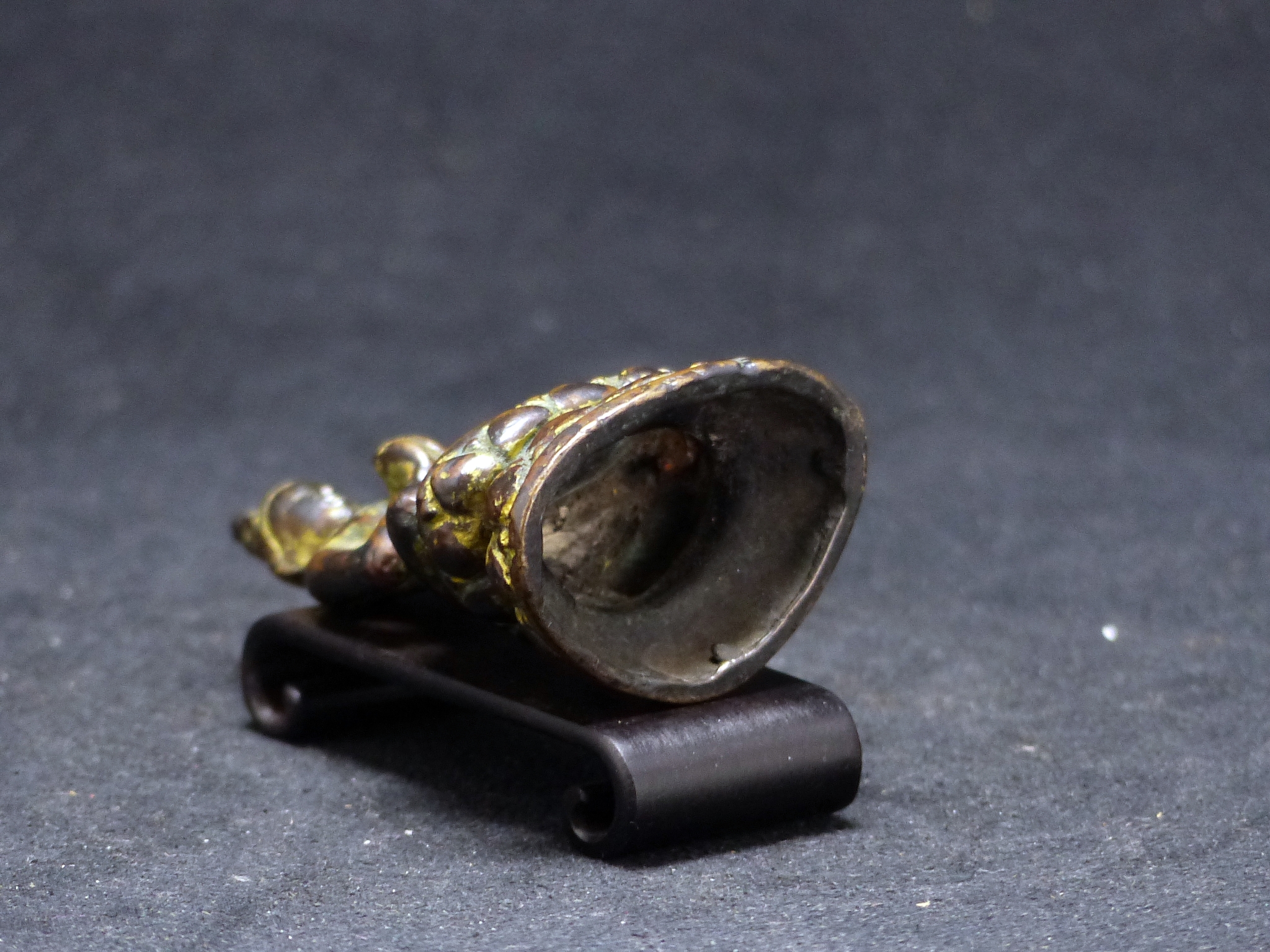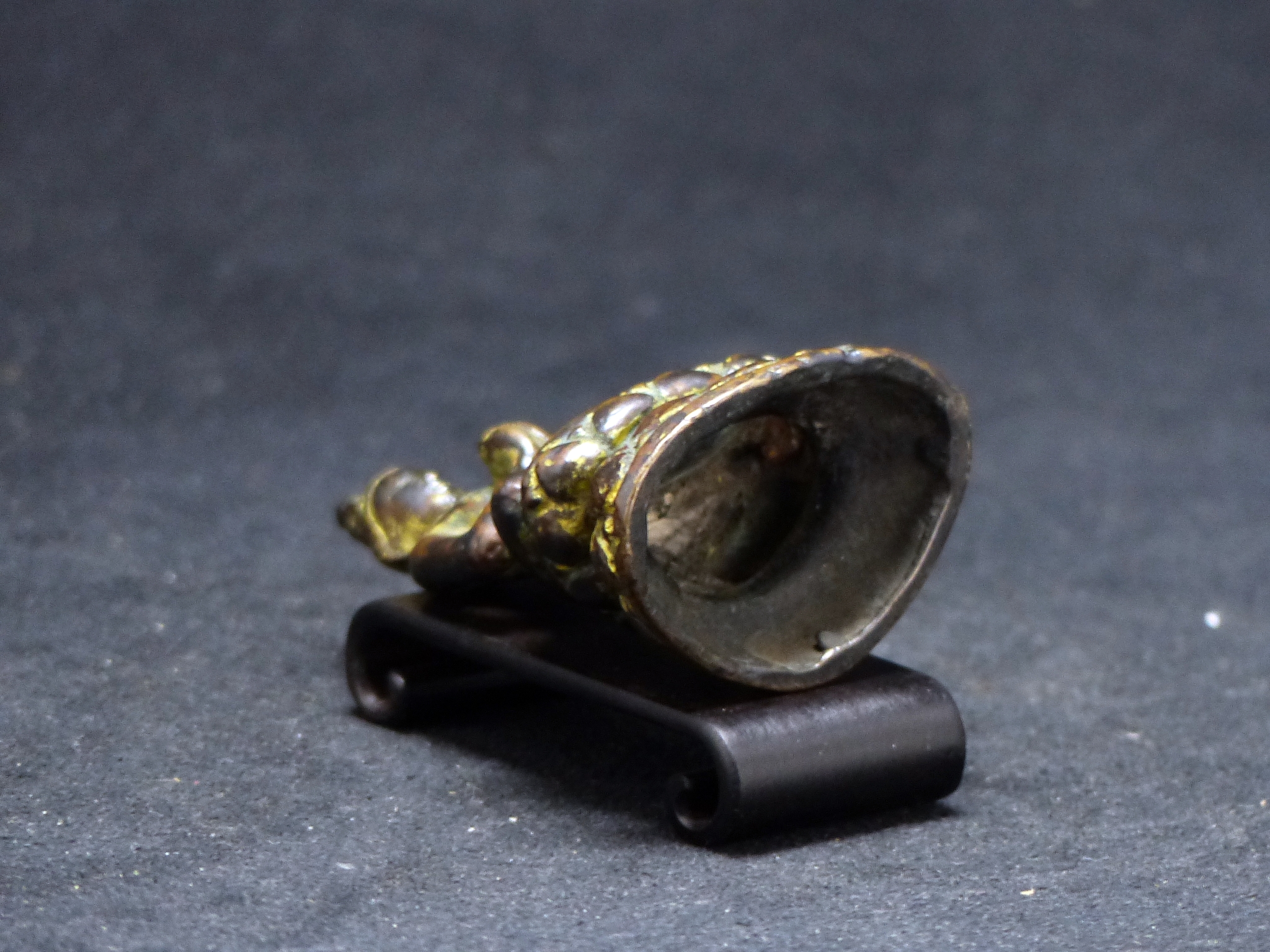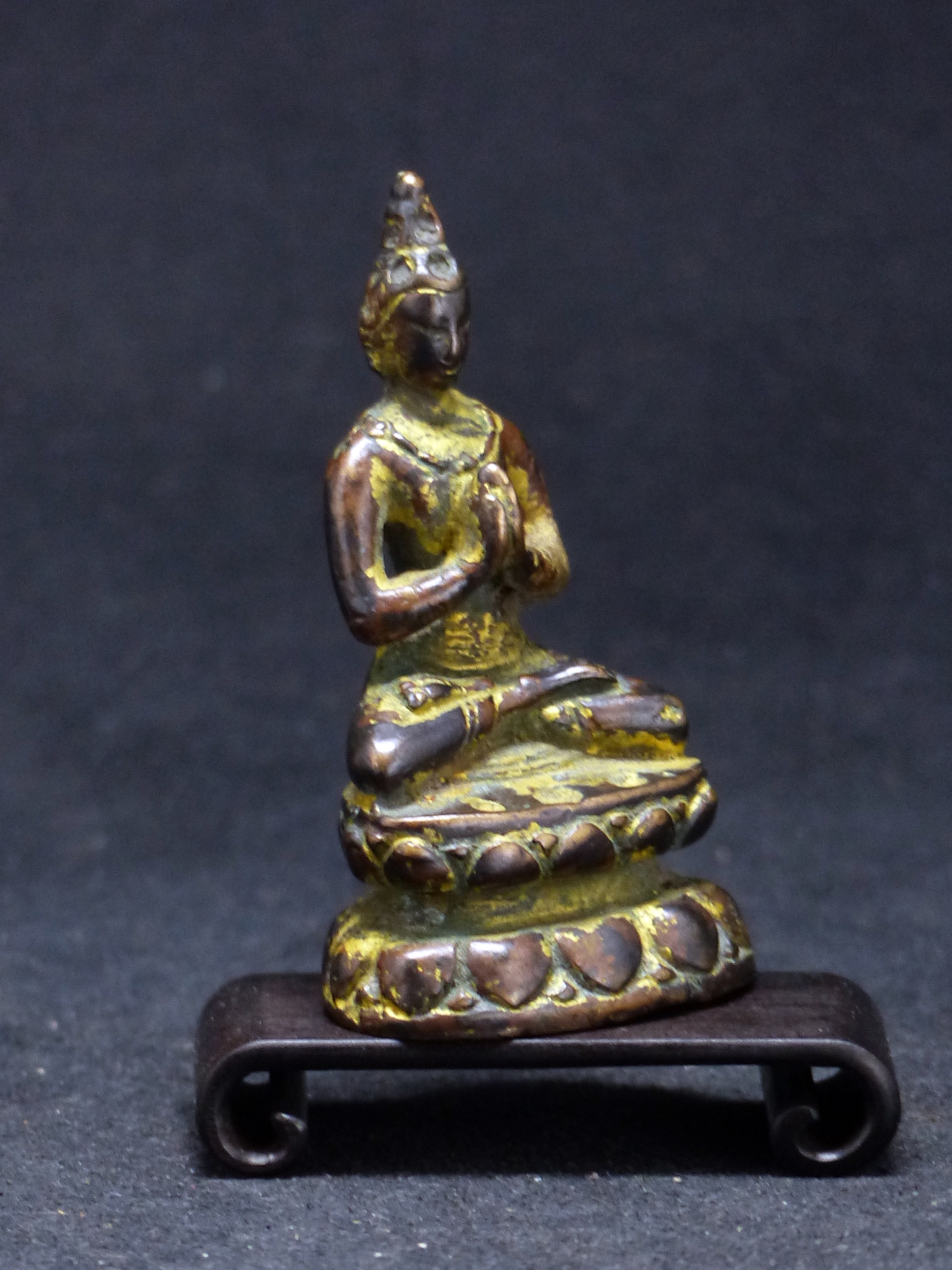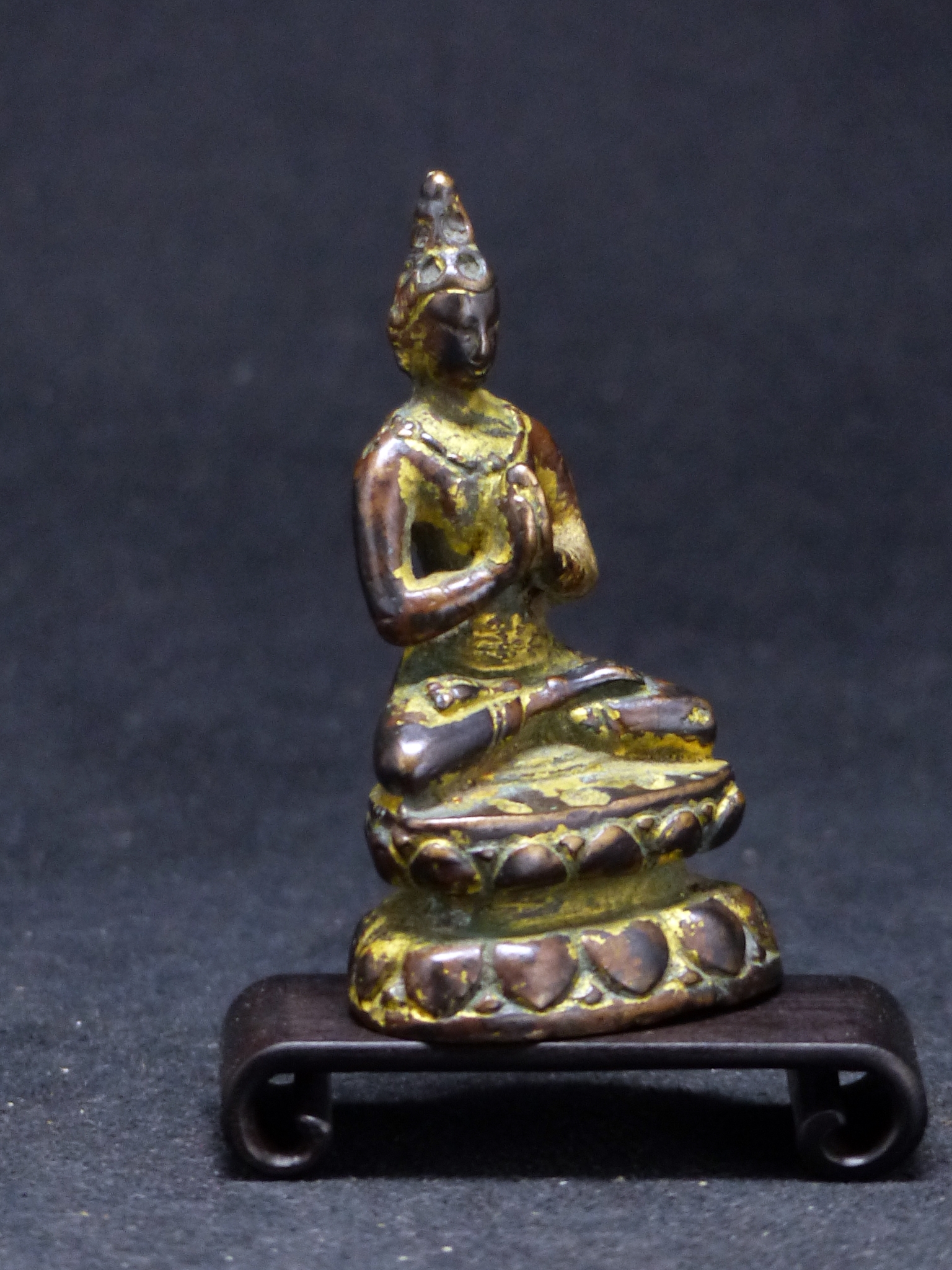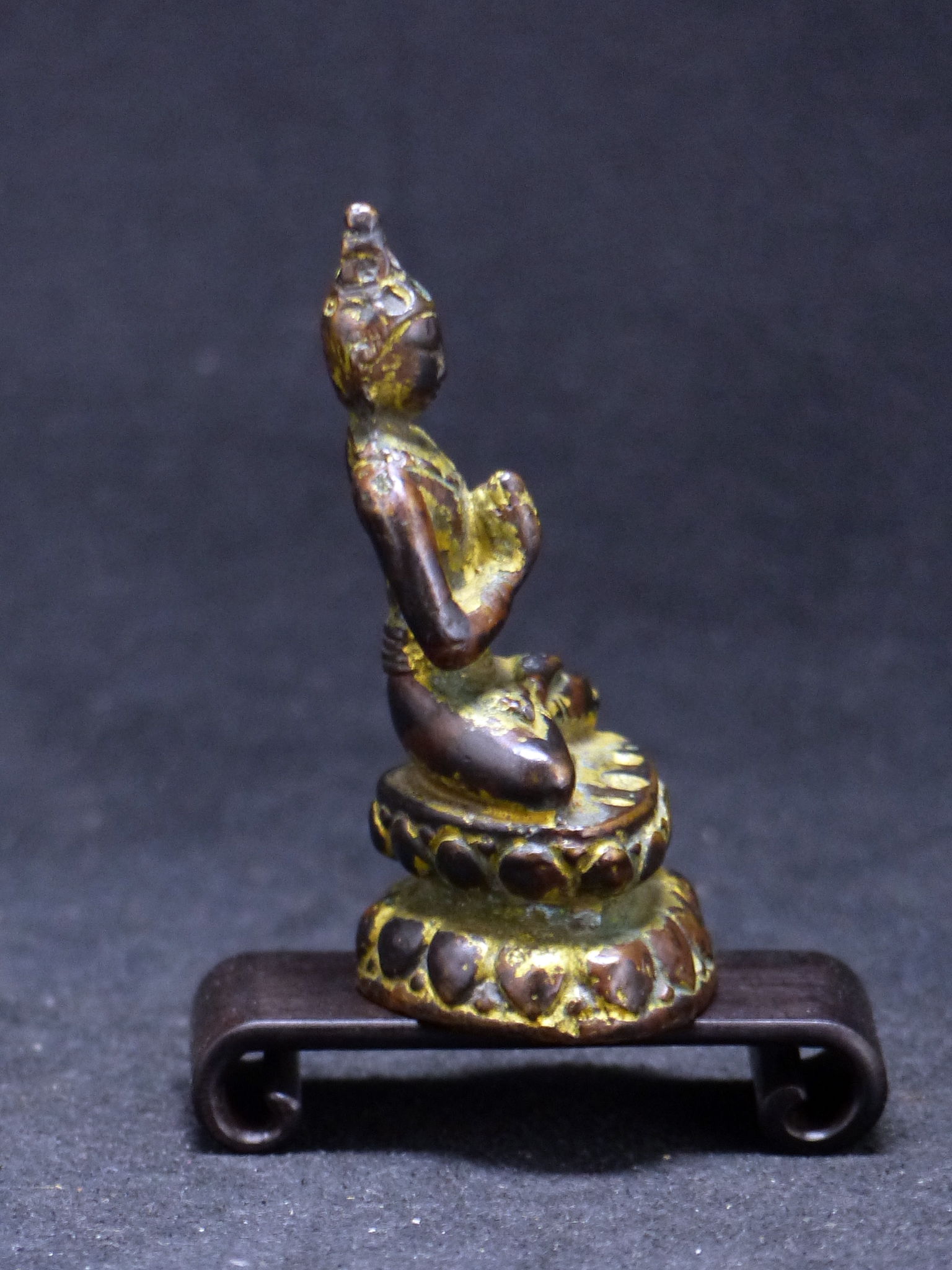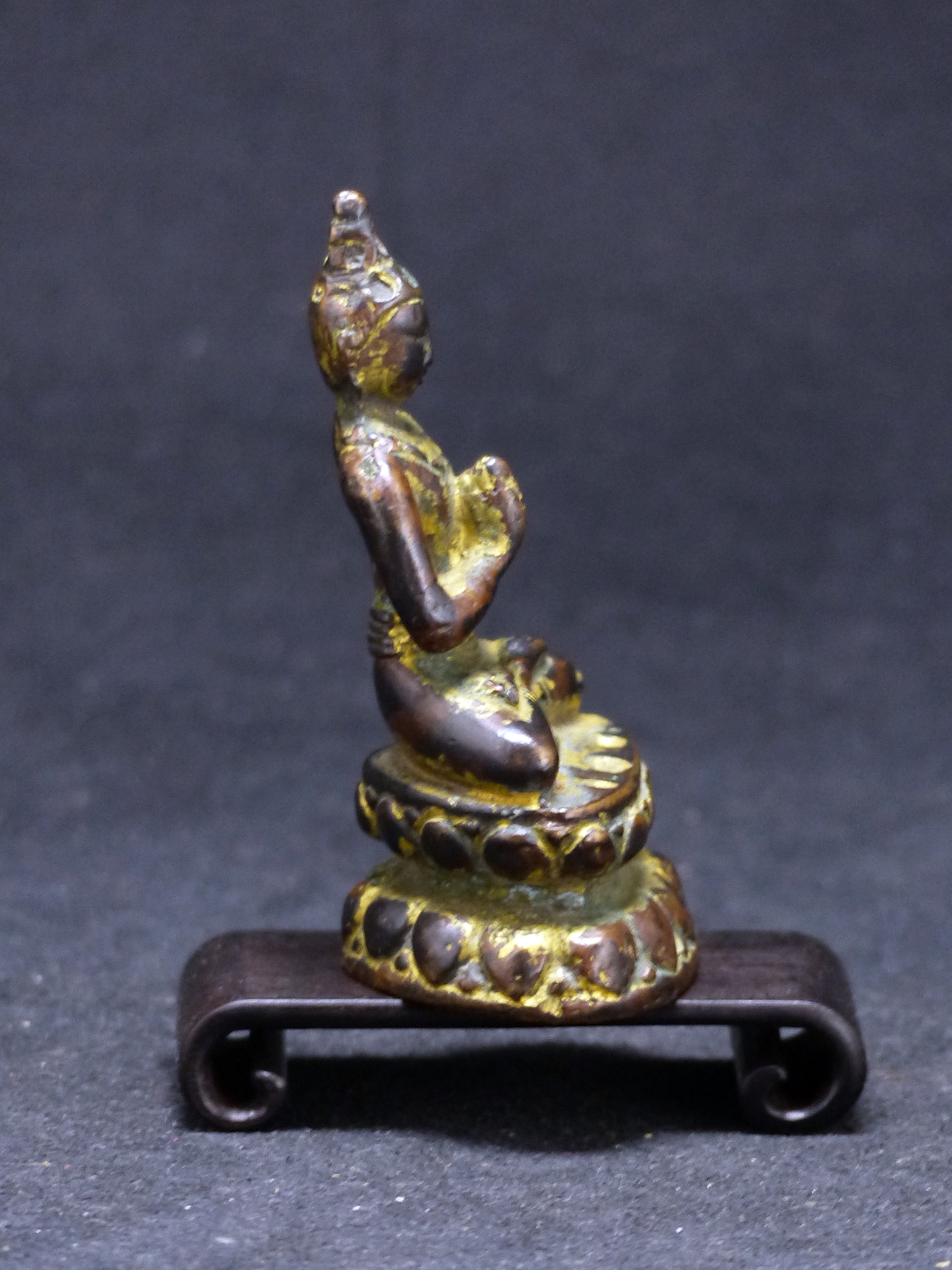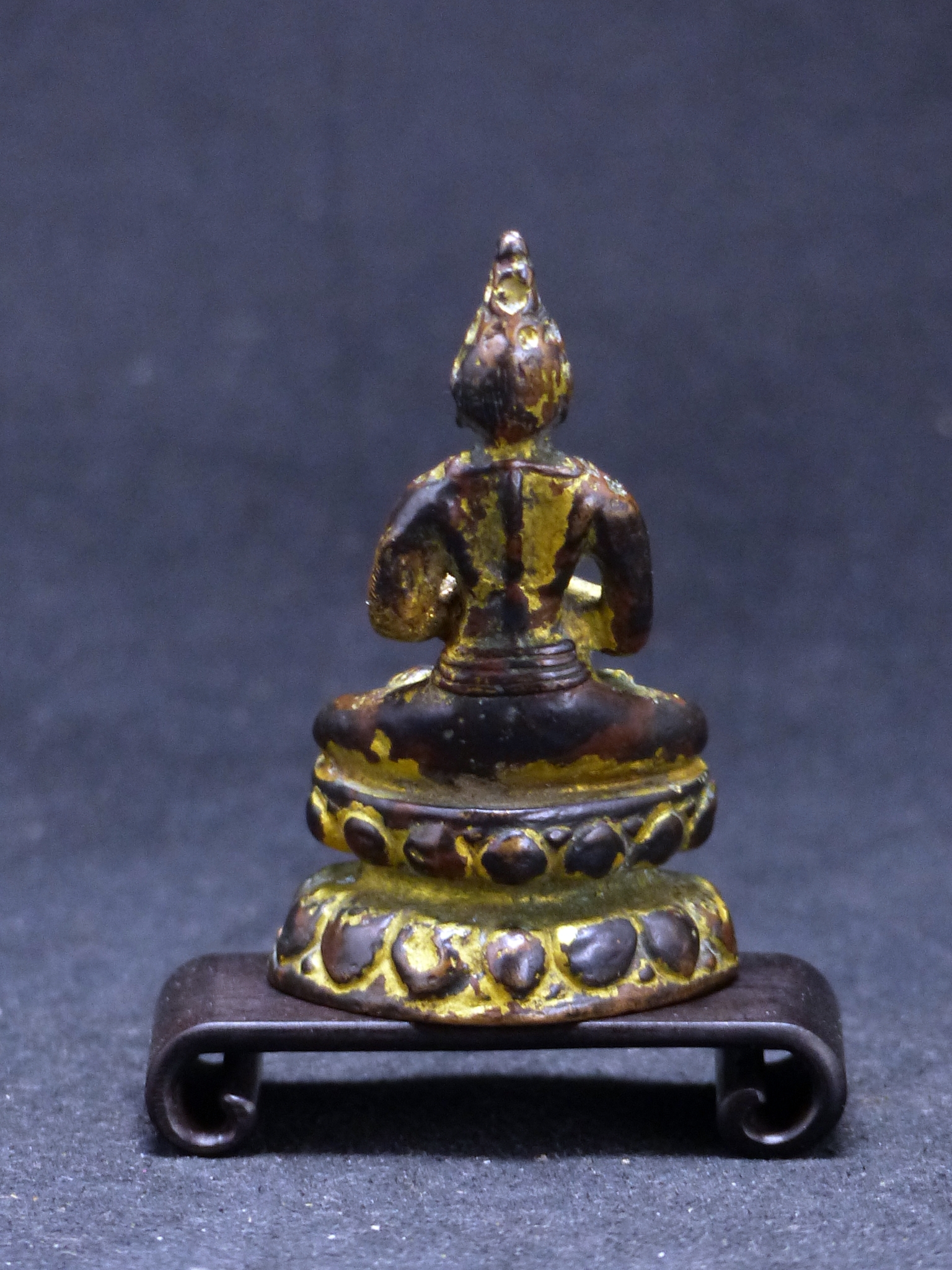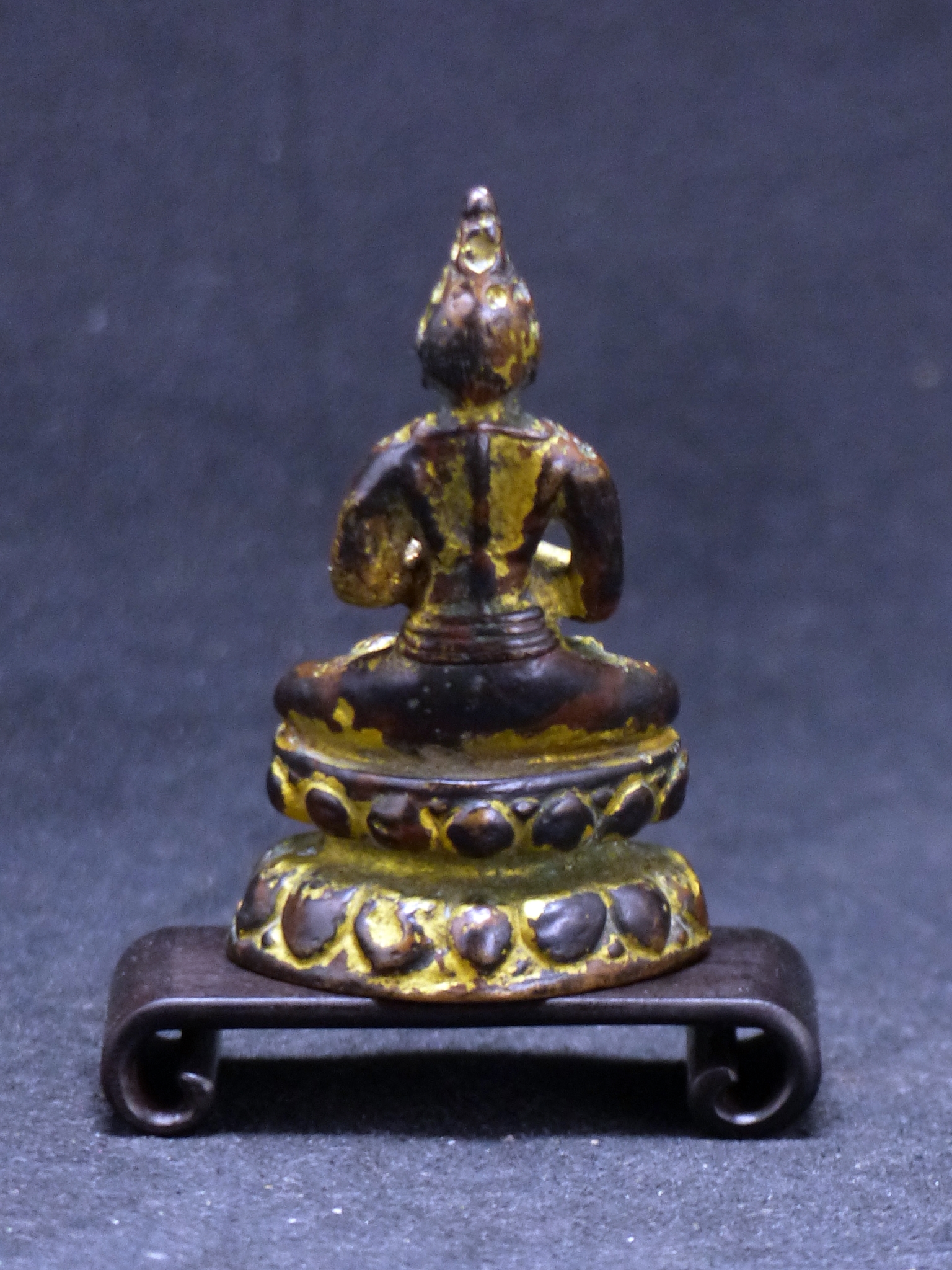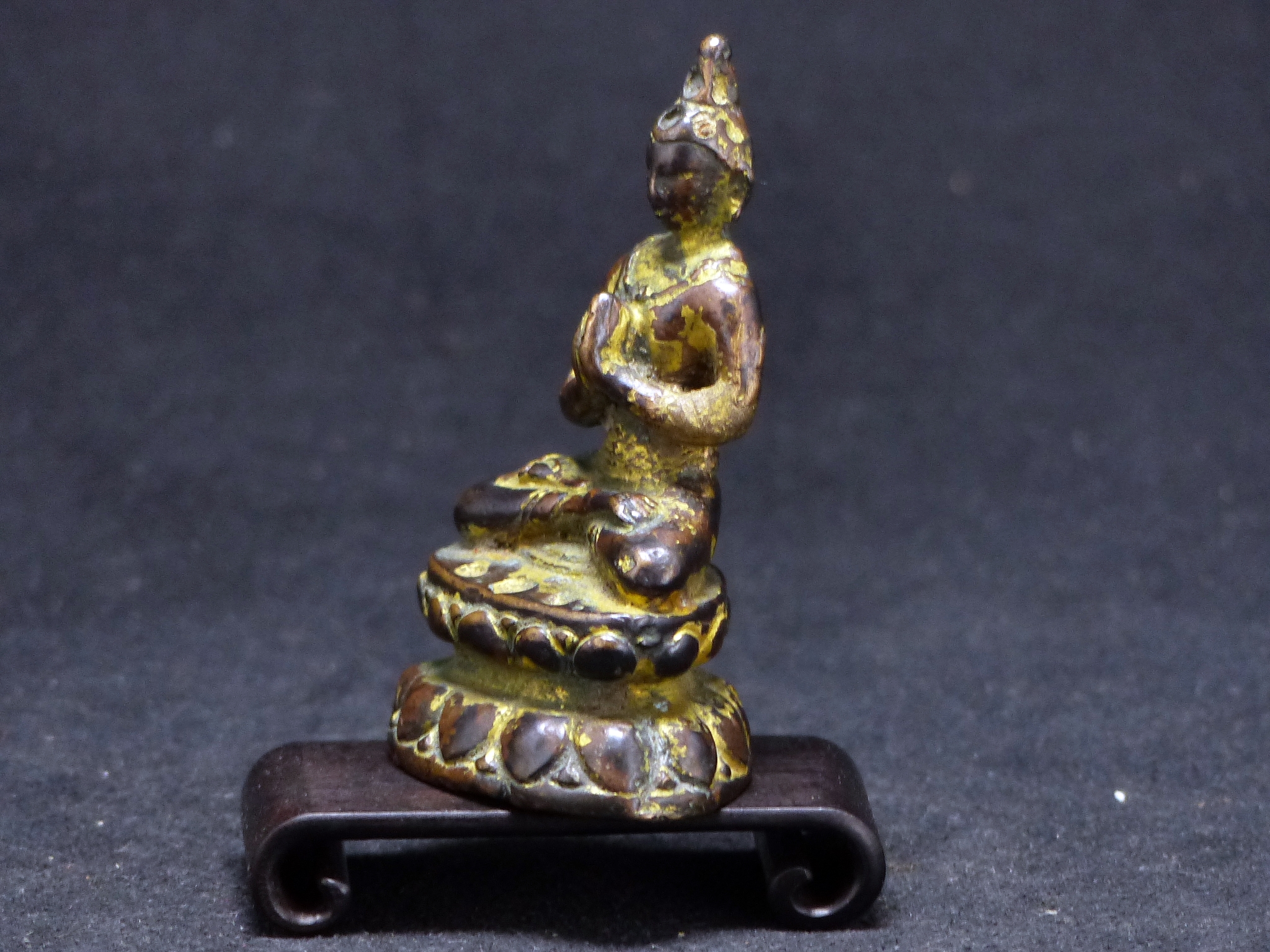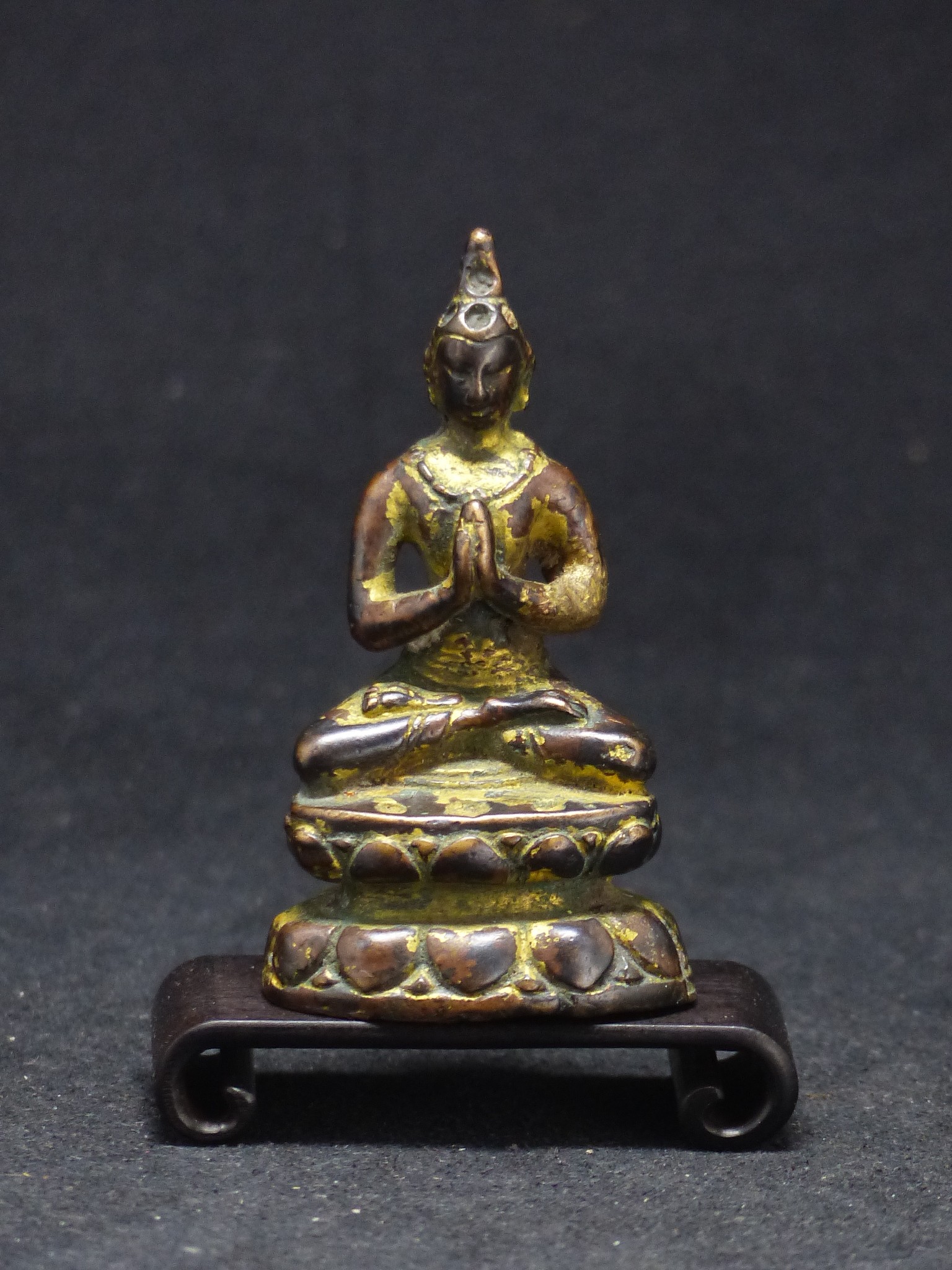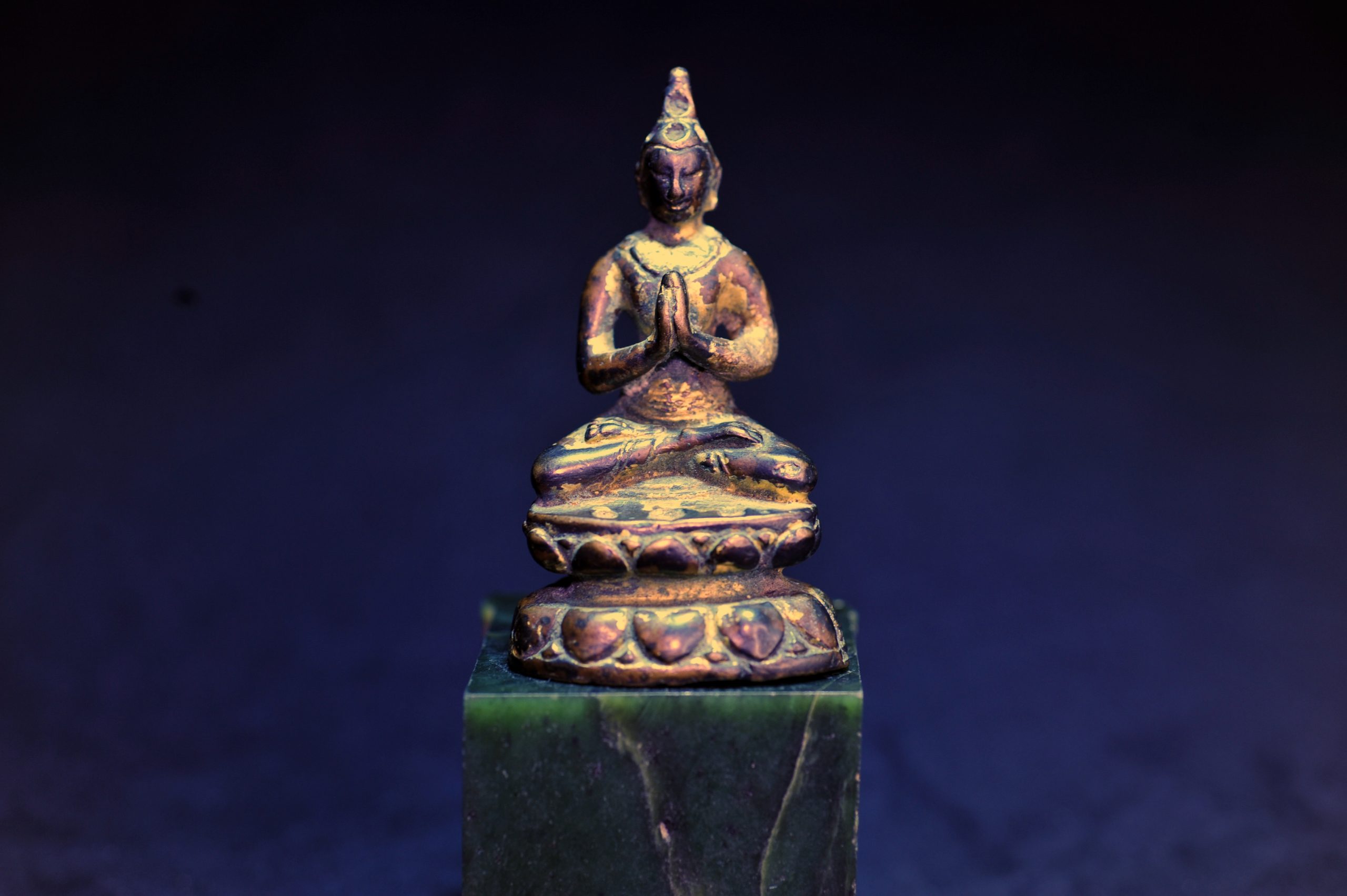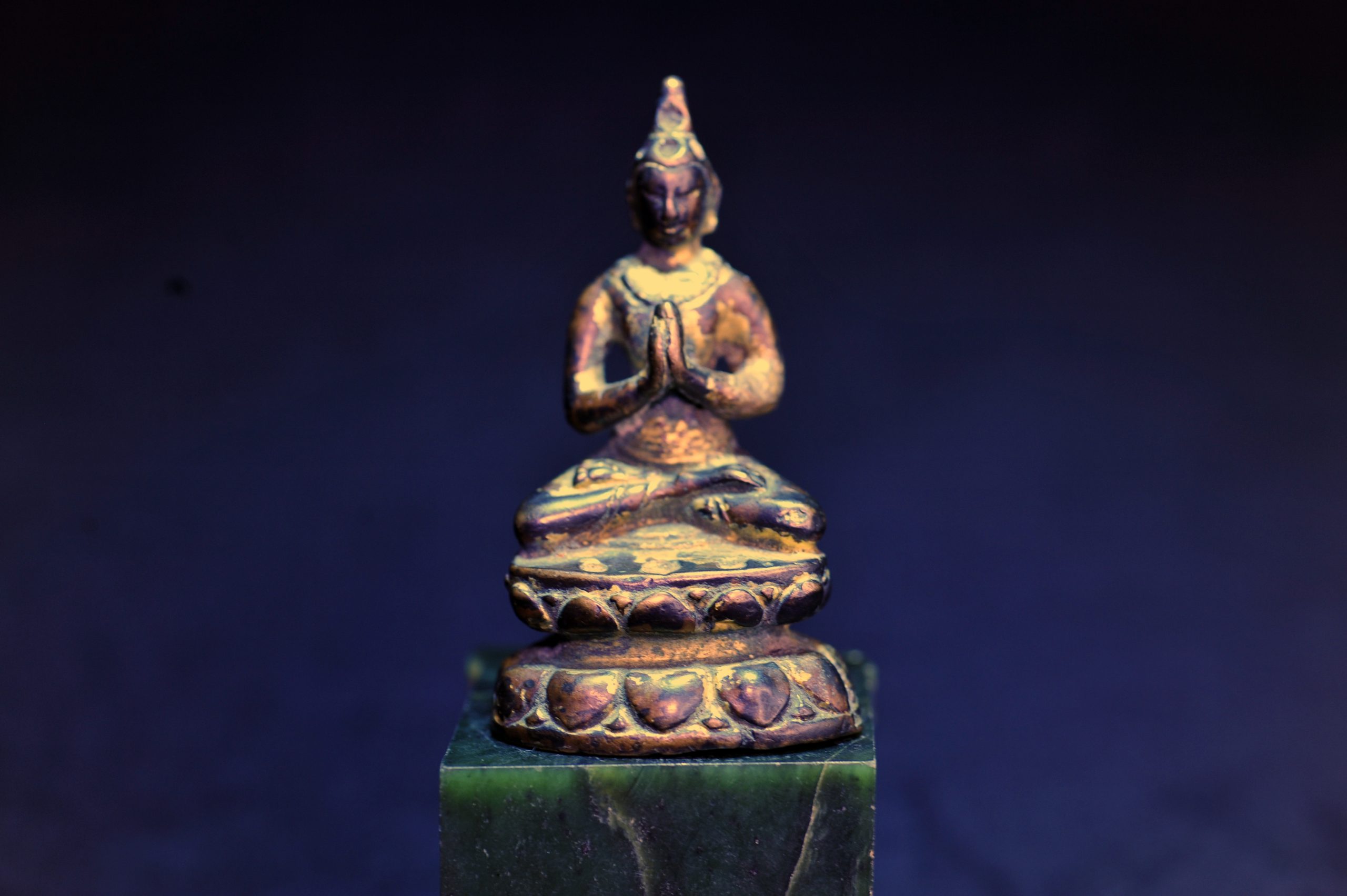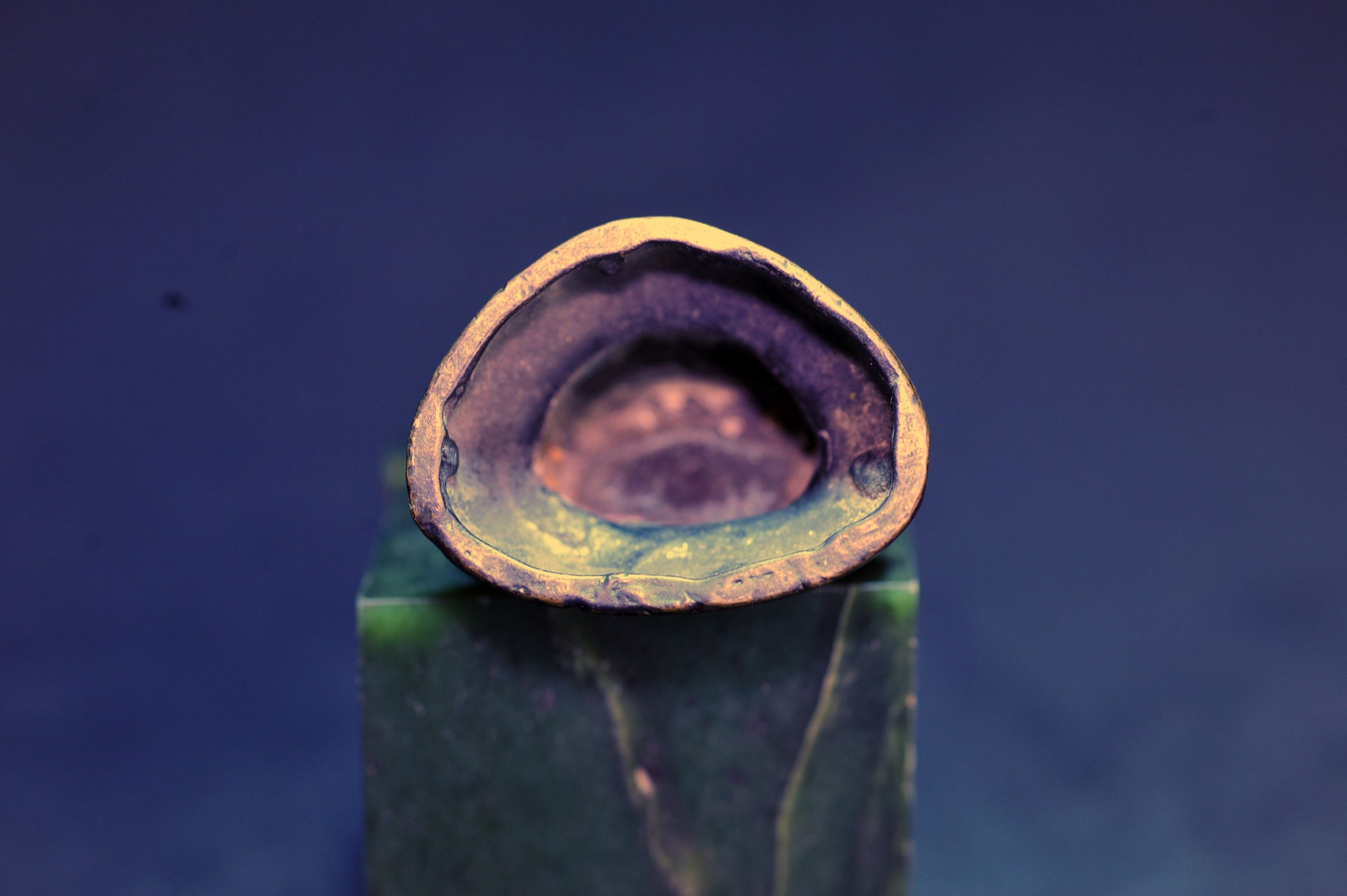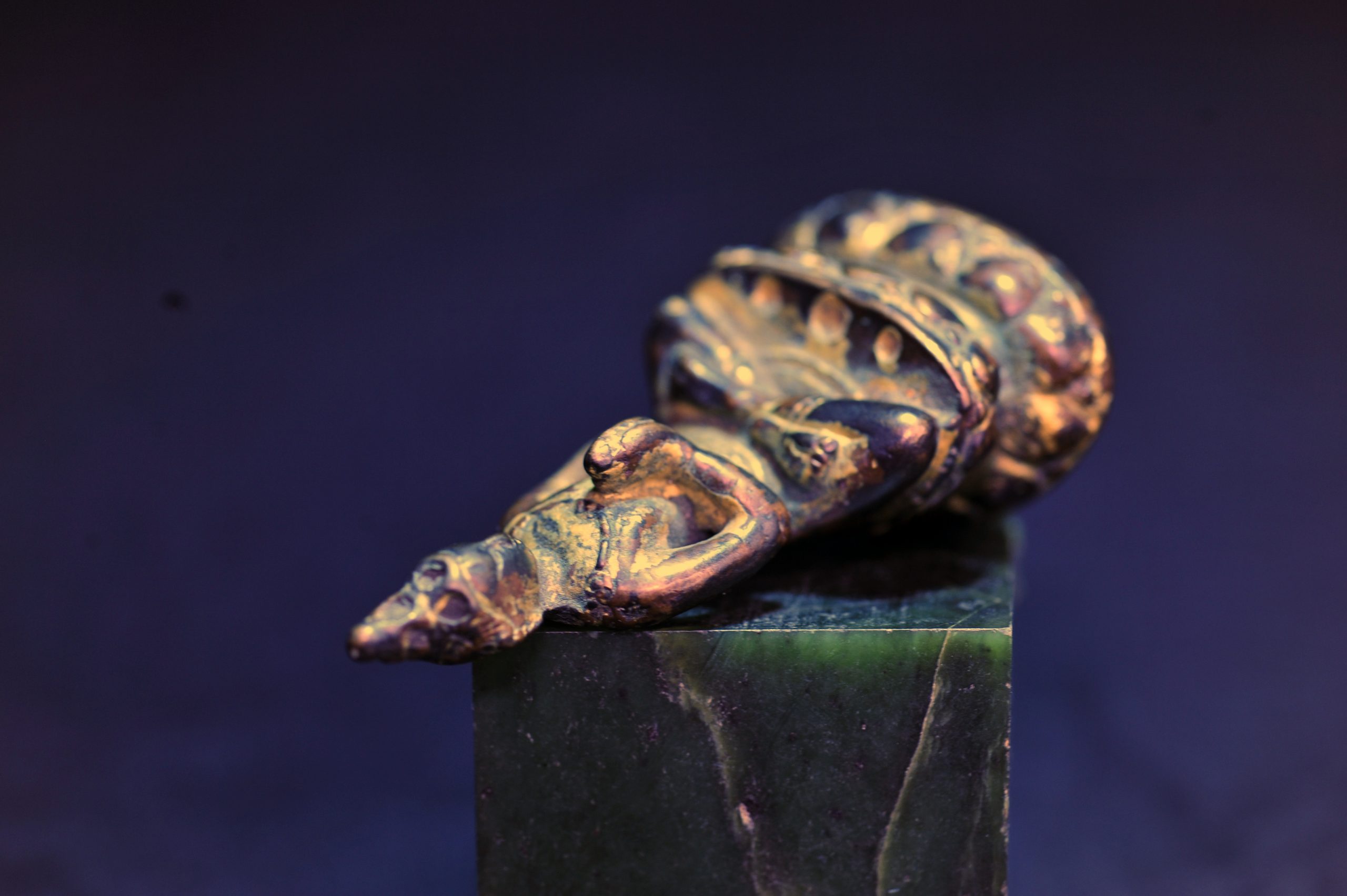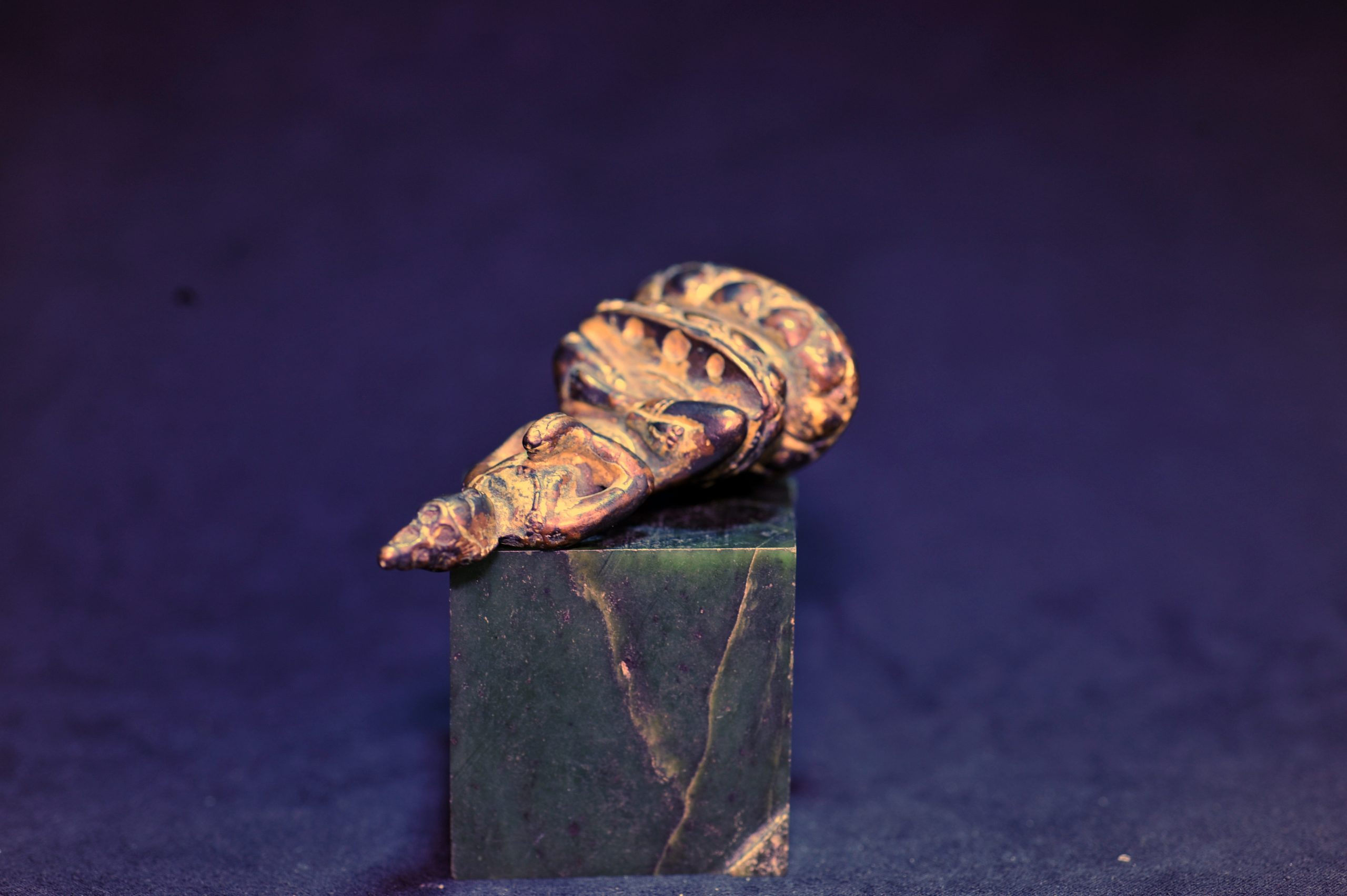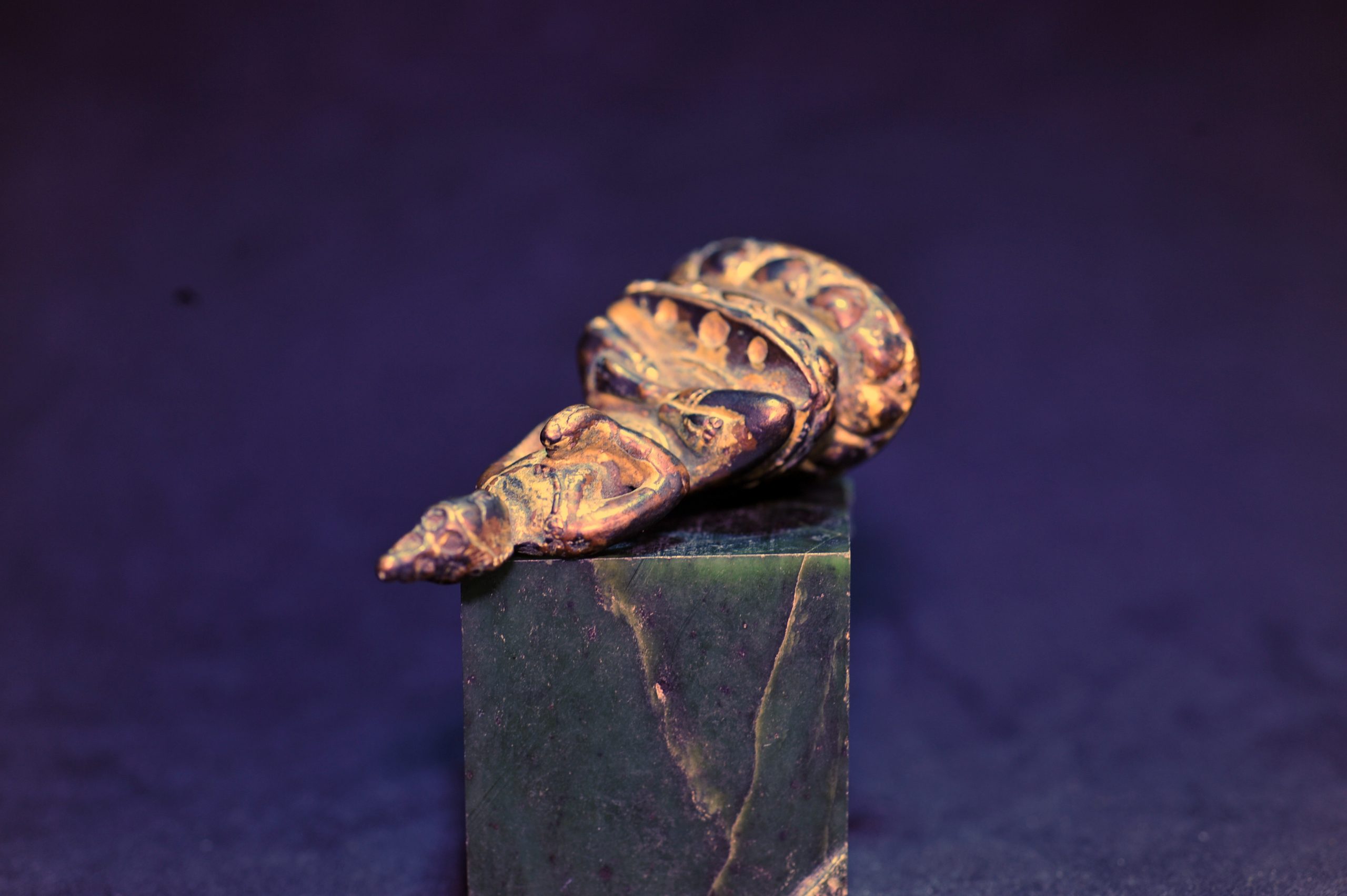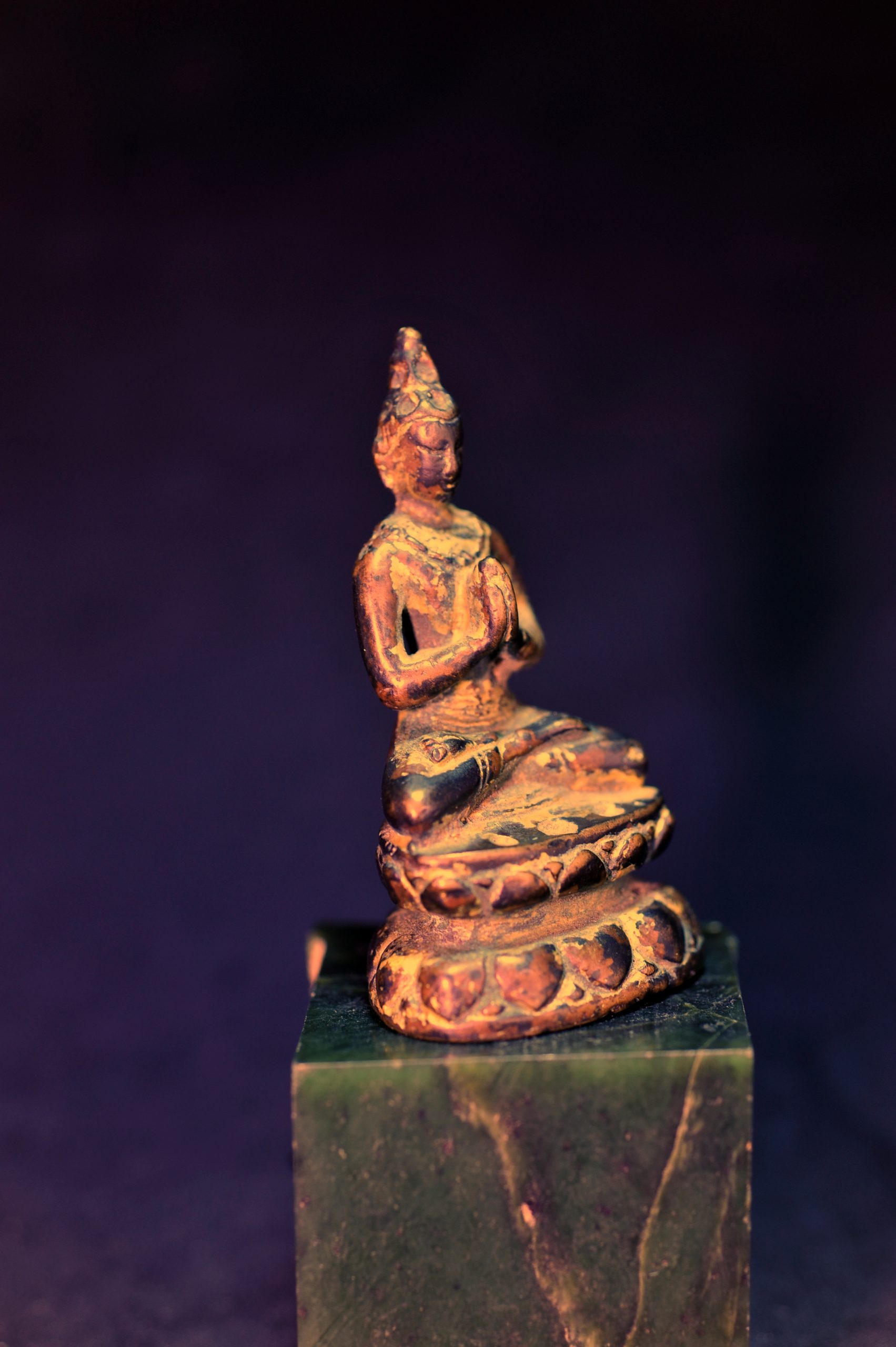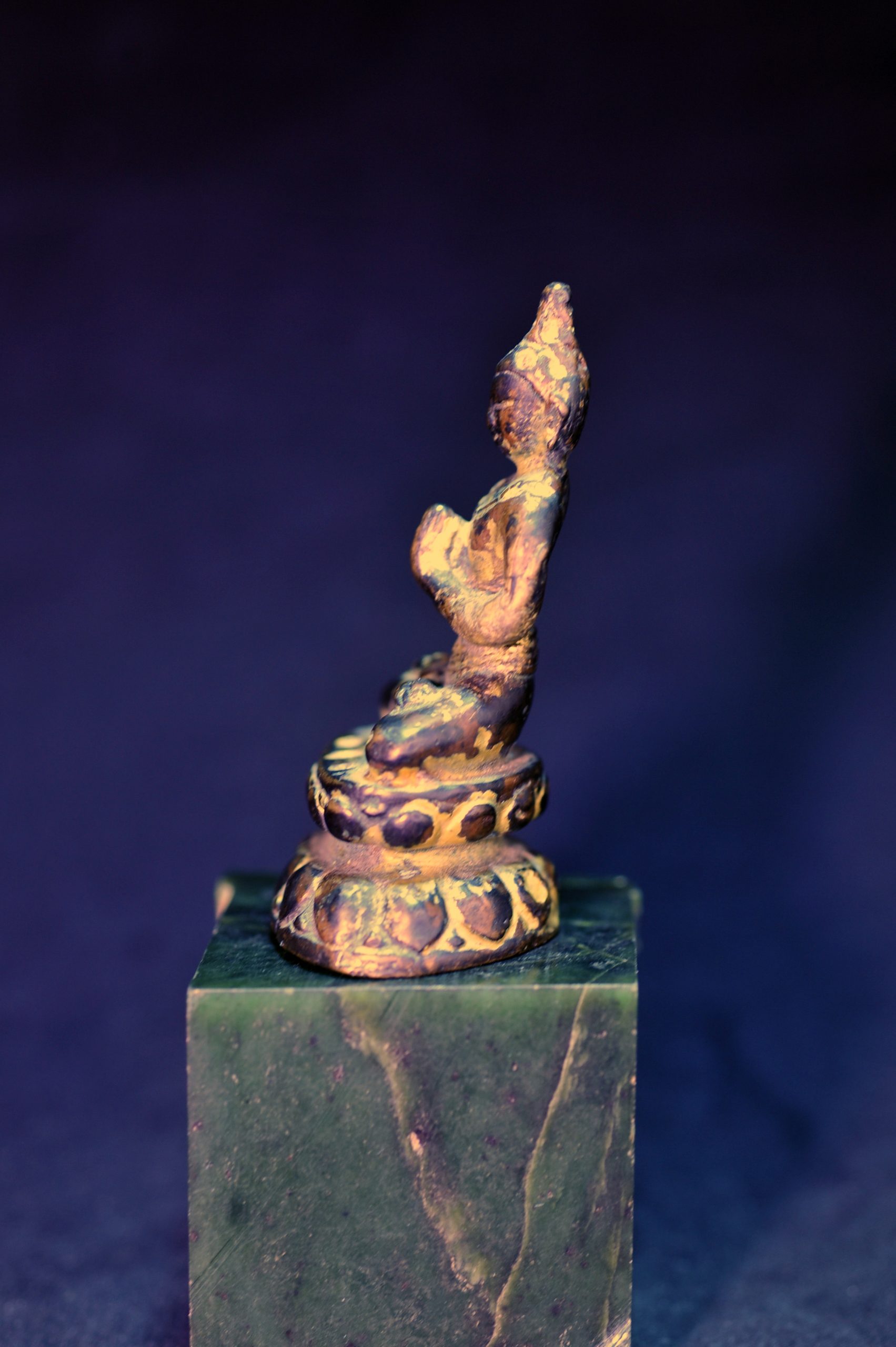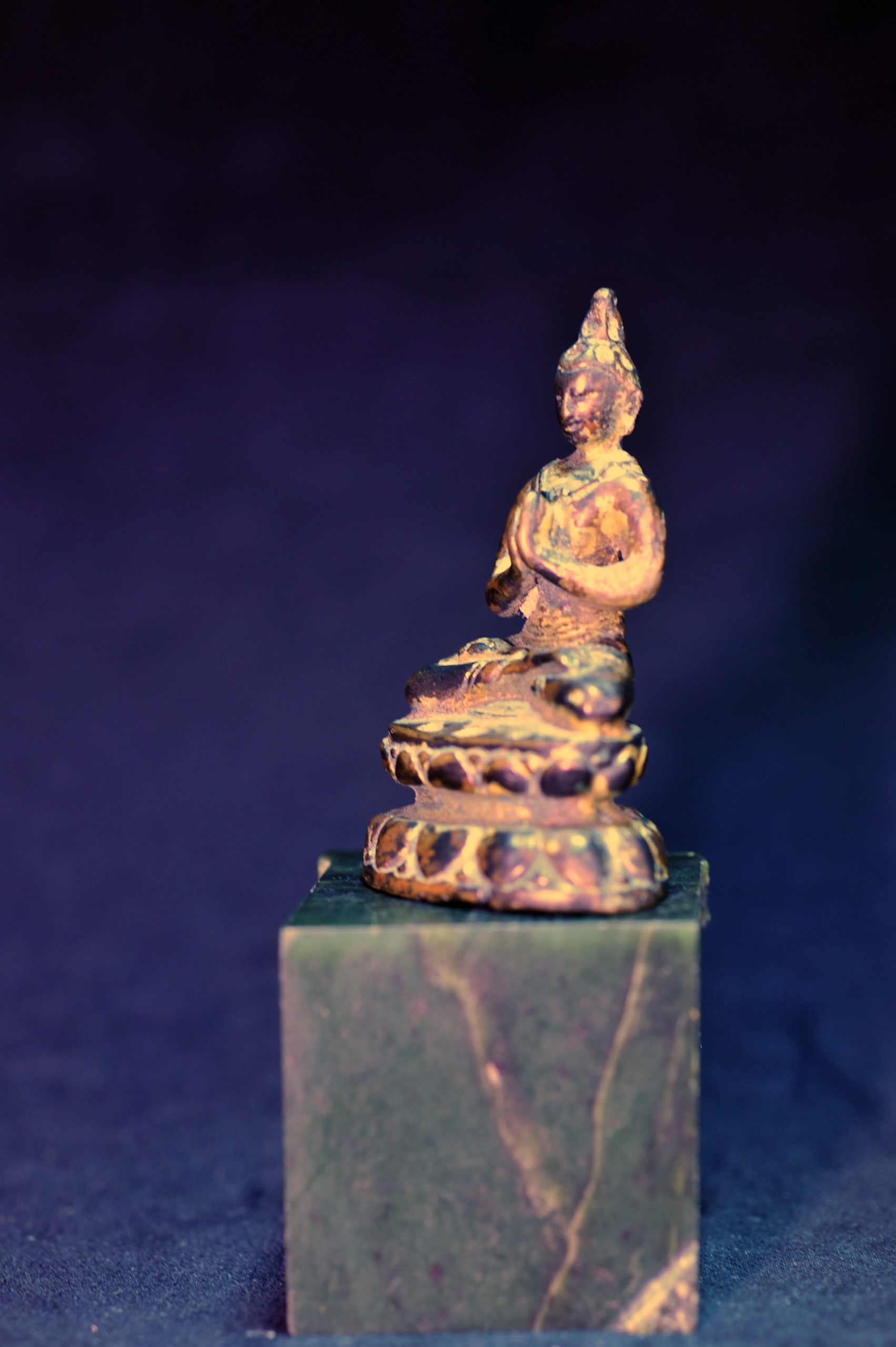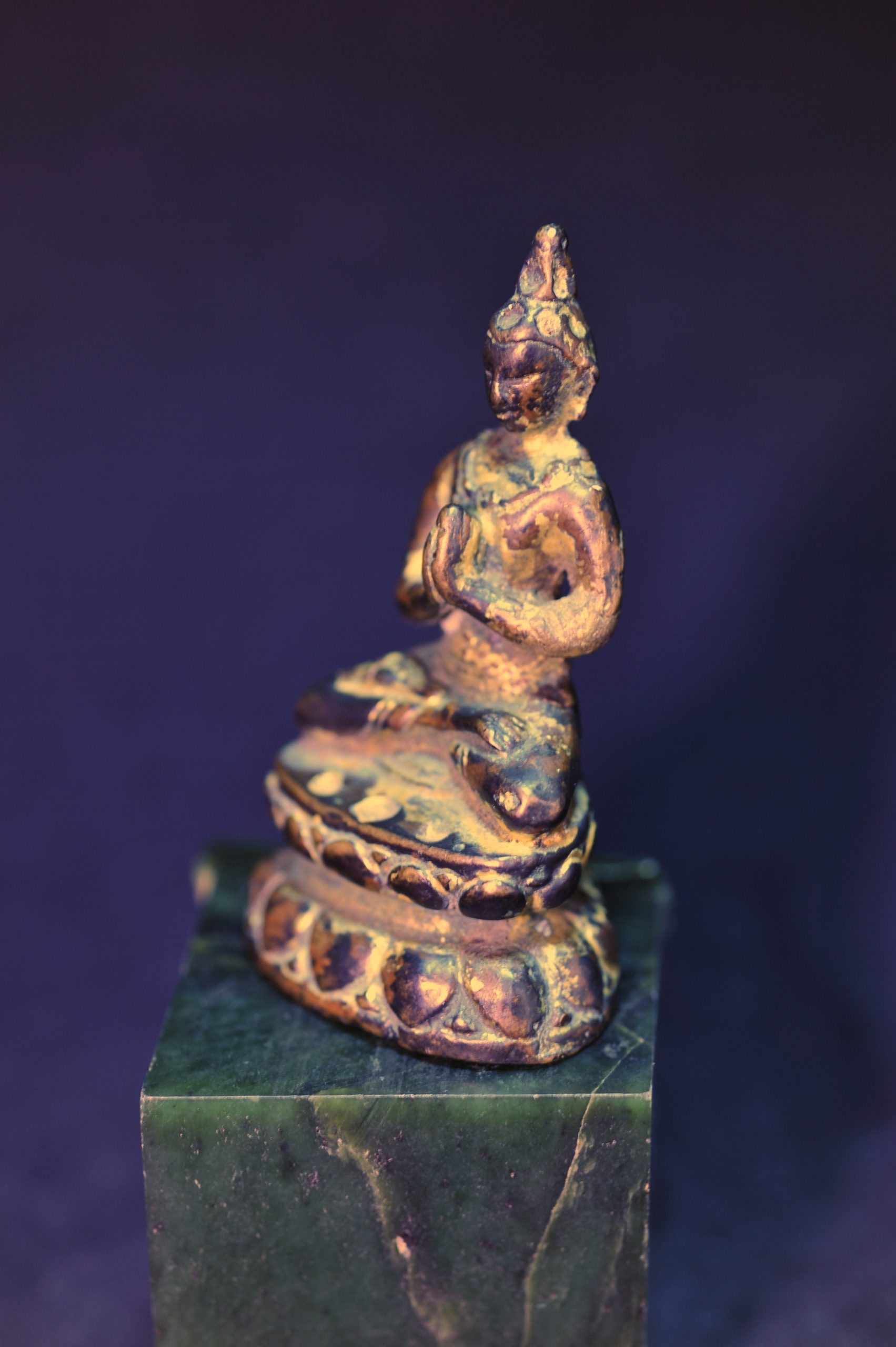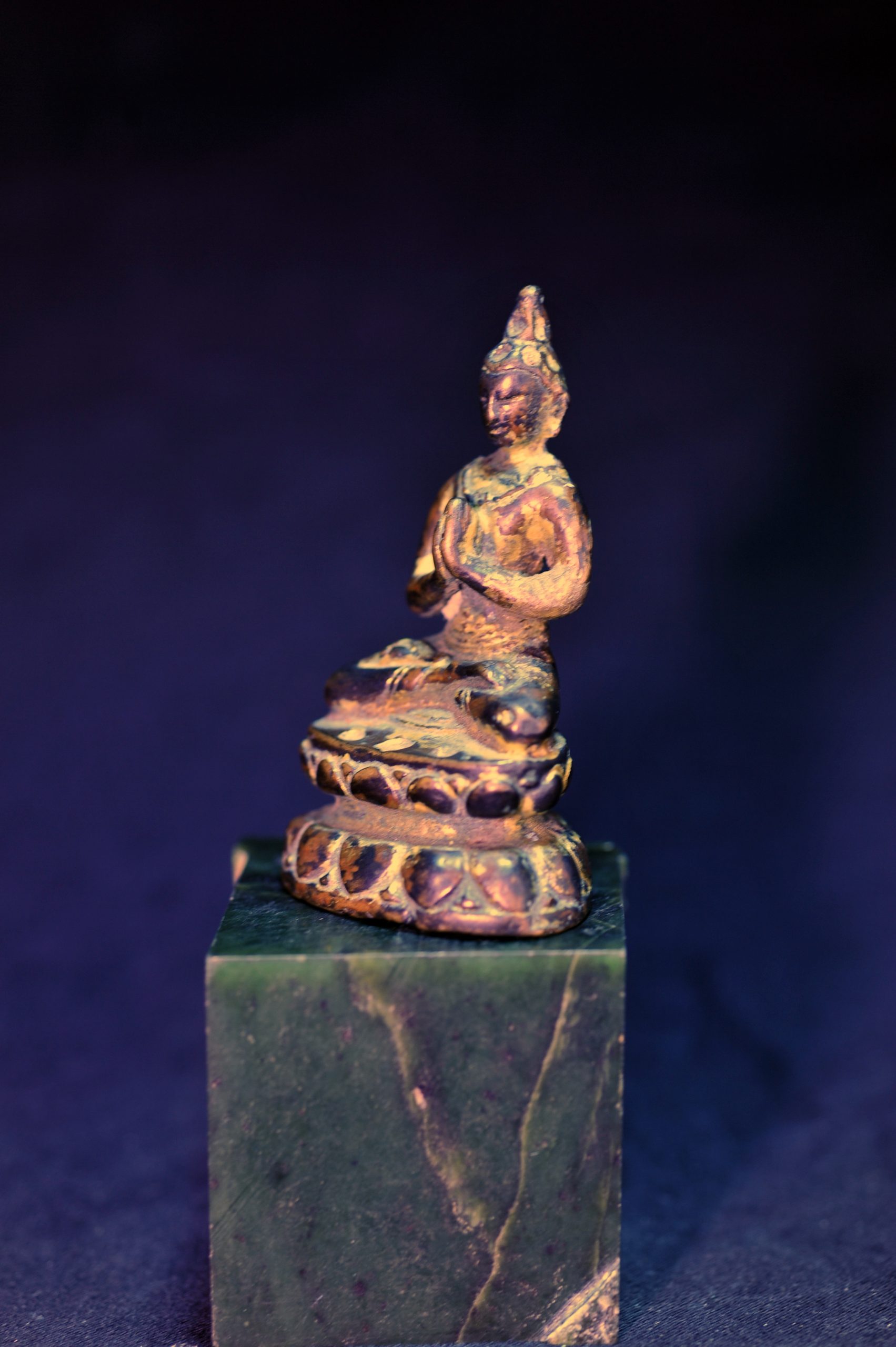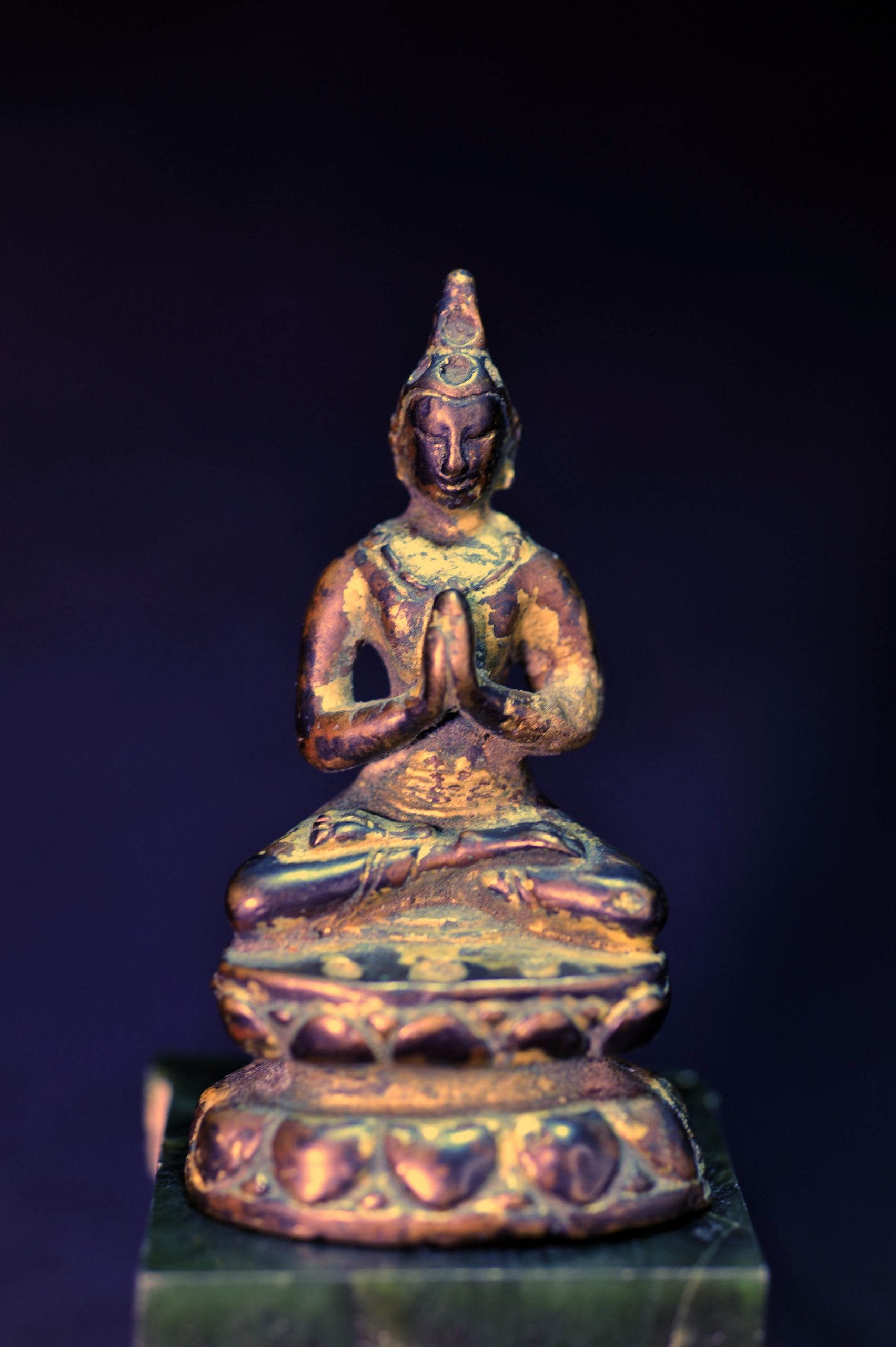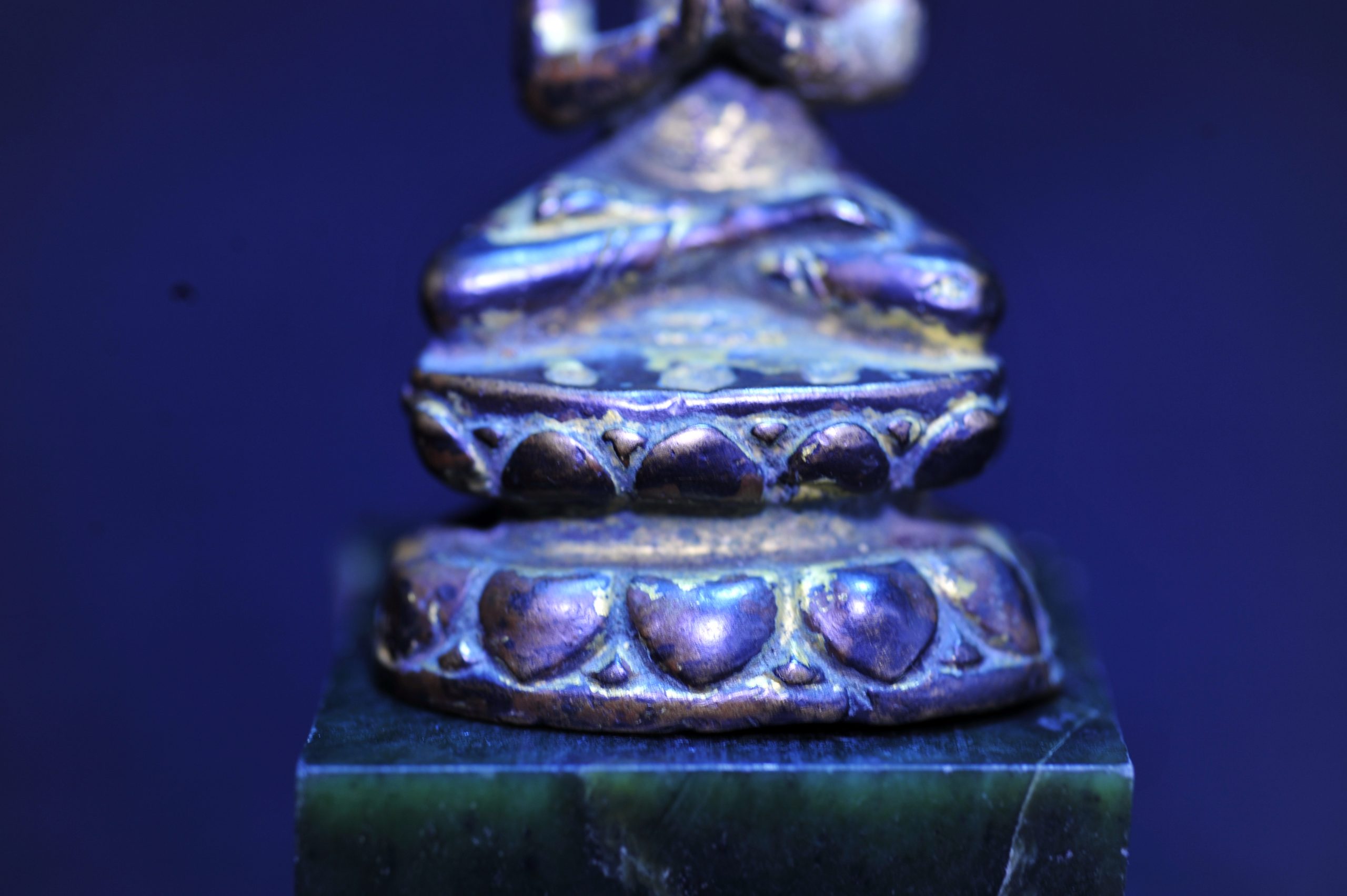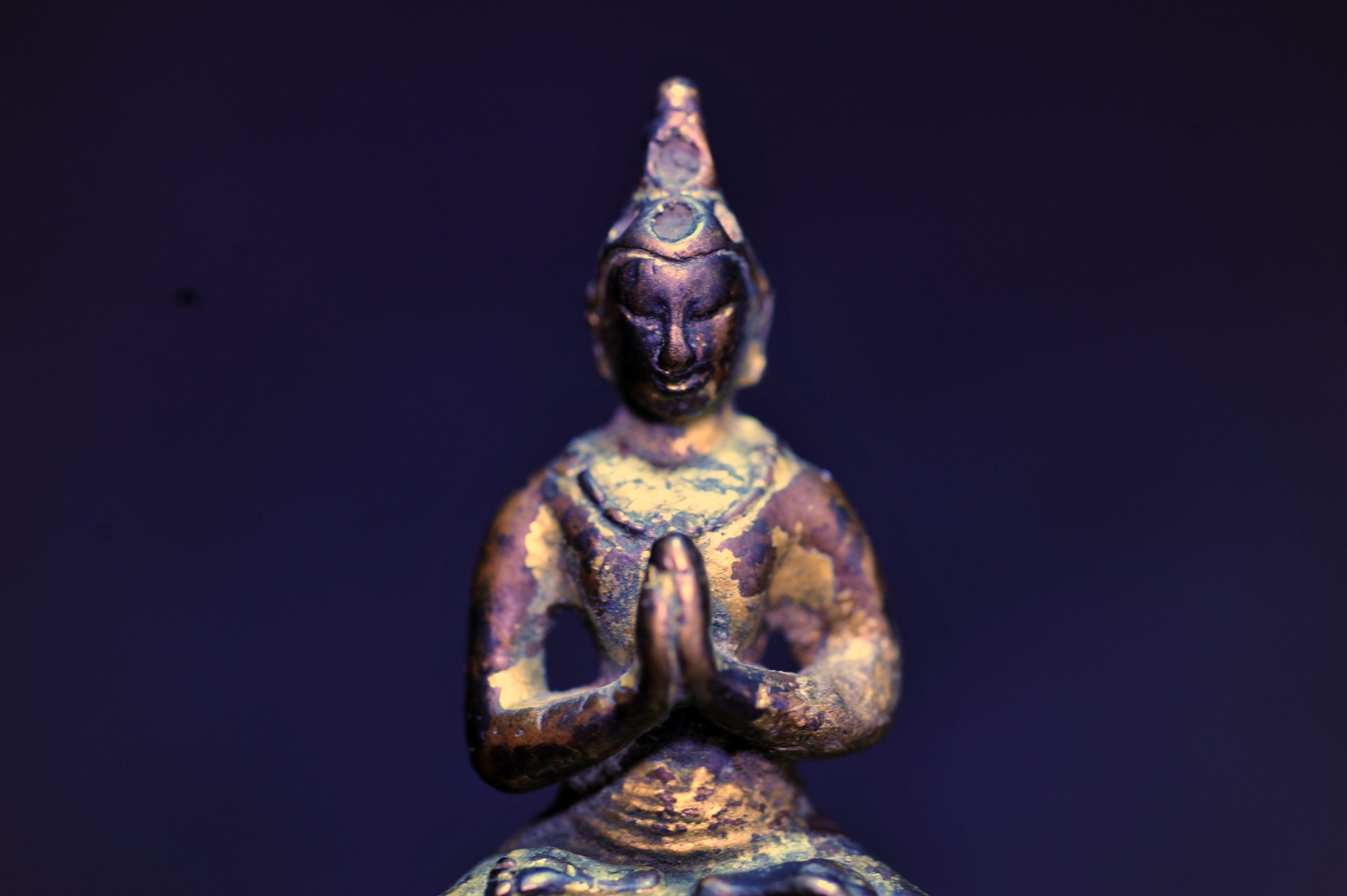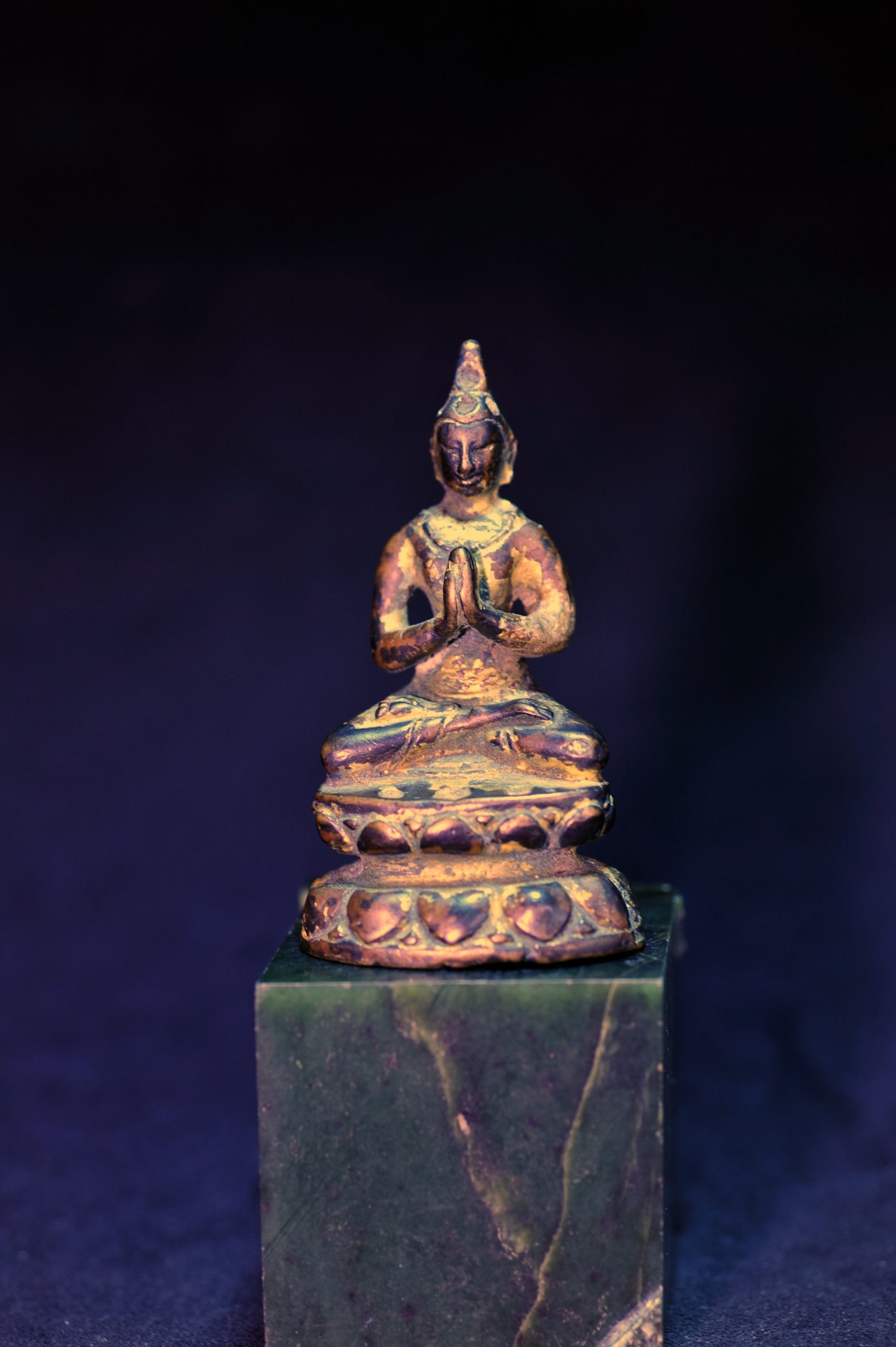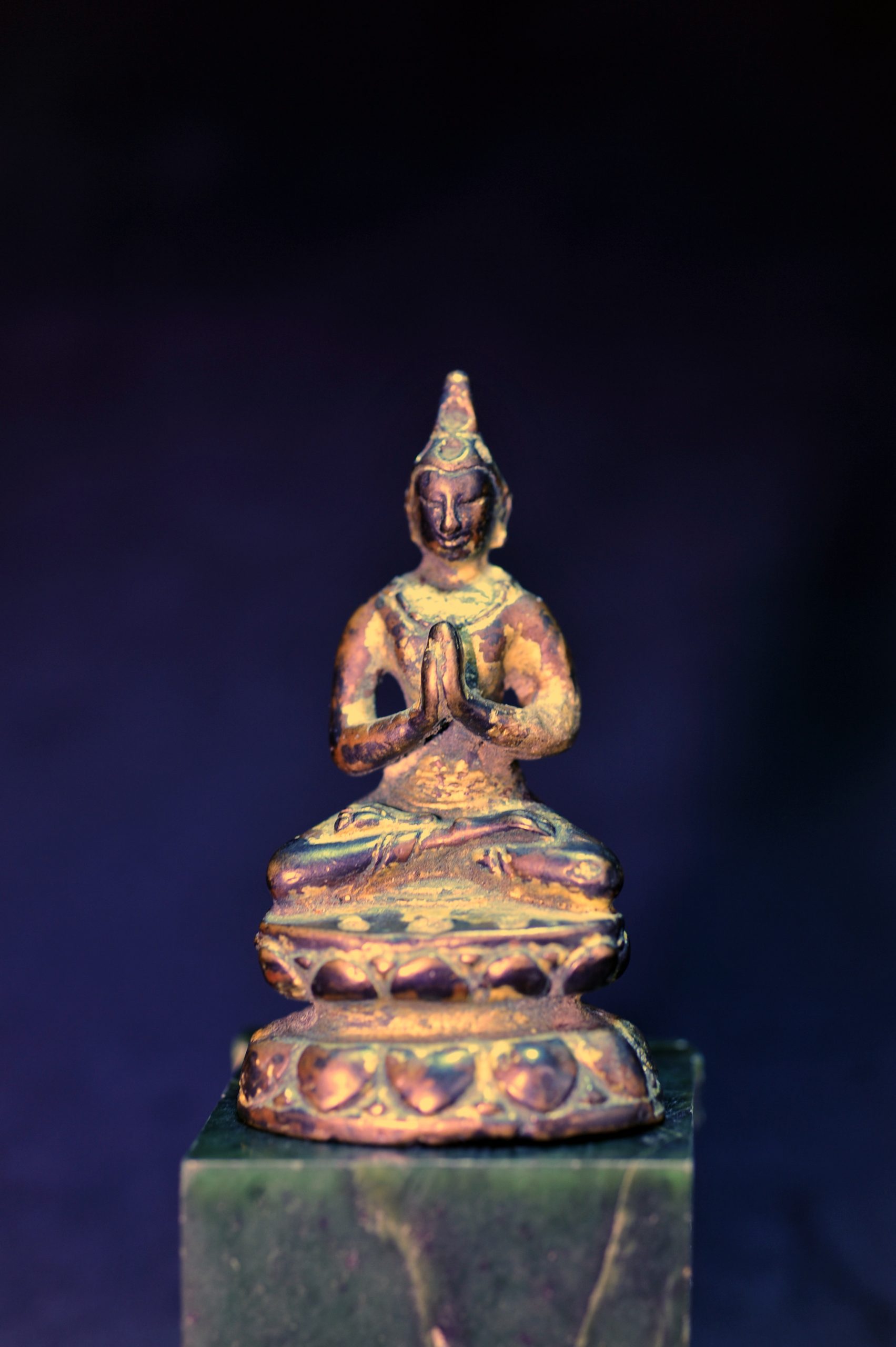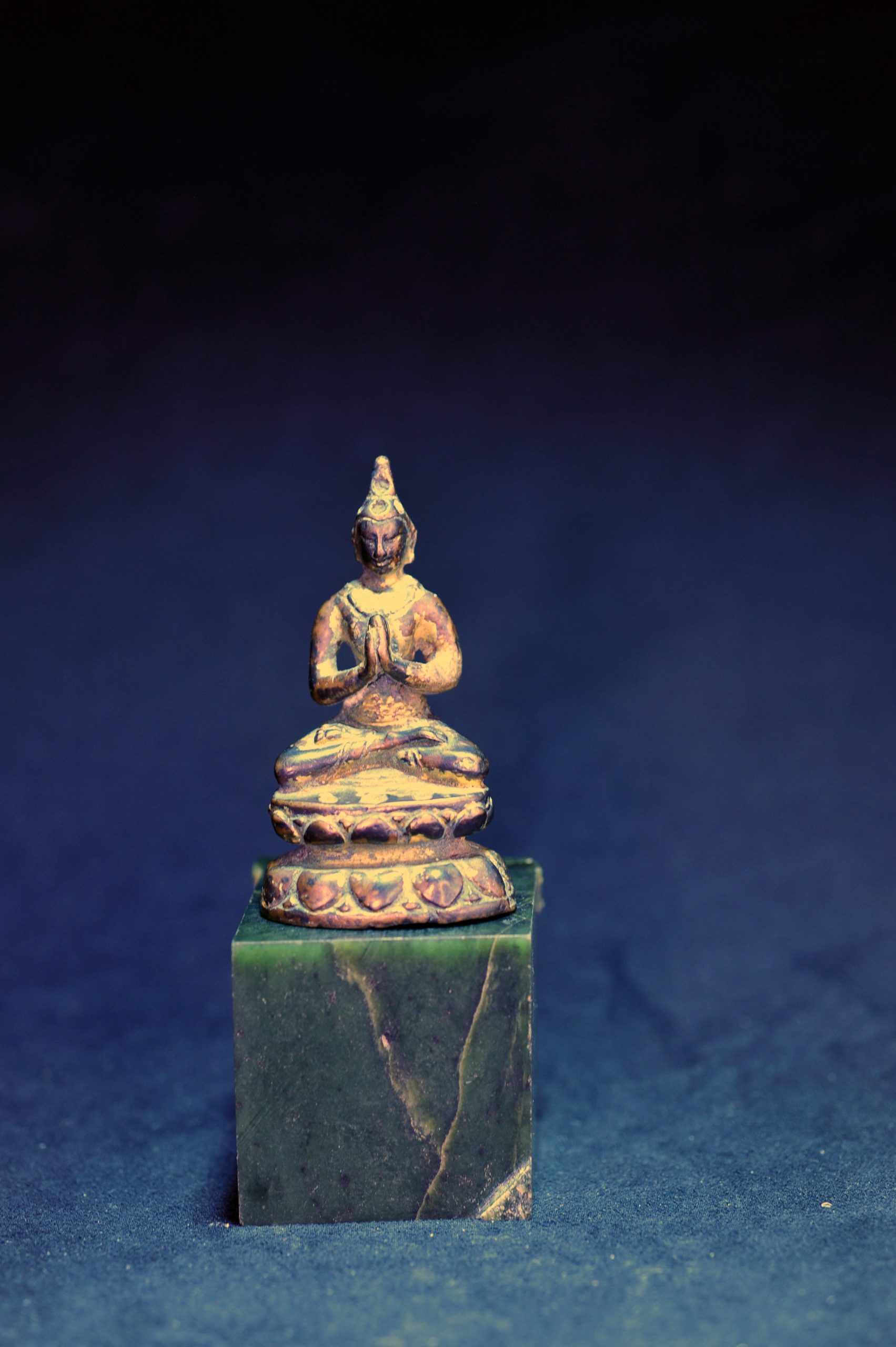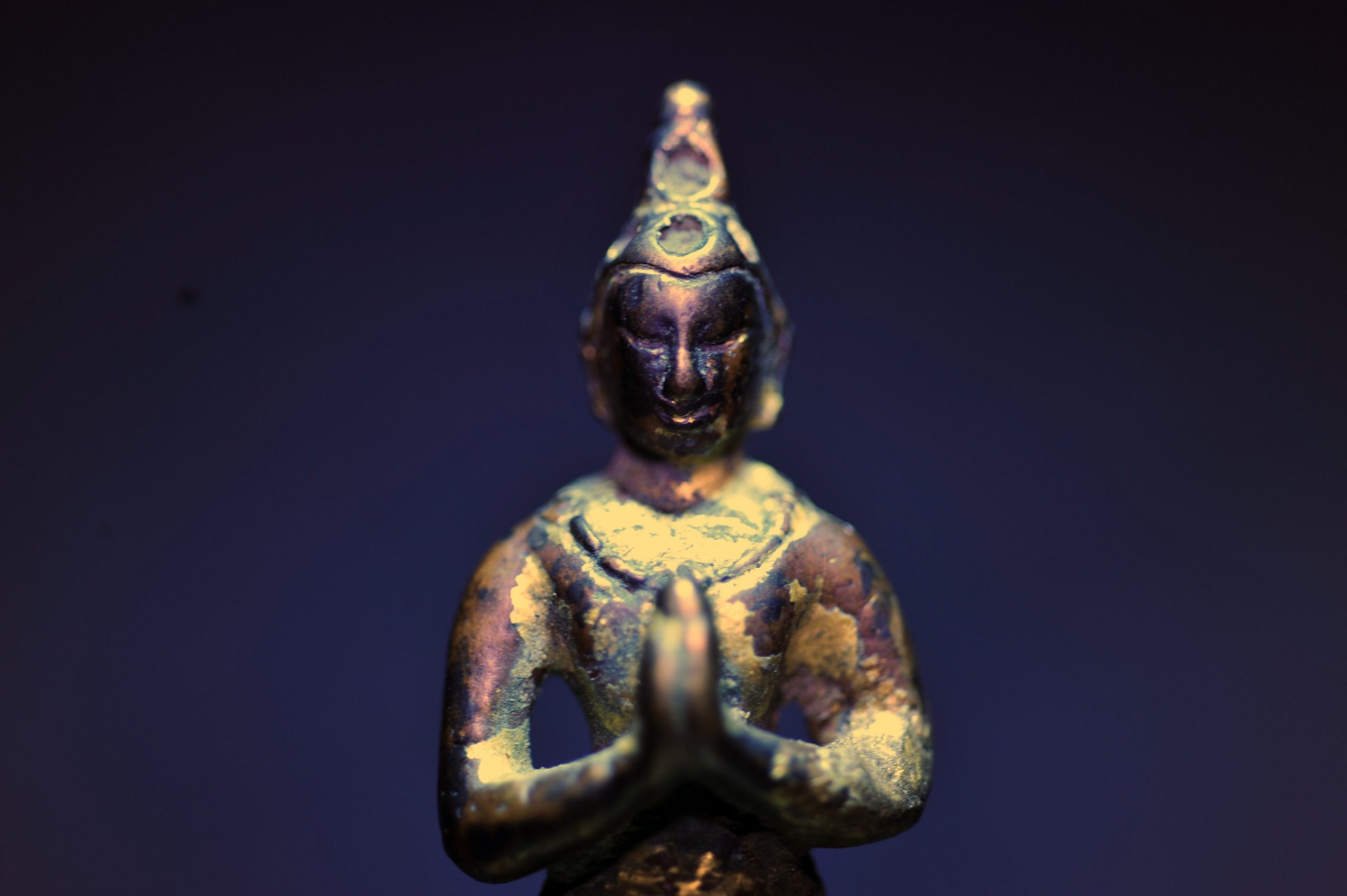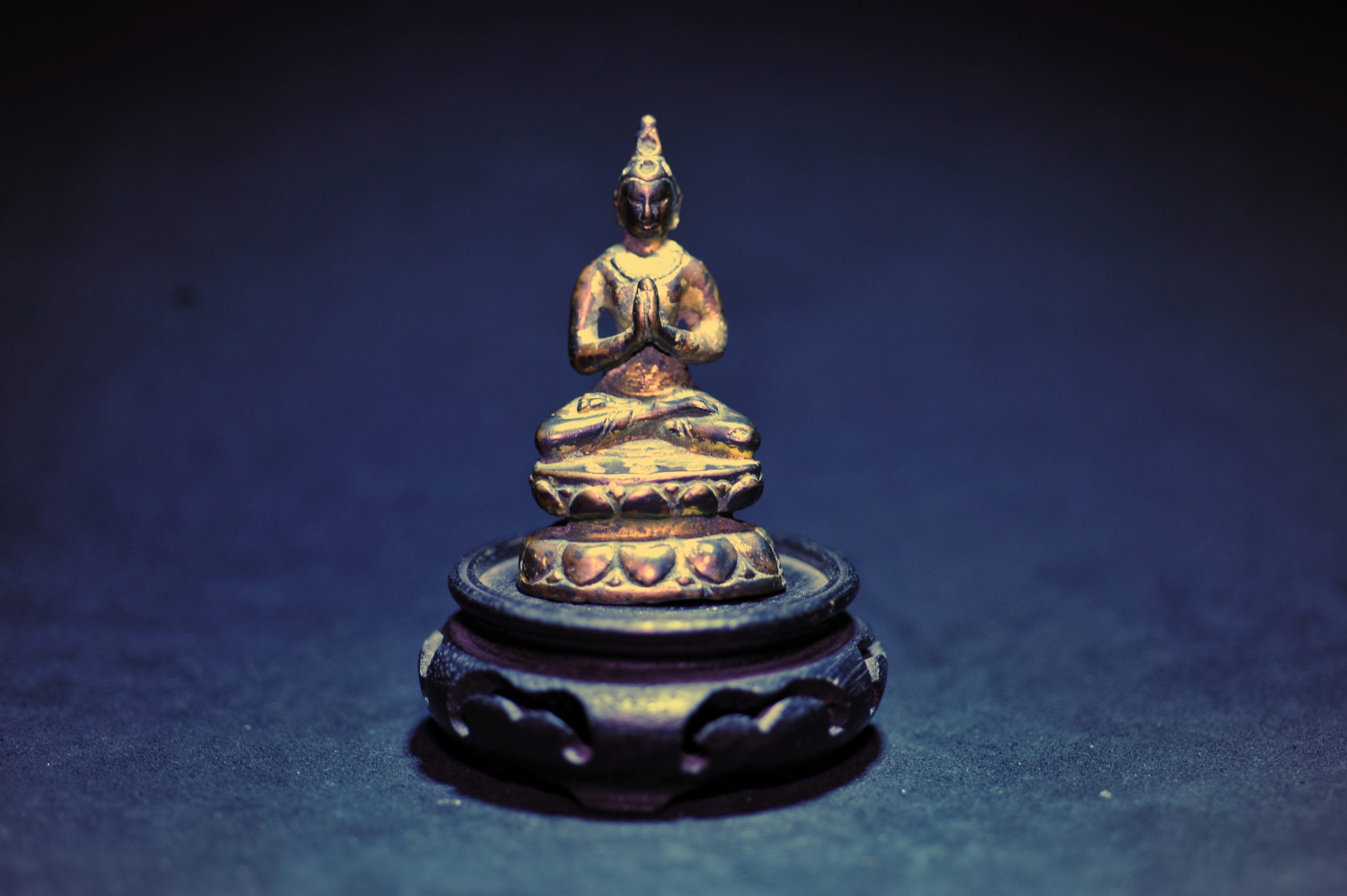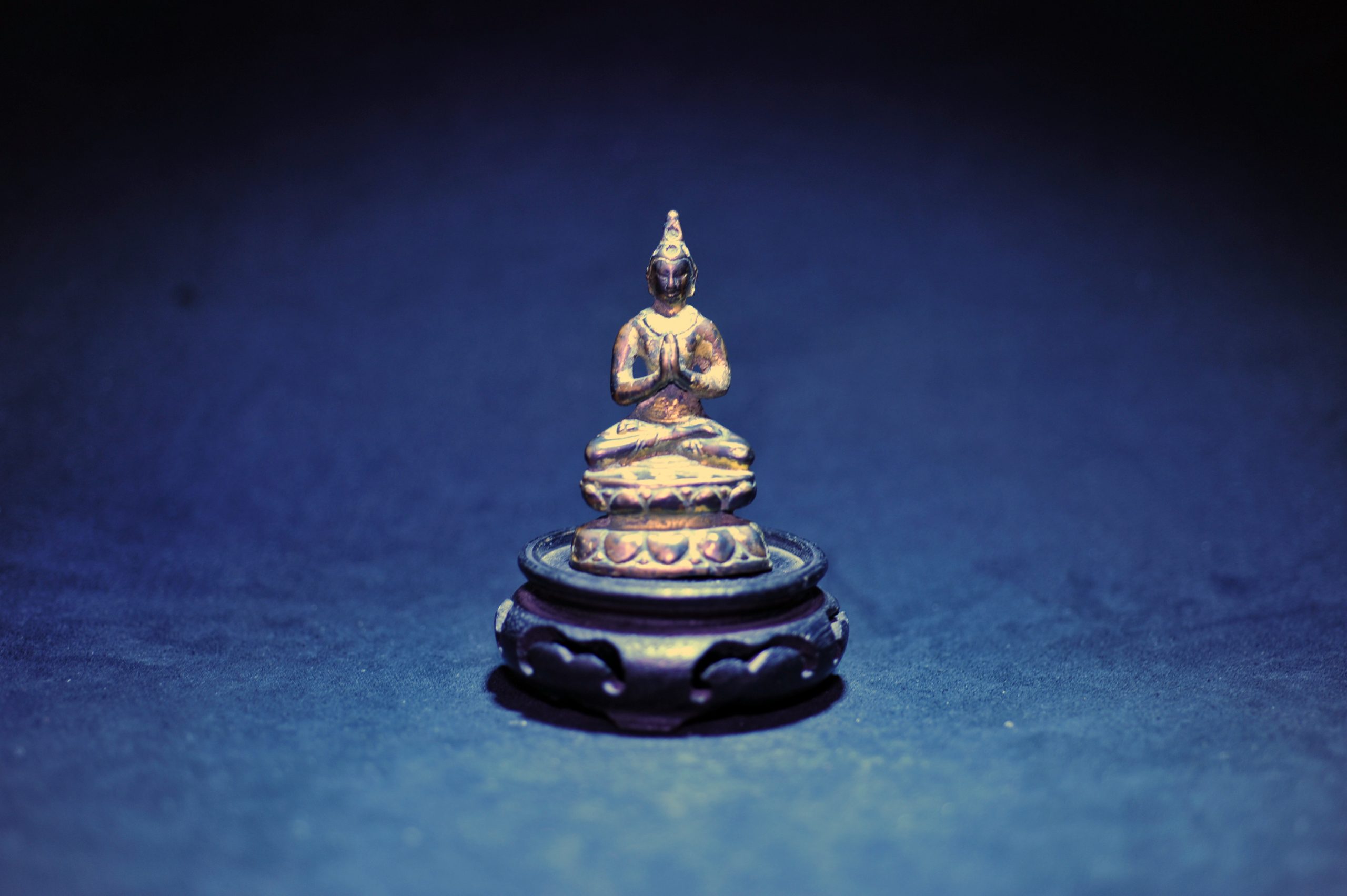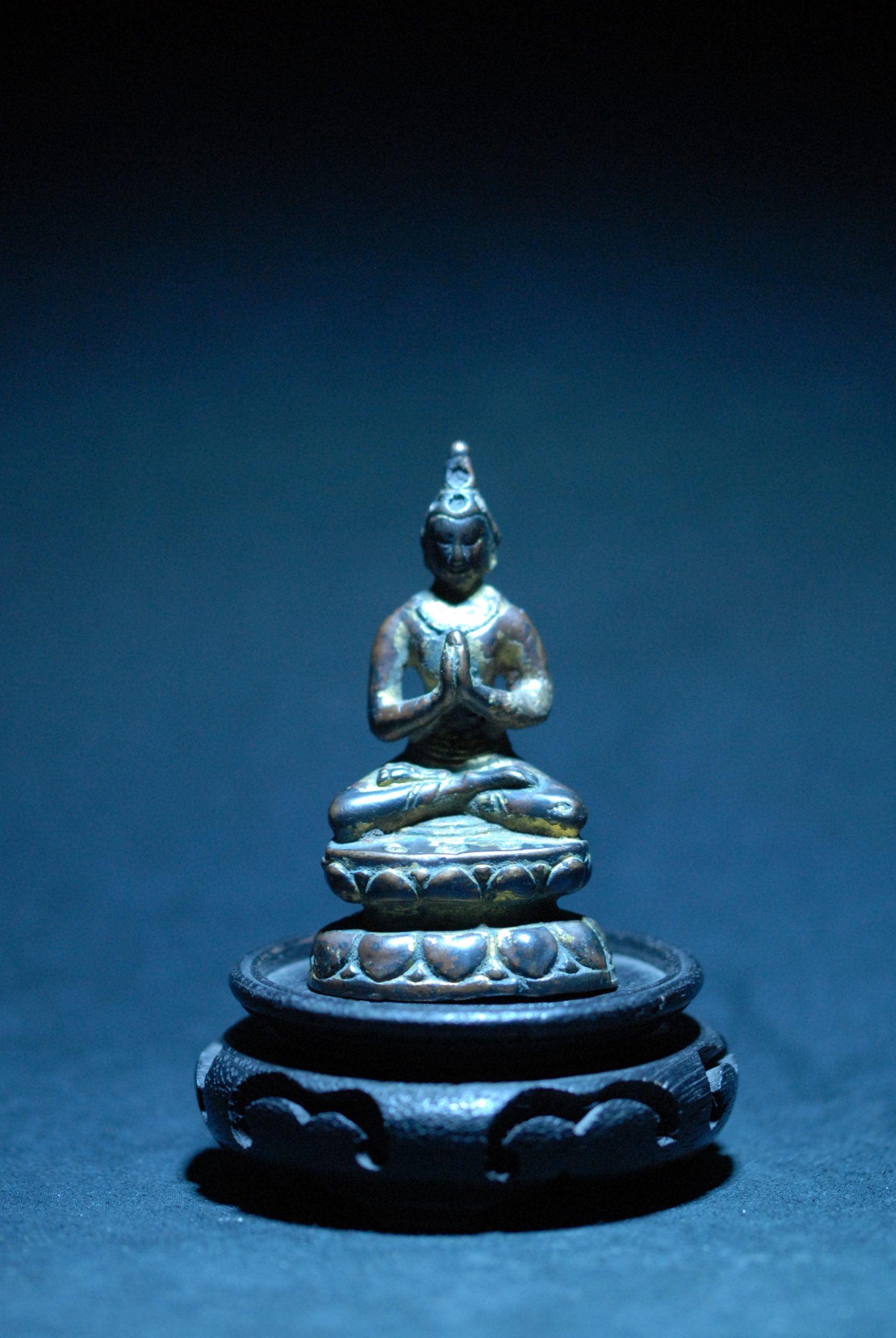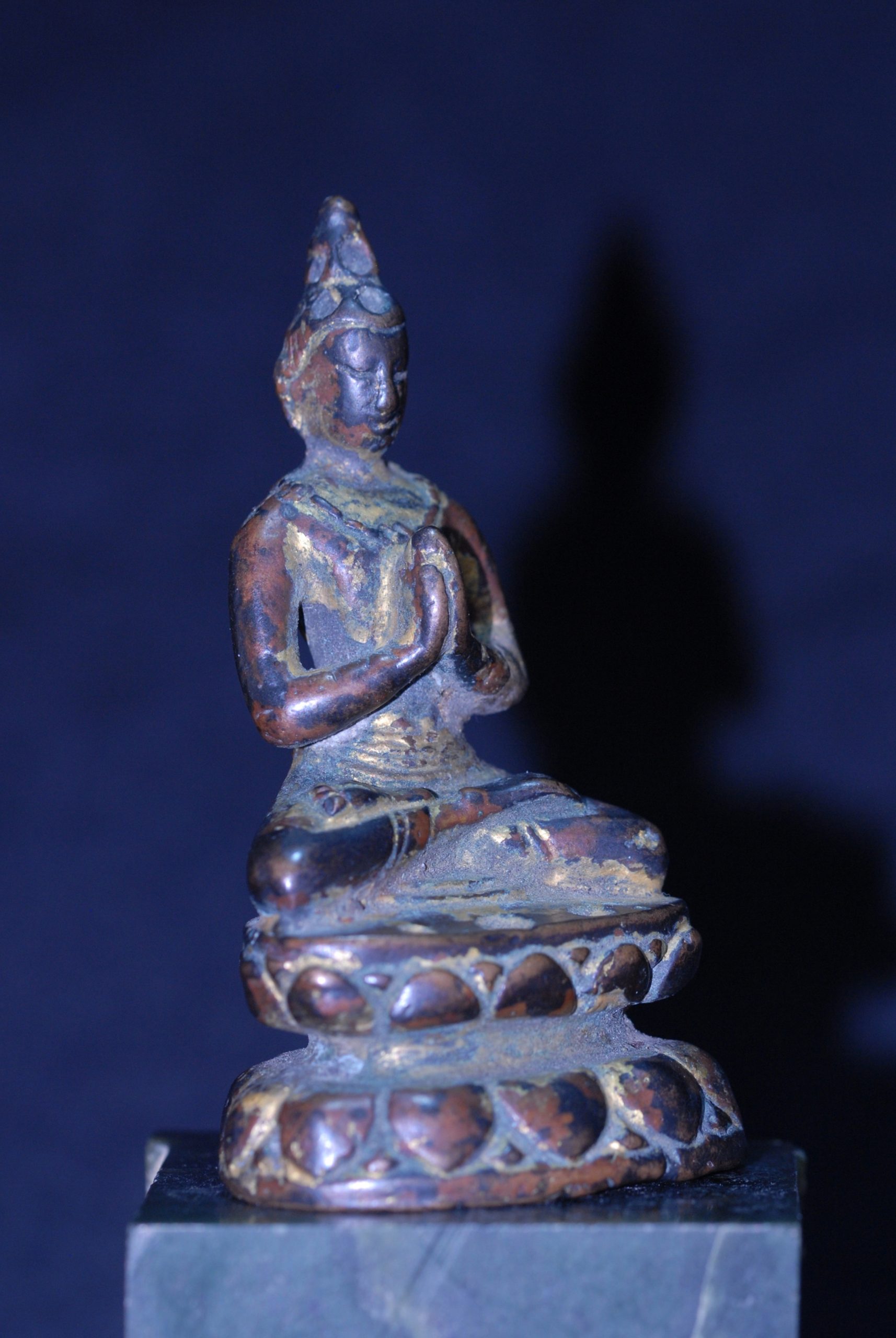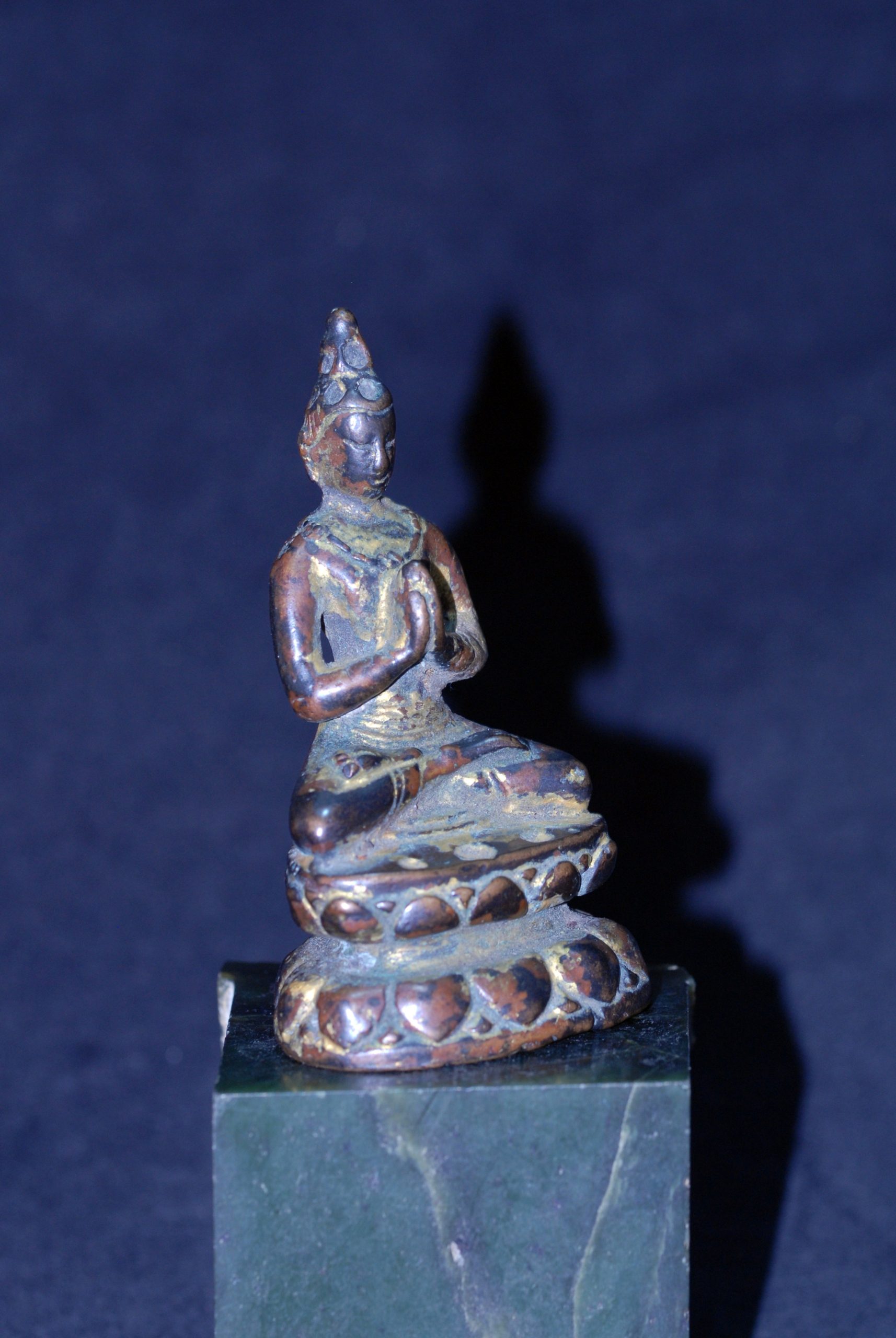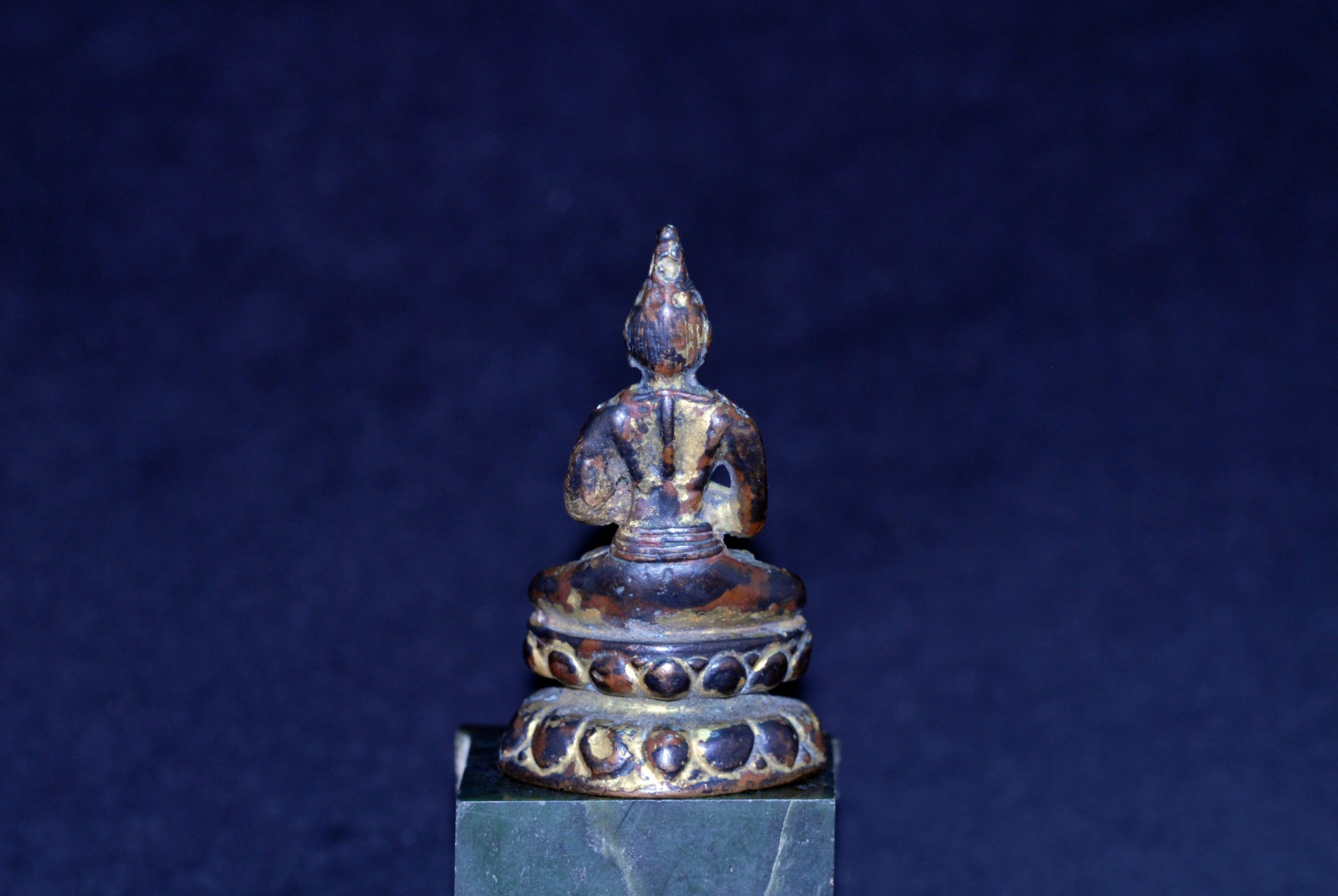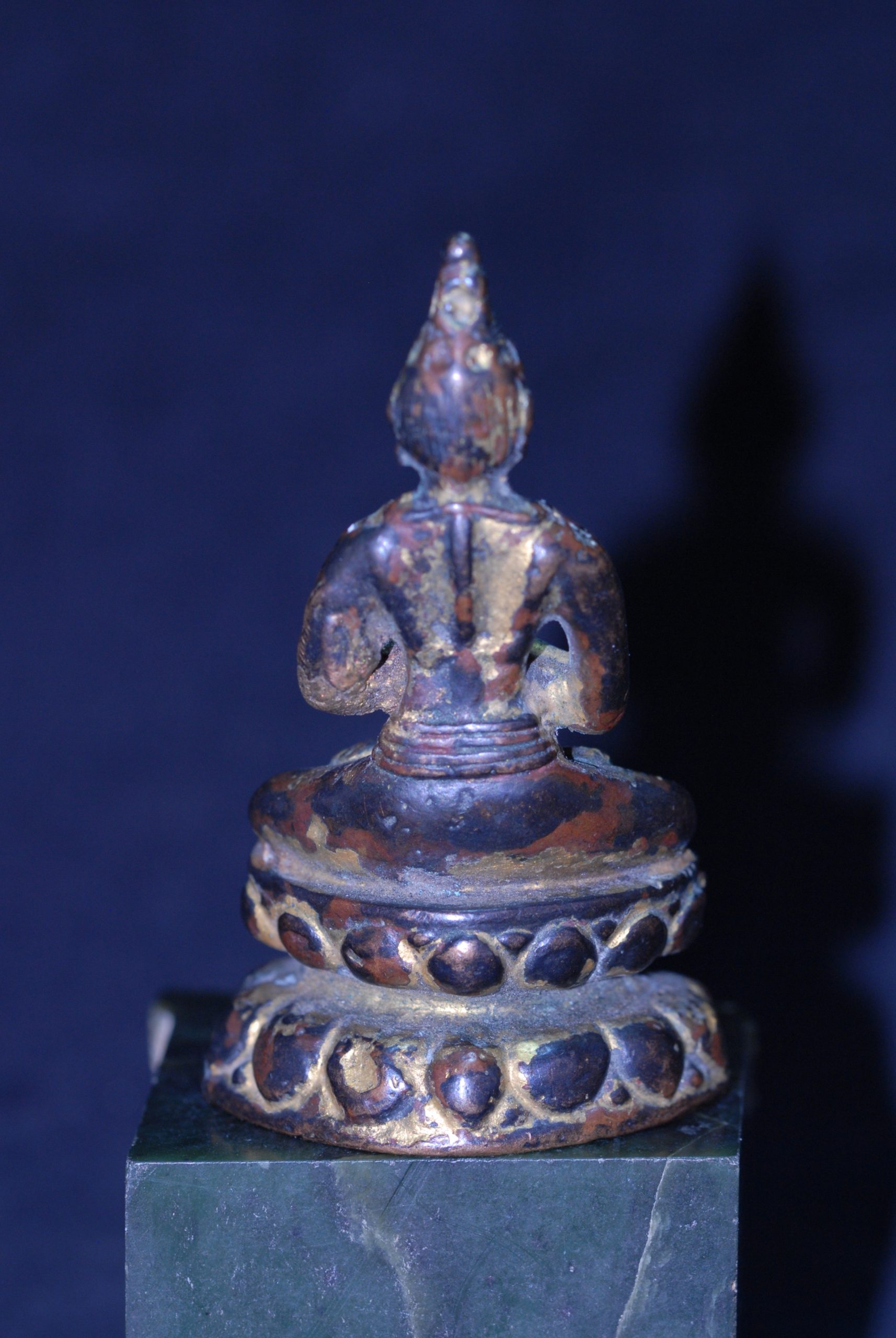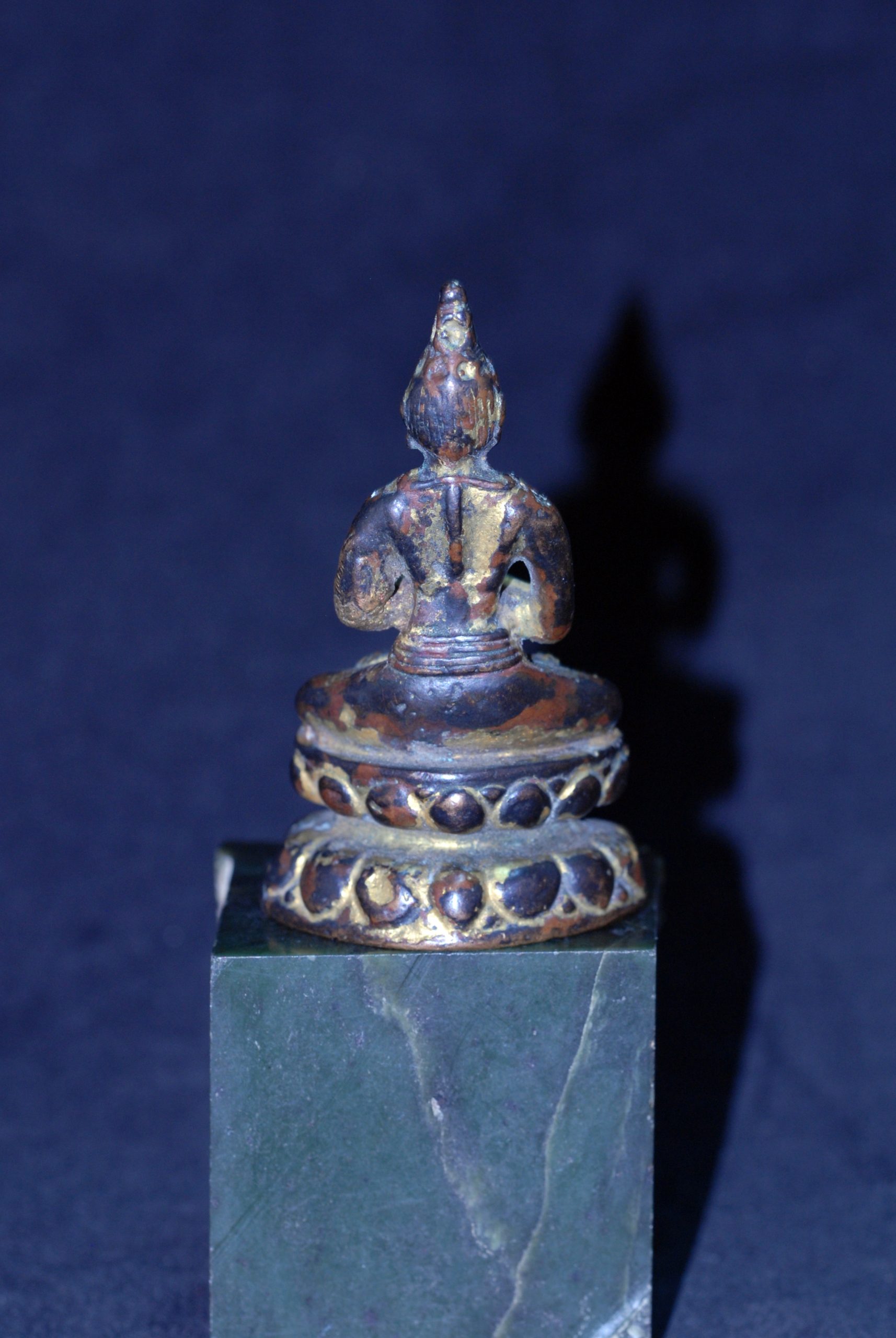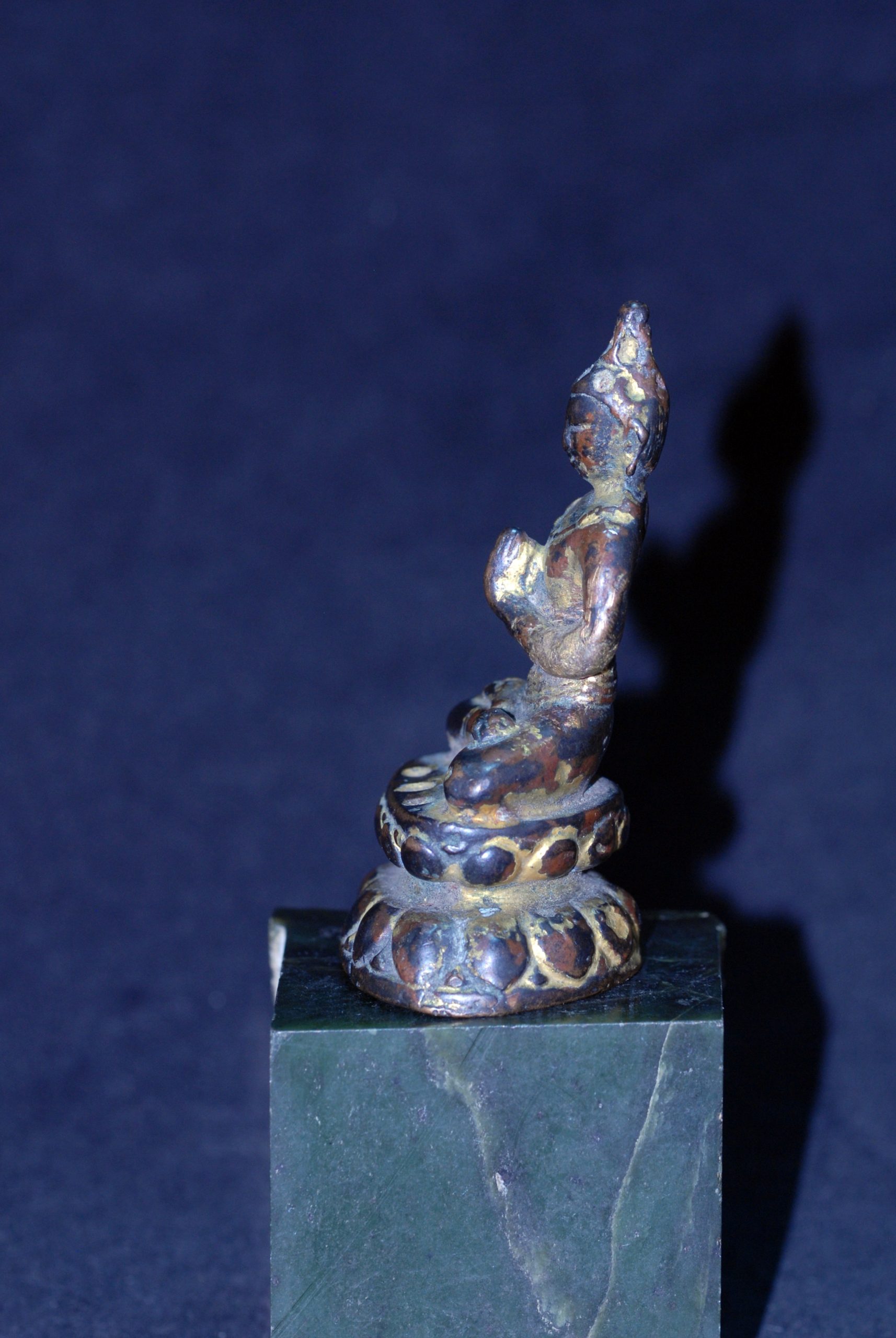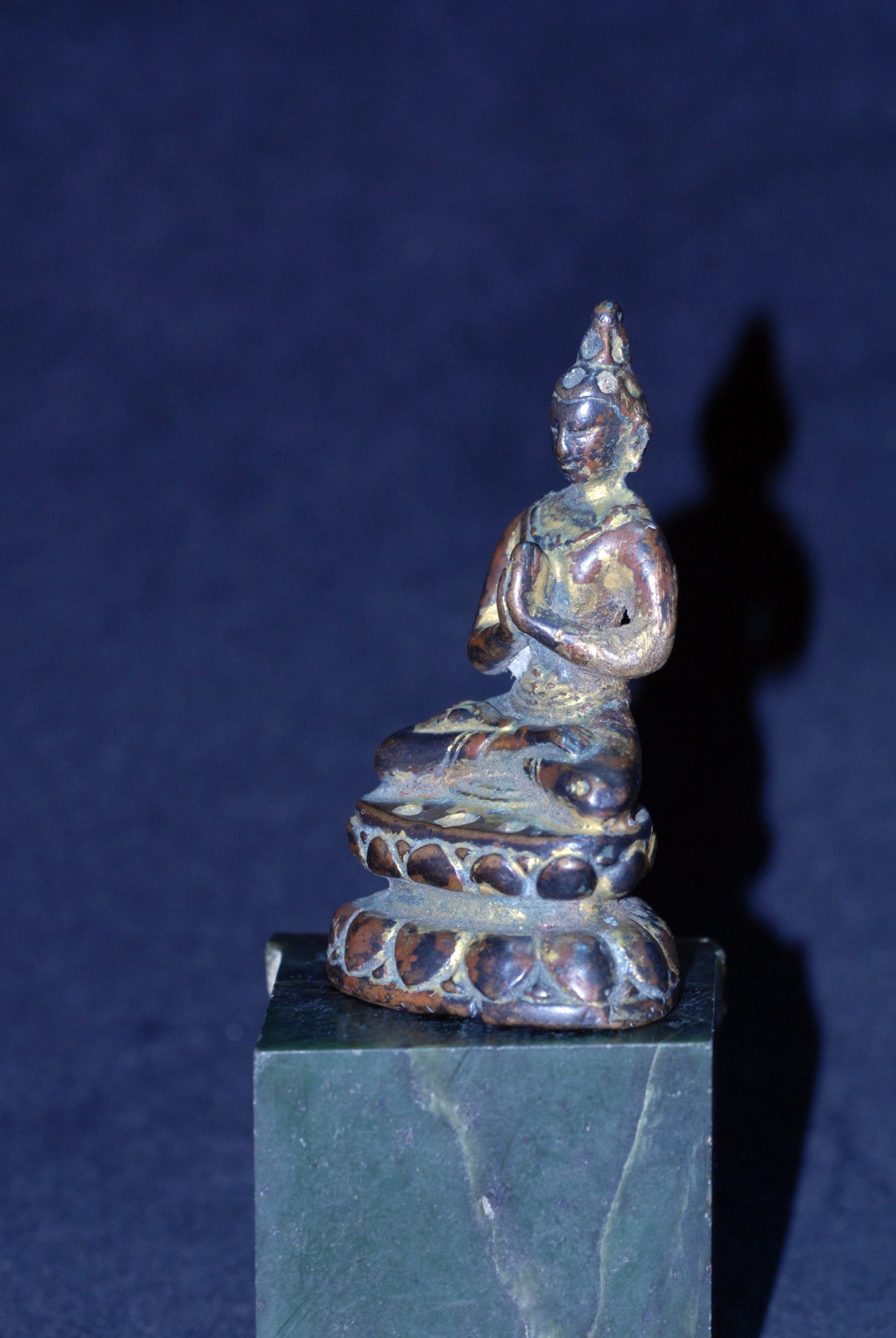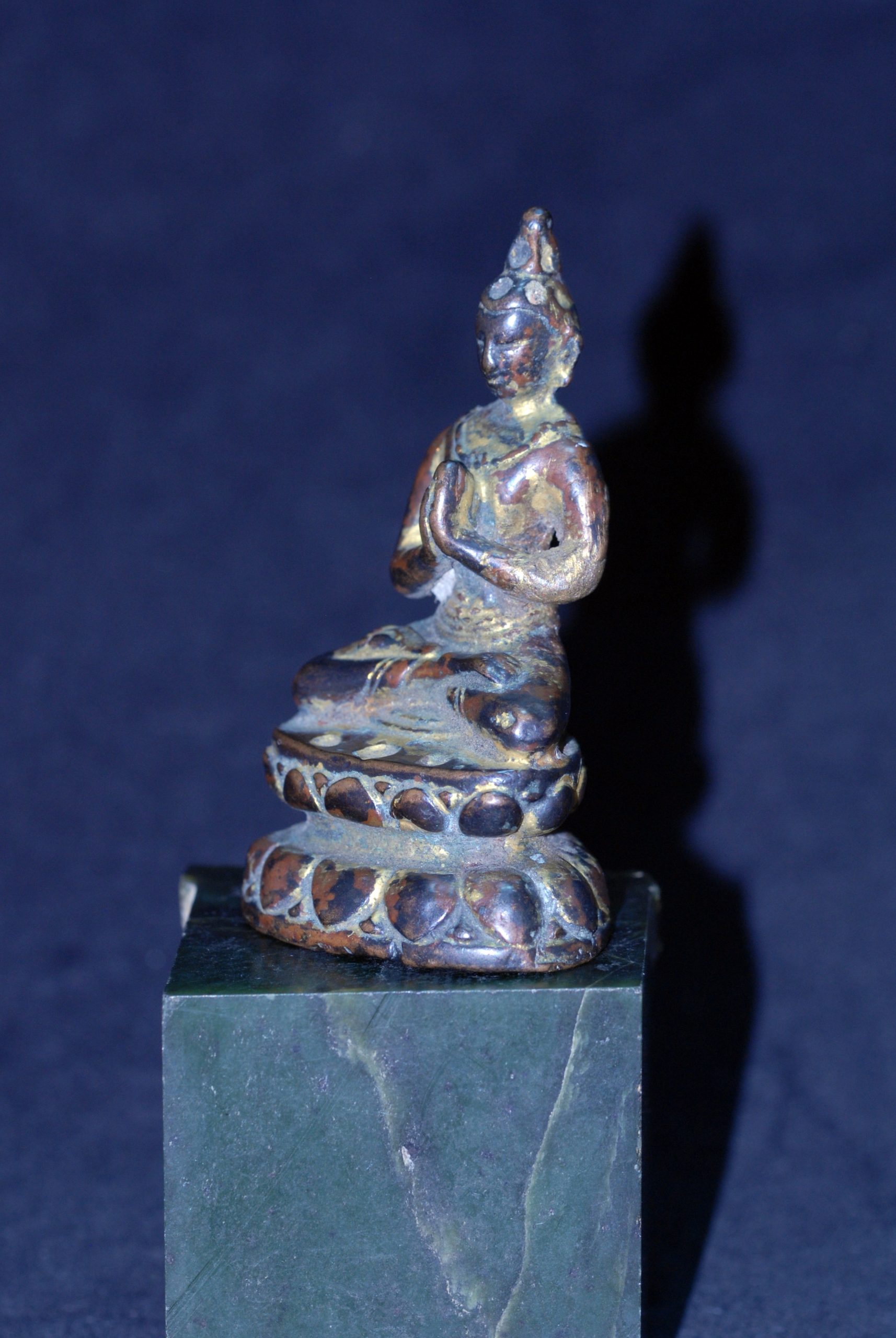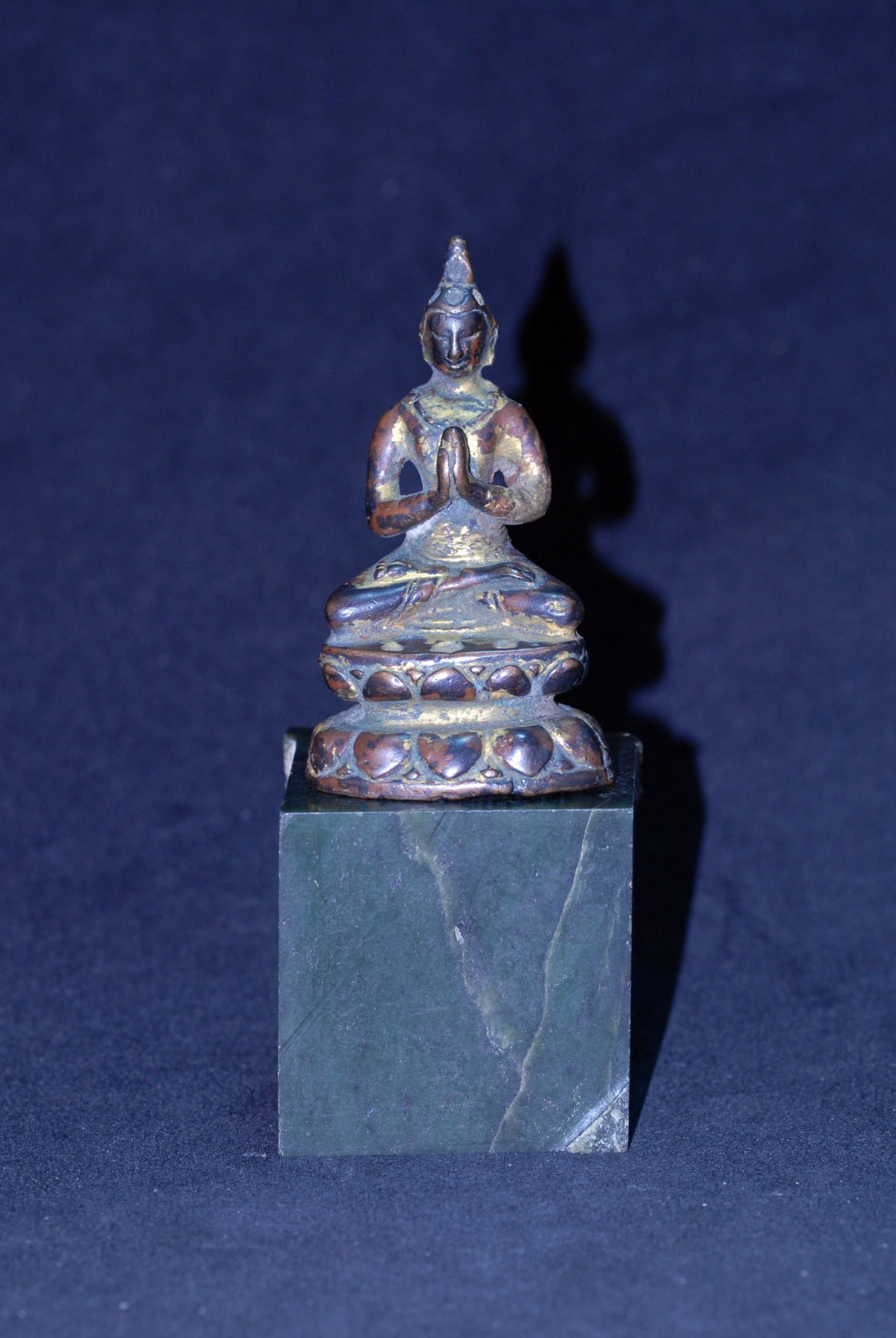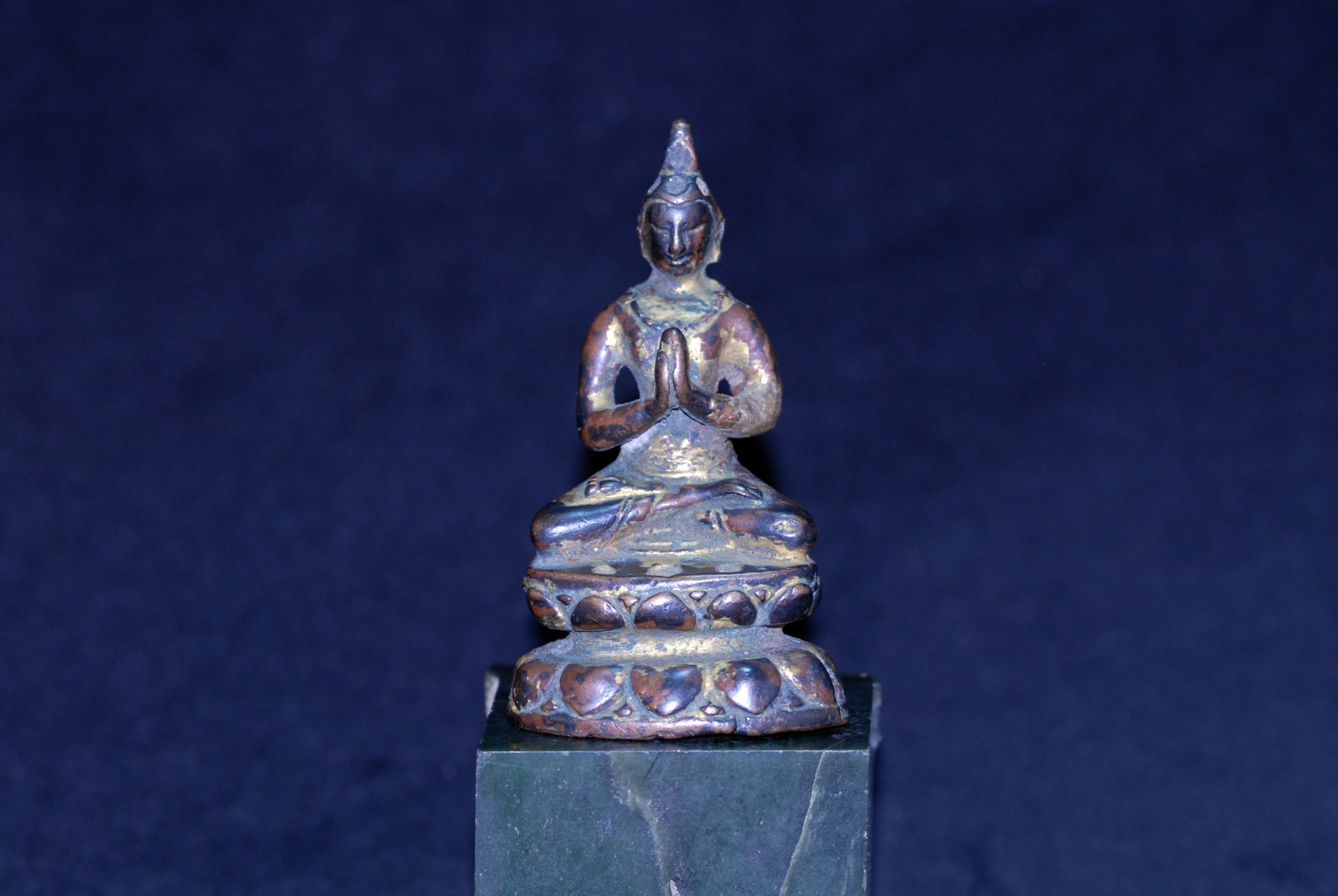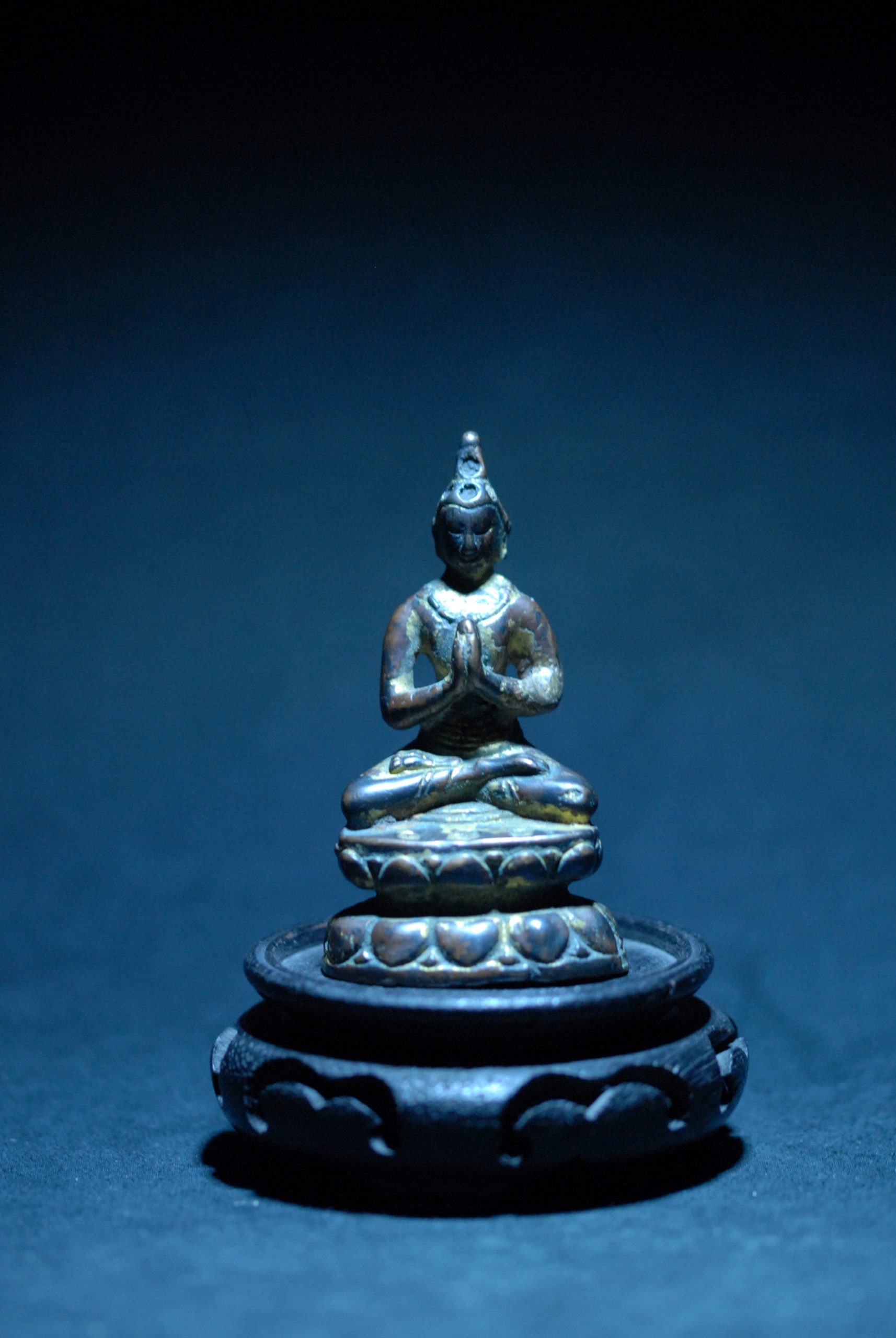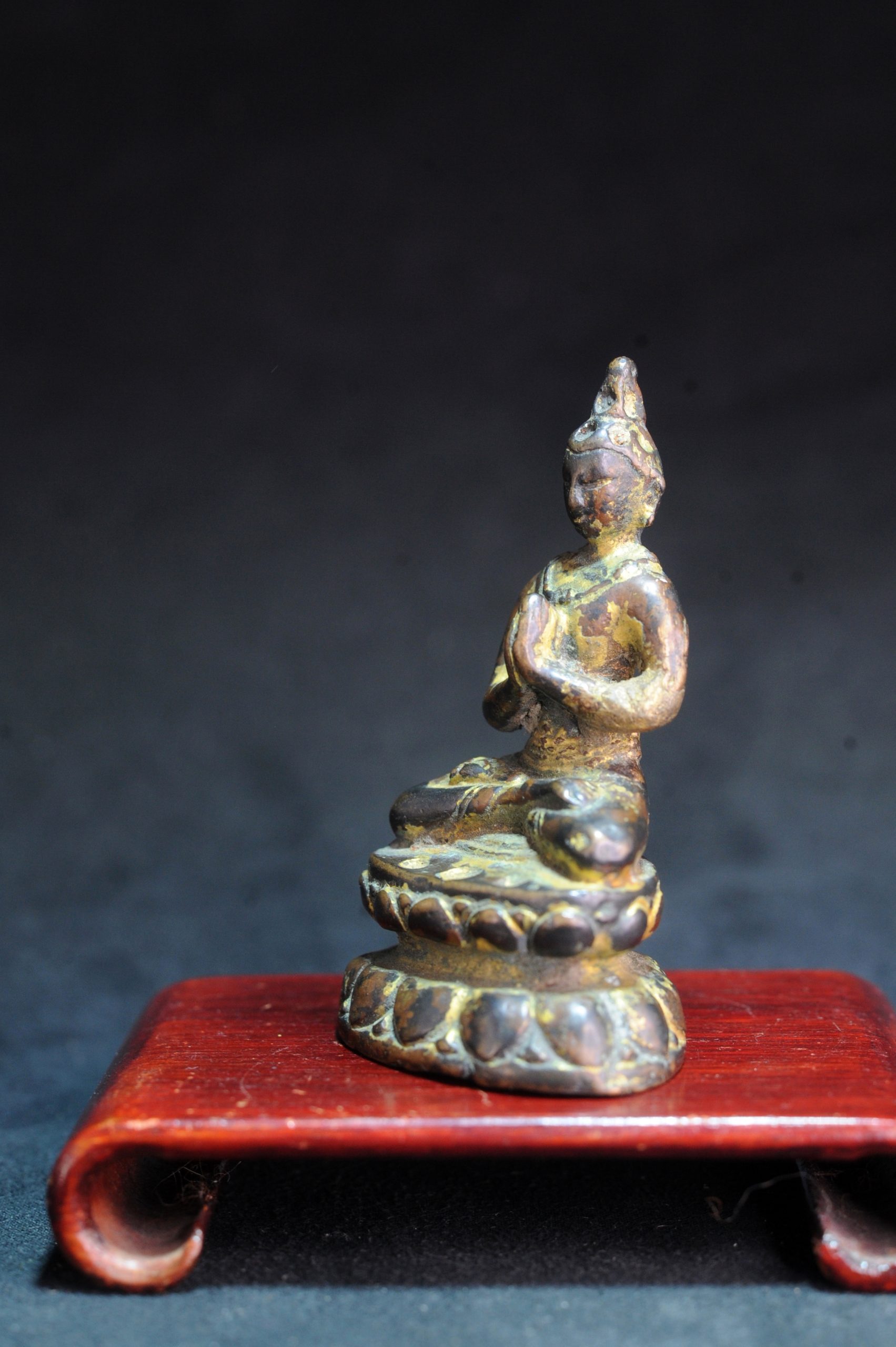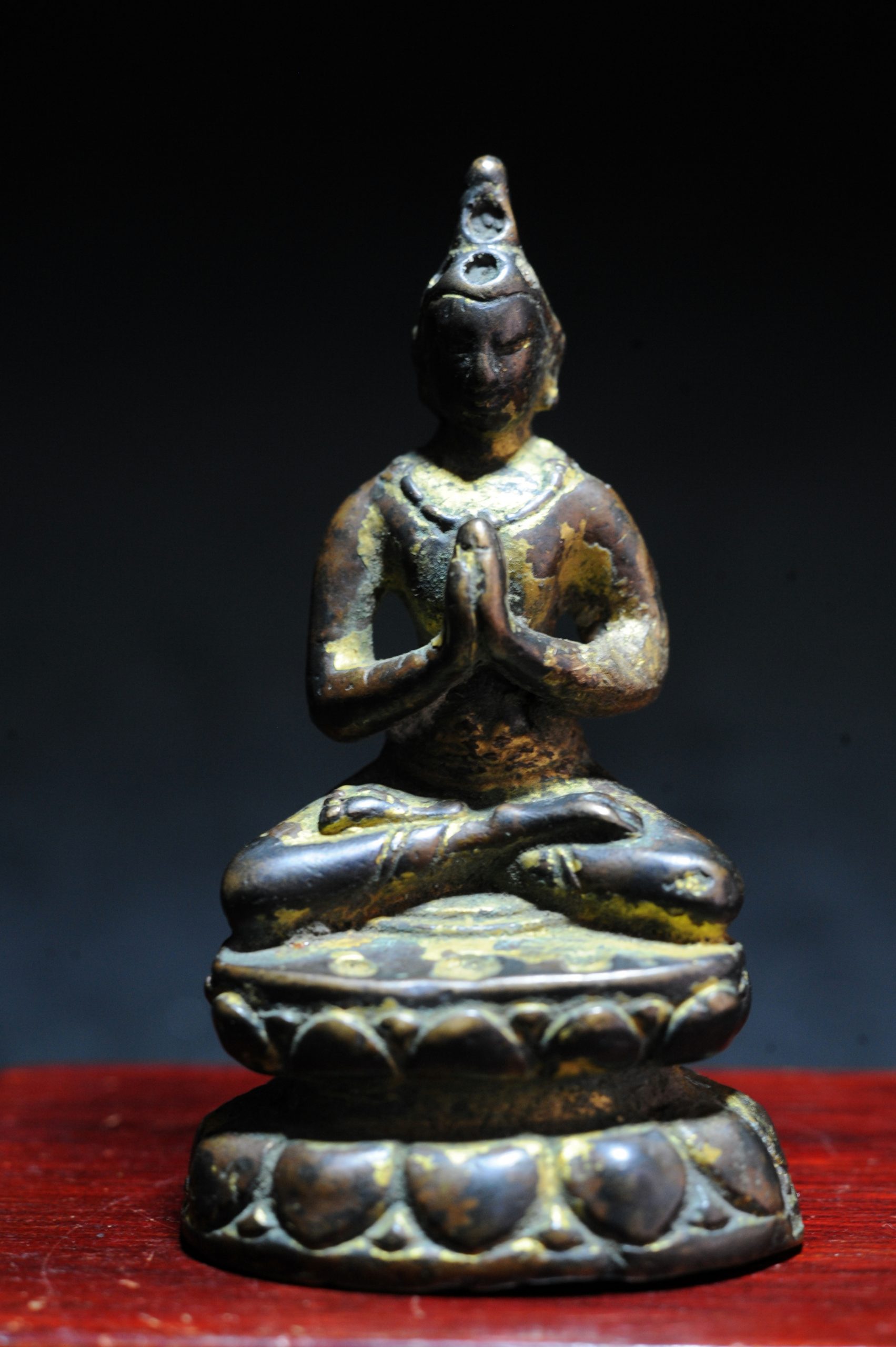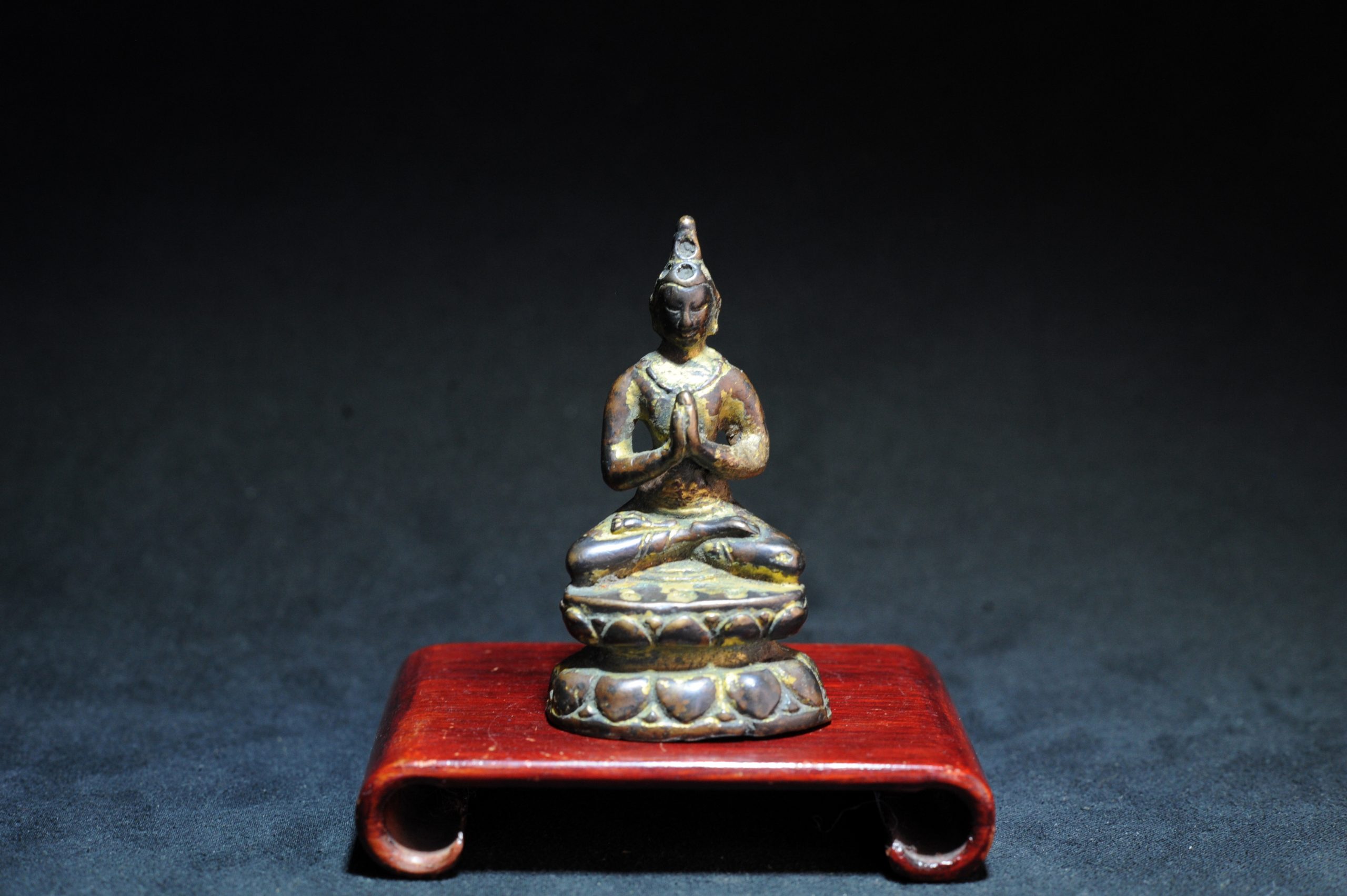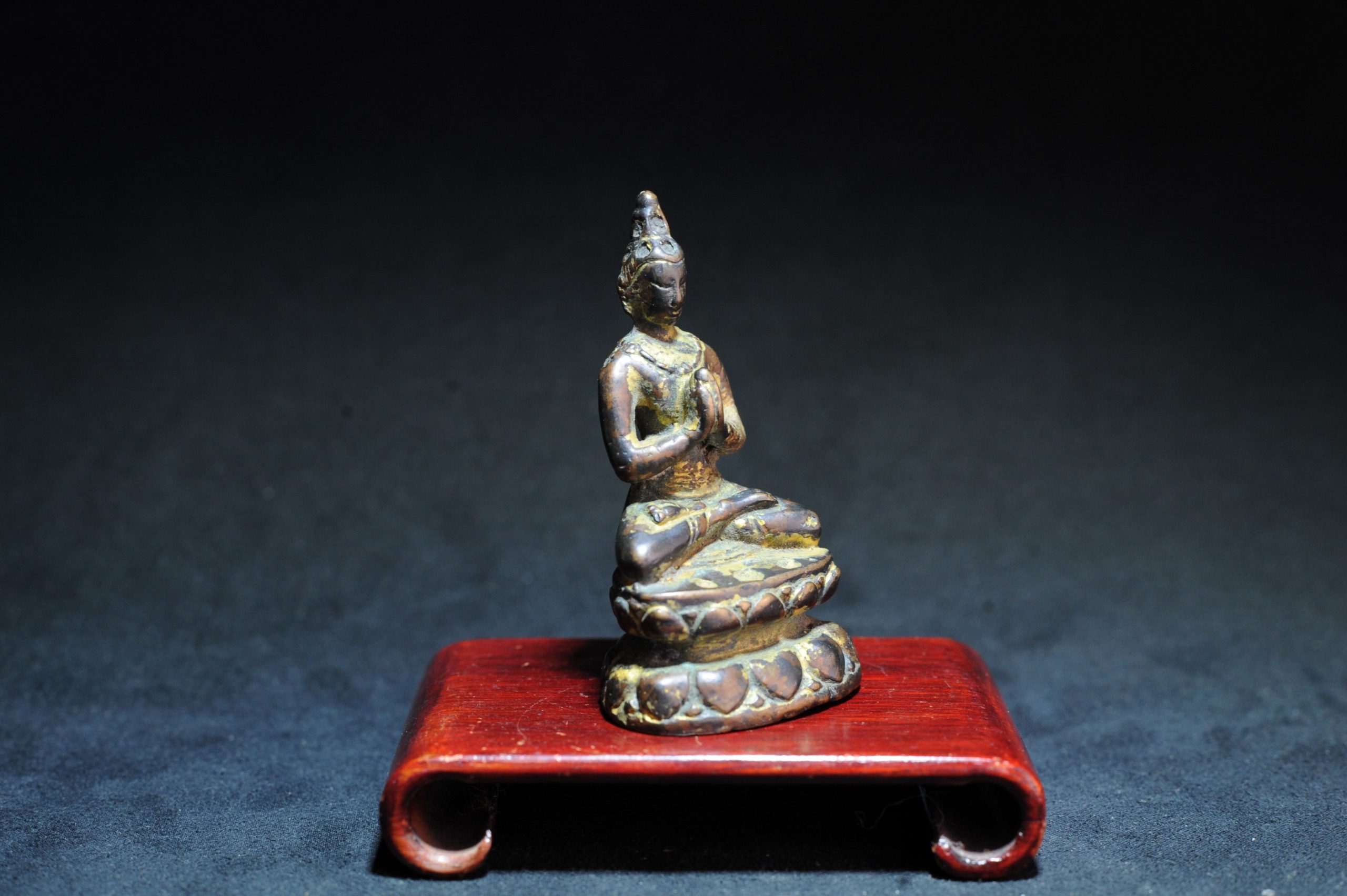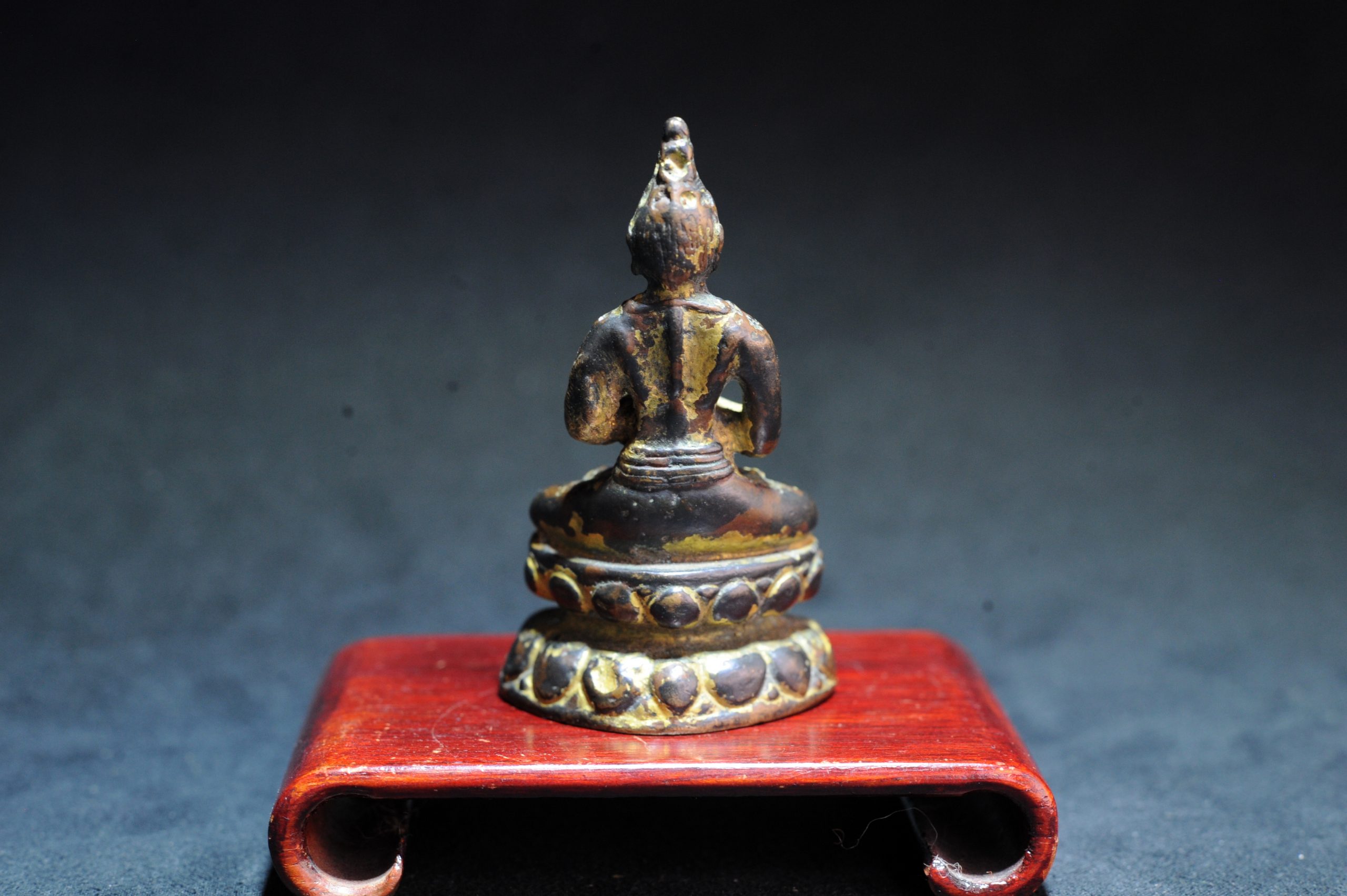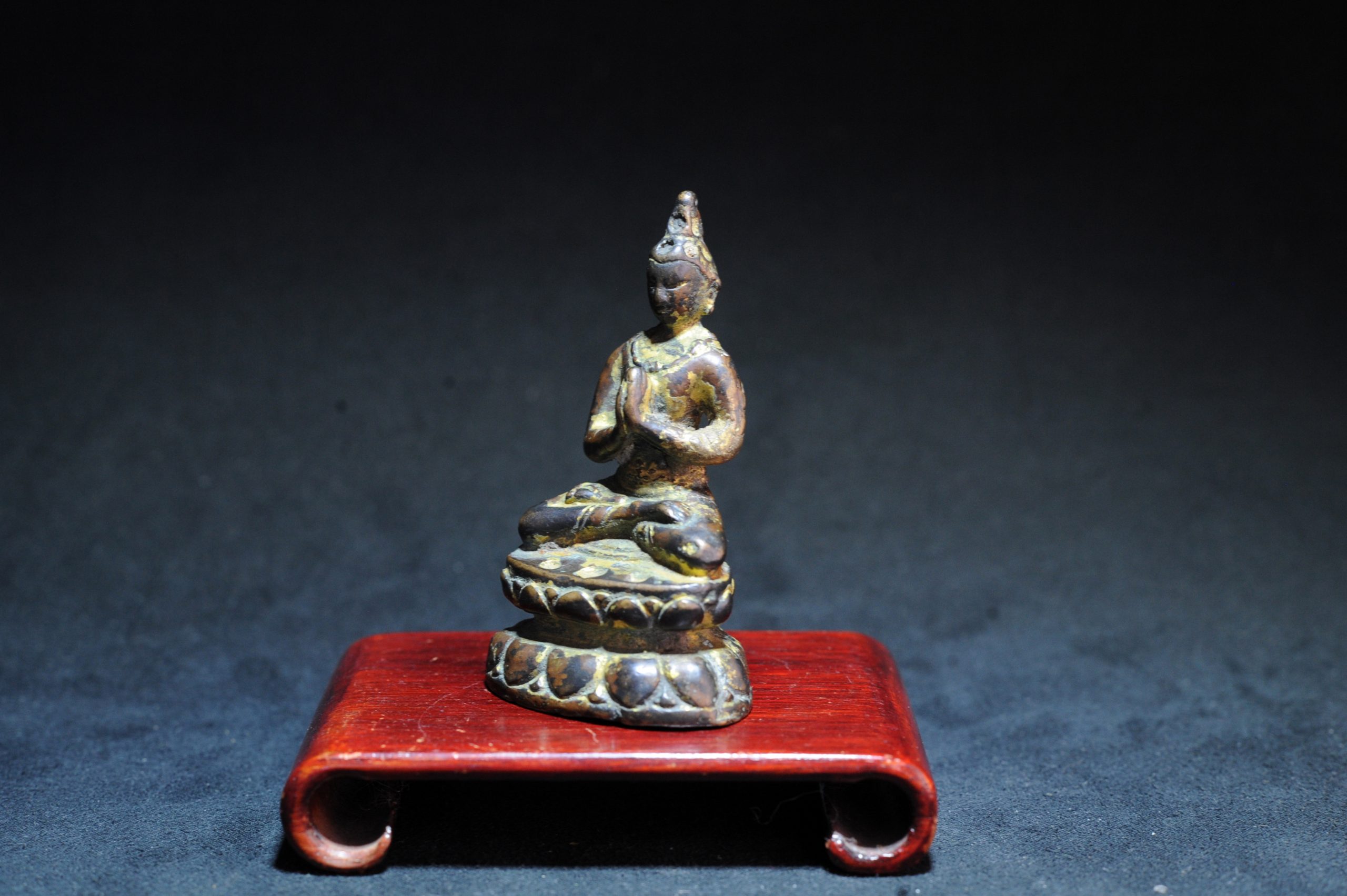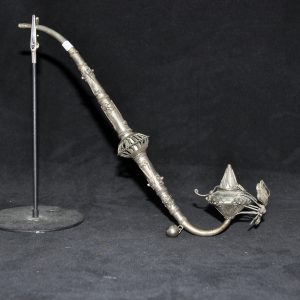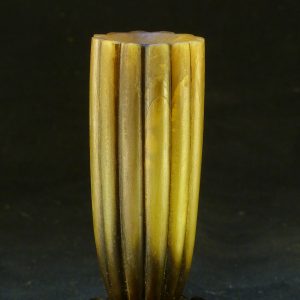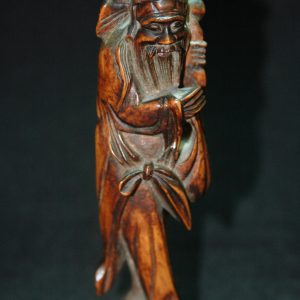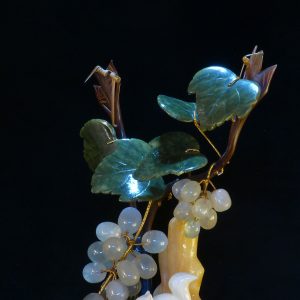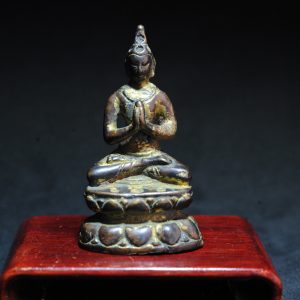Description
斯瓦特风格 7/8世纪铜鎏金佛造像
high: 3 in (7.5cm)
width: 1 3/4 in(4.3cm)
参考:佳士得
現場拍賣 19039
2020年9月24日
崇聖御寶 – 詹姆斯及瑪麗蓮·阿爾斯多夫珍藏(第二部分)
拍品 954 斯瓦特地區 七/八世紀 銅釋迦牟尼佛像
A BRONZE FIGURE OF BUDDHA SHAKYAMUNI
SWAT VALLEY, 7TH-8TH CENTURY
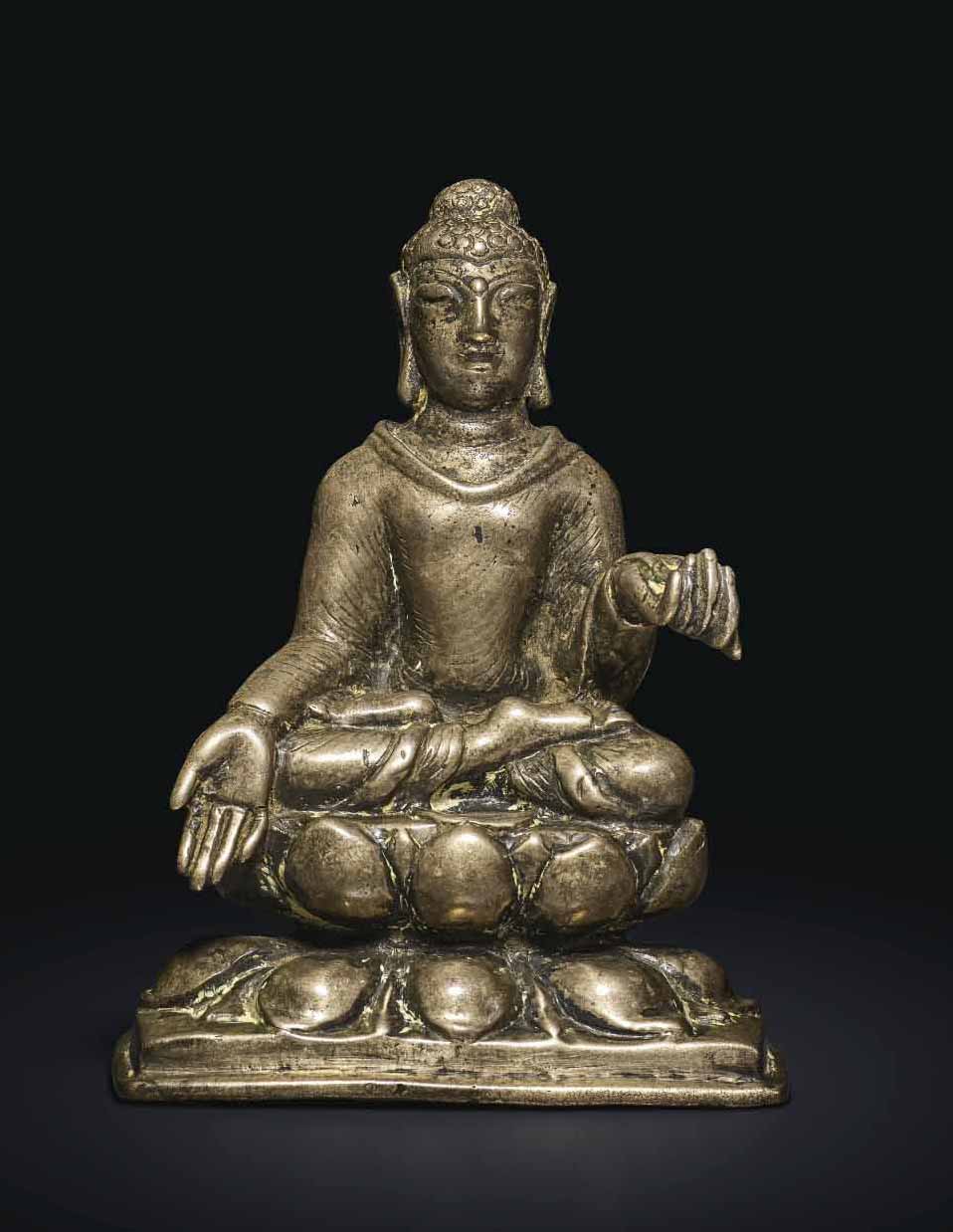
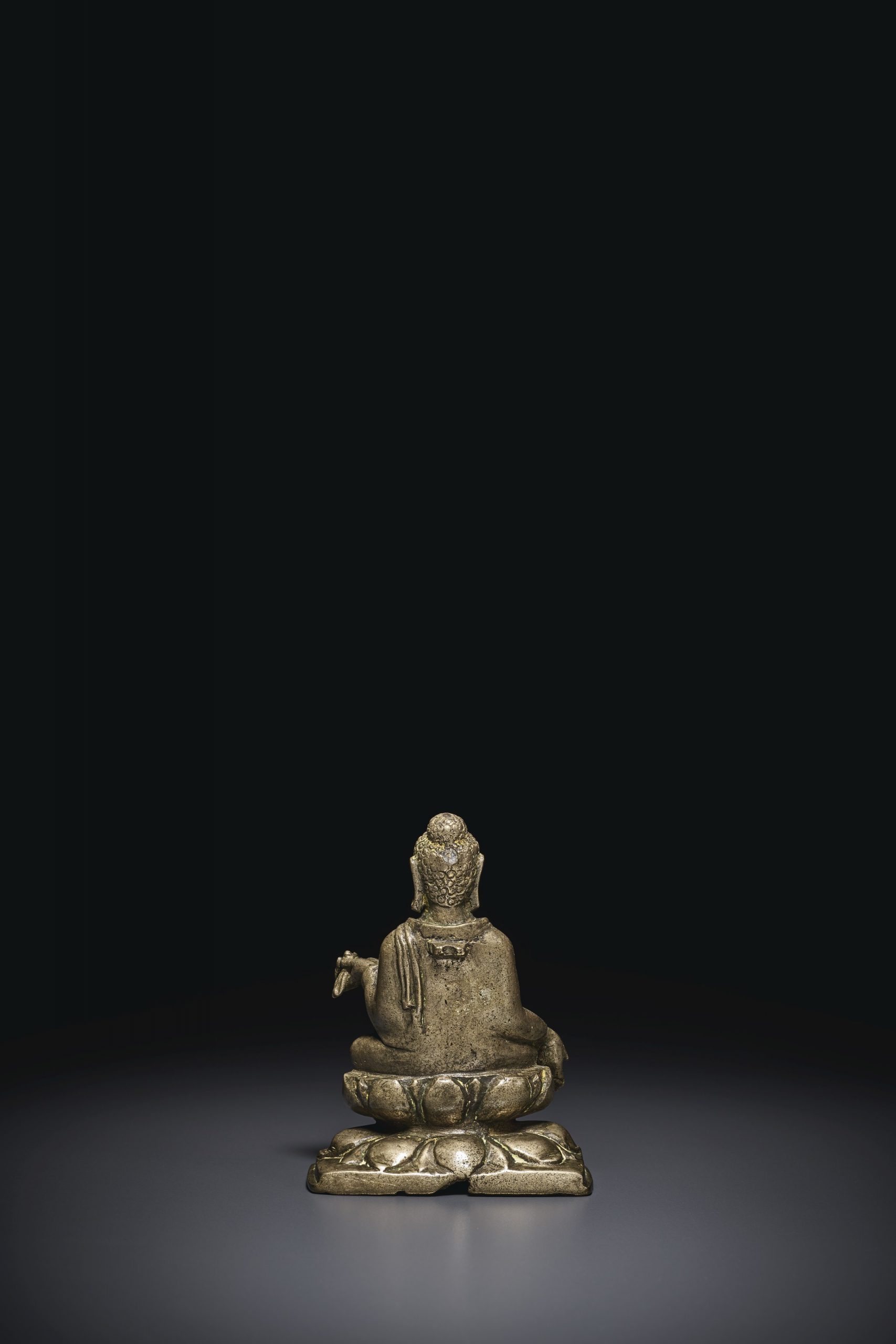
成交價 美元 40,000
估價 美元 8,000 – 美元 12,000
斯瓦特縣地區 七/八世紀 銅釋迦牟尼佛像
SWAT VALLEY, 7TH-8TH CENTURY
3 ¾ in. (9.5 cm.) high
來源
Bruce Miller,舊金山,1976年6月9日。
詹姆斯及瑪麗蓮·阿爾斯多夫珍藏,芝加哥,1990年以前入藏。
状况报告:
- 在莲花底座反面的边缘有轻微损失。
- 在人物背部的把手外缘有损失。
- 头部后面有一个浅的、圆形的凹陷。
- 在莲花底座的凹陷区域、脚踝下面和左手的凹陷区域有白色的沉积物。
- 表面有非常轻微的小坑,特别是在脸的右侧。
- 衣袍上的雕刻细节有磨损。
参考:佳士得
17 9月 2013 | 现场拍卖 2724
印度及东南亚艺术
拍品 278 斯瓦特风格 7/8世纪铜鎏金佛造像
A rare gilt bronze figure of Buddha
SWAT VALLEY, CIRCA 7TH CENTURY
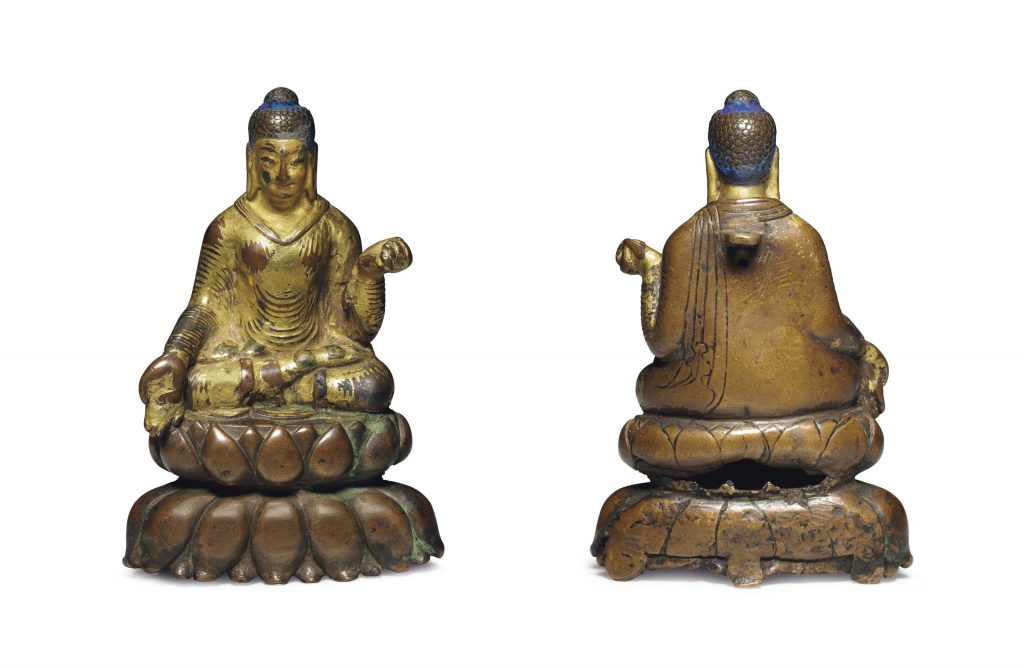
成交价 USD 171,750
估价 USD 20,000 – USD 30,000
A rare gilt bronze figure of Buddha
SWAT VALLEY, CIRCA 7TH CENTURY
细节
A rare gilt bronze figure of Buddha
Swat Valley, circa 7th century
Seated in dhyanasana over a double-lotus base with his right hand in varadamudra and his left holding the folds of his diaphanous sanghati, the face with benevolent expression with downcast eyes flanked by pendulous earlobes, the hair in tight curls over the ushnisha, with remains of polychroming and cold gold
3¾ in. (9.5 cm.) high
来源
Estate of Mr. Fong Chow, New York, acquired by 1974
出版
F. Chow, Arts from the Rooftop: Tibet, Nepal, Kashmir, 1971, cat. no. 1
展览
Arts from the Rooftop: Tibet, Nepal, Kashmir, The Metropolitan Museum of Art, 11 April-September, 1971, cat. no. 1
状况报告
Minor nicks and scratches with associated losses in gilding overall, as visible in illustration and upon firsthand inspection. Losses, including at the back of the lotus base, all visible upon firsthand inspection.
拍品专文
The present work is part of a relatively small corpus of Buddhist bronzes cast in the Swat Valley in the 7th through 10th centuries. The 6th century invasion of the nomadic Hunas into the Kabul Valley devastated the prosperous Buddhist monastic community in Gandhara, but Buddhism continued to thrive in the more remote Swat Valley until the 10th century. The current example demonstrates the ubiquity of the Gupta style, which by this time had almost completely replaced the earlier classical Gandharan style. While in the earlier period, Buddha was depicted wearing voluminous robes with asymmetrical drapery, by the 6th and 7th centuries the folds of the sanghati become more rhythmic and stylized. Similarly, the thick wavy locks of hair characteristic of the Gandharan period were replaced in the Gupta style with tight snailshell curls. The strongly waisted base with molded lotus petals, as found in the present work, is known only in Swat Valley bronzes from the 7th century onwards. The small size is typical for this period, and it was most likely meant to be portable. The destruction of the Buddhist monasteries of Gandhara, there was always the fear of further invasion. While not unknown, other gilt examples are extremely rare.
参考:故宫馆藏
藏传佛教造像精品赏析
精妙绝伦, 圣物供奉
7至8世纪 斯瓦特弥勒菩萨 黄铜坐像
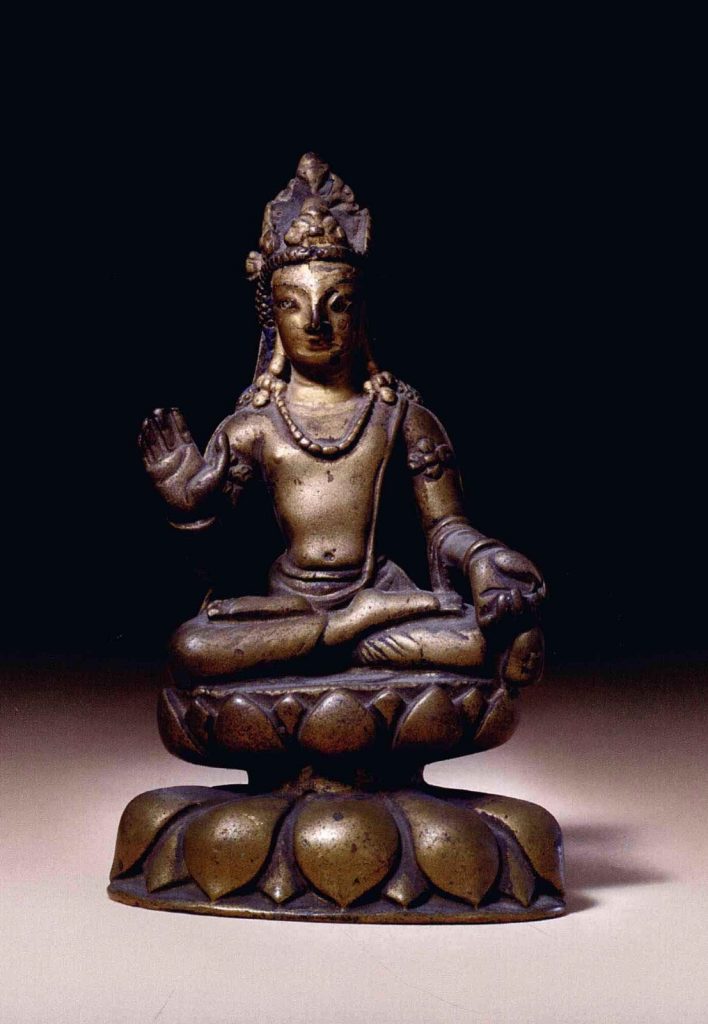
高12.7厘米
弥勒菩萨全踟趺坐,右手施无畏印,左手中指与无名指间夹一小净瓶,是这一时期很常见的弥勒标志。头戴三叶冠,头后部的发辫卷曲如连珠散落,左肩斜披的禅丝带均是弥勒作为苦修者的标志。莲座与莲瓣的特点以及臂钏位置靠上表明了此像的时代较早。
原清宫所系黄纸签云∶”大利益梵铜利玛弥勒菩萨。乾隆六十一年十一月初一日收,济咙呼图克图(即胡土克图—引者注)进。”。
参考:苏富比
INDIAN, HIMALAYAN AND SOUTHEAST ASIAN WORKS OF ART INCLUDING PROPERTY FROM THE ESTATE OF DR. CLAUS VIRCH
17 MARCH 2015 | 10:00 AM EDT
NEW YORK 1067
A COPPER ALLOY FIGURE OF SEATED BUDDHA
Swat Valley, 6th/7th Century
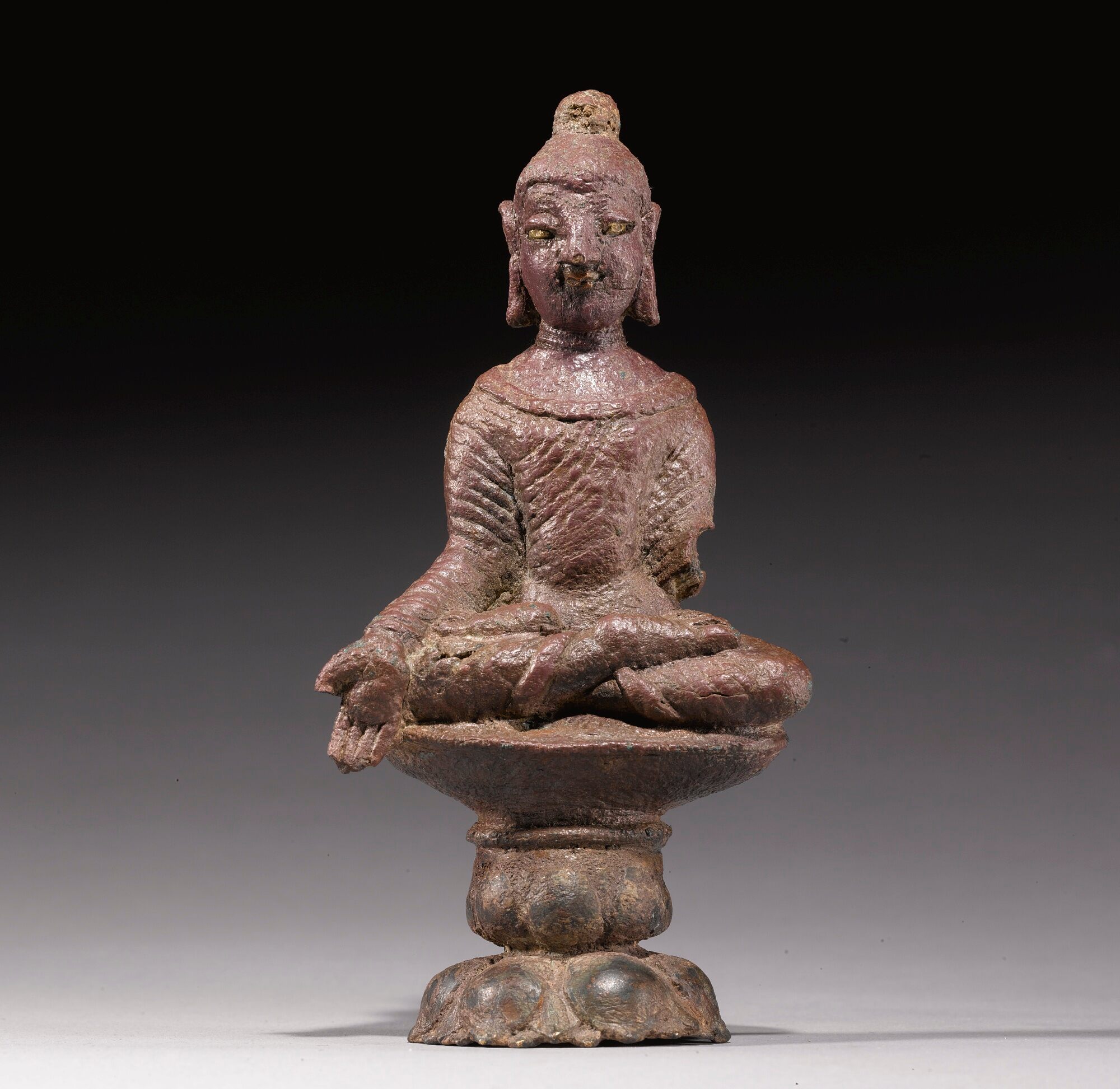
Swat Valley, 6th/7th Century
Estimate 5,000 — 7,000 USD
LOT SOLD. 8,750 USD
DETAILS & CATALOGUING
A COPPER ALLOY FIGURE OF SEATED BUDDHA
Swat Valley, 6th/7th Century
the Buddha seated in vajraparyankasana on a high lotus throne, the right hand extended in varada mudra, the eyes inlaid with silver and lips inlaid with copper
Height 5 ⅞ in. (25.8 cm)
Condition Report
Object is slightly darker than appears in catalogue illustration. Lower left arm missing, as illustrated in catalogue. Part of the back below the shoulders missing. Small crack left knee and along lower base on rear. Weathering and minor accretion throughout. No restoration.
PROVENANCE
Spink and Son, Ltd., 1970s.
参考:2004年北京瀚海秋季拍卖
斯瓦特 合金铜明永乐铜镀金四臂观音像
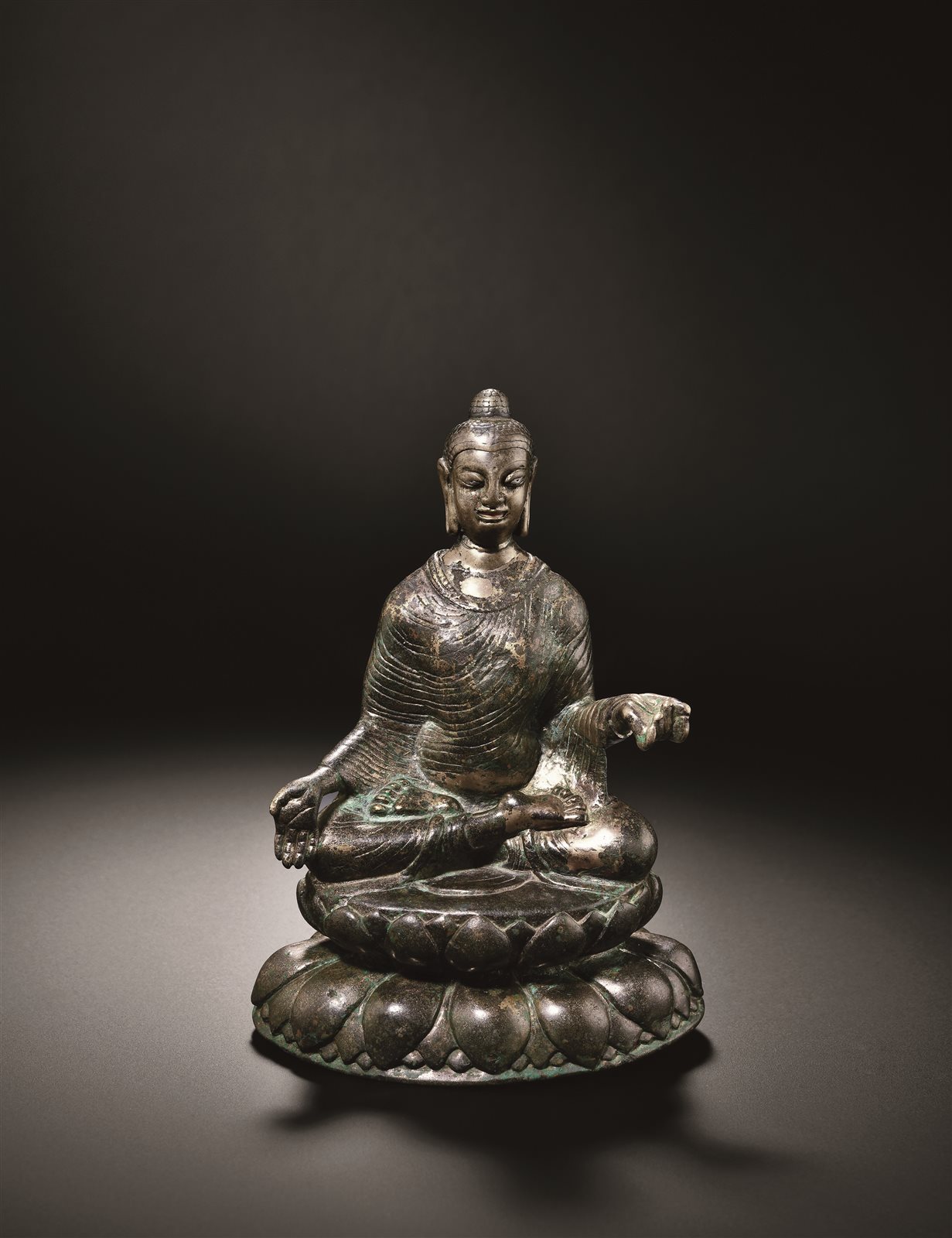
乌仗妙相倾天下 抿唇一笑最动人
—斯瓦特风格青铜释迦牟尼佛像欣赏
首都博物馆研究员 黄春和
在印度佛像艺术体系中,斯瓦特造像是一个十分著名的造像风格,它出产于印度河上游的斯瓦特河谷地区(今巴基斯坦境内),流行于公元6至10世纪。20世纪五六十年代,意大利考古学家在斯瓦特河谷首次发现并发掘出一批斯瓦特风格造像,这些造像造型风格一致,明显承袭了古印度犍陀罗艺术遗风,但在艺术意趣、表现手法和制作工艺上又与犍陀罗造像存在着一定的差异,其中最大的不同是犍陀罗造像主要以青灰色的片岩雕造,而斯瓦特造像则以青铜和黄铜铸造,西方学者因此以出土地命名为“斯瓦特造像”。
历史上,斯瓦特造像与毗邻的克什米尔造像联袂东迈,共同影响了我国西藏西部和新疆南部的佛像艺术,成为这两个地区佛像艺术的重要源泉。现在我们看到的这尊青铜铸造的释迦牟尼佛像就是一尊典型的斯瓦特风格造像,对于研究斯瓦特造像风格的特点与演变、我国西藏西部和新疆南部早期佛像艺术风格的渊源具有重要学术价值。(图1、图2)我们先看此像的造型基本特征。佛像头部高昂,头顶满布螺发,螺发以横向形式密集排列,顶部隆起高高的肉髻。面形长圆,双目睁视,眼白嵌银,鼻梁高挺,双唇抿起,嘴唇嵌银,眉宇间明显可见犍陀罗造像的遗韵。上身明显偏长,双肩溜圆,四肢修长,身躯伟岸而挺拔。身着通肩式袈裟,袈裟紧贴身体,衣纹呈水波状均匀分布,凸现出躯体及肌肉的自然起伏和变化。结跏端坐于莲花宝座上,一双肥厚的大脚裸露于外,格外引人注目。右手置右膝结施与印,左手向外平举执衣角,手势舒展自如,亲切自然。身下莲花座古朴大方,整体呈花瓣式,莲瓣均匀布满一周,宽大肥实,头部尖锐,造型生动美观。佛像背后上部凸出一个带孔方榫,显示曾配有背光,但现已分离丢失。座下装藏亦无,从内膛可窥其特有的时代风格与工艺信息。整像风格古朴凝重,气韵生动自然,品质高雅上乘,堪称古印度佛像艺术中难得一见的高古造像精品。特别是其表面仍留有岁月侵蚀的部分绿锈,愈加凸显其年代的悠远和古老。从造型特征可见,此像艺术风格十分独特,不同于同一时期的克什米尔造像,更不同于东印度帕拉和尼泊尔造像,而体现了斯瓦特造像明显的风格特点,具有斯瓦特地区鲜明的文化和艺术特色。其突出特点可以归纳为五个方面:
- 其一、它的发饰摒弃了犍陀罗造像波浪式的发型,采用了密集排列的螺发形式,很显然这是笈多艺术影响的结果,也是斯瓦特造像普遍流行的发饰样式。
- 其二,它的衣着虽然保留了犍陀罗造像通肩式袈裟,但袈裟的质感和衣纹样式明显吸取了笈多艺术的表现手法,衣质薄透贴体,衣纹呈水波状均匀分布,使躯体及肌肉看上去丰满而富有弹性,线条柔和自然。
- 其三,束腰式的仰覆莲花座,带有犍陀罗造像的明显遗风,莲瓣饱满宽大,舒展自如,显露出浓郁的古典主义艺术气息。
- 其四,它以青铜铸造,眼睛嵌银,又表现了鲜明的地域工艺特色。尤其是以青铜材料造像仅见于斯瓦特地区,因为斯瓦特地区同时流行青铜和合金铜造像,而同时期的克什米尔地区主要流行合金铜造像。
- 其五,整体造型规范,结构匀称,雕工精细,造型美观大方,风格古朴优雅,与克什米尔造像简率粗犷的表现手法、笨拙肥胖的躯体造型有着明显的差异。
这些特征是判定此像为斯瓦特造像的重要依据,也是所有斯瓦特风格造像共有的艺术表现。根据历史记载和现已发现的造像实物来看,斯瓦特地区佛像艺术前后大约流行了五个世纪。
那么这尊佛像的年代具体确定在什么时候呢?要解决这个问题,我们尚需了解斯瓦特地区佛像艺术的发展状况与分期。多年以前,笔者曾对斯瓦特造像进行了初步研究,将其发展历史分为前后两个时期,并对前后期造像的风格特征进行了归纳。前期,大约从6世纪到8世纪,为斯瓦特造像的萌芽期,或称准备期。其风格主要表现为对古老的犍陀罗艺术的继承和模仿,突出特征是以青铜或合金铜替代了犍陀罗造像以石雕为主的形式。后期,大约从9世纪至10世纪,为斯瓦特造像的定型期,或称成熟期。其风格既带有古老的犍陀罗艺术遗风,同时又在造型和工艺上开始追求装饰效果,造型趋于完美,工艺独特讲究,形成了斯瓦特造像新的时代特点,其中造型上的变化是其风格成熟的最为突出的特点。具体表现为:不论佛像还是菩萨像,斯瓦特造像都习惯使用一种造型和装饰非常独特的莲花宝座,由方形台座和莲花座构成;方座在上,正面有垂帘,两侧对称各安一狮;垂帘制作十分讲究,边缘或缀有流苏,或以连珠装饰,造型生动逼真,看上去有丝织物的感觉,明显借鉴了波斯挂毯的形式;方座下面由莲花座承托,莲座或为仰莲式,或为覆莲式,或为仰覆莲结合的形式,莲瓣宽大扁平,头部很尖,造型古朴优雅,明显源自犍陀罗造像中的莲花瓣样式(图3)。对比斯瓦特前后期造像的风格特征,此像明显可以判定为斯瓦特造像的前期风格,制作年代可定在7世纪前后。
目前这一时期的造像遗存不少,北京故宫博物院、西藏布达拉宫和首都博物馆等地都有收藏。这些造像的造型风格完全一致,既古朴凝重,又生动传神,尤其是它们的嘴唇皆统一抿起,并露出神秘动人的微笑,显露出浓郁的异域风情,总能给人留下难以忘怀的美好印象。
着录:《乌仗妙相倾天下 抿唇一笑最动人—斯瓦特风格合金铜释迦牟尼佛像》,《梵相金身—金璞阁藏佛集珍》第10-23页,文物出版社,2017年。
参考: 佳士得 3月17日 | 现场拍卖 19562
印度、喜马拉雅及东南亚工艺精品
拍品 442 斯瓦特地區 八/九世紀 銅嵌紅銅與銀蓮華手觀音坐像
THE PROPERTY OF A PRIVATE WEST COAST COLLECTOR
A COPPER- AND SILVER-INLAID BRONZE FIGURE OF PADMAPANI LOKESHVARA
SWAT VALLEY, 8TH-9TH CENTURY
拍品终止拍卖:
16 3月 2021
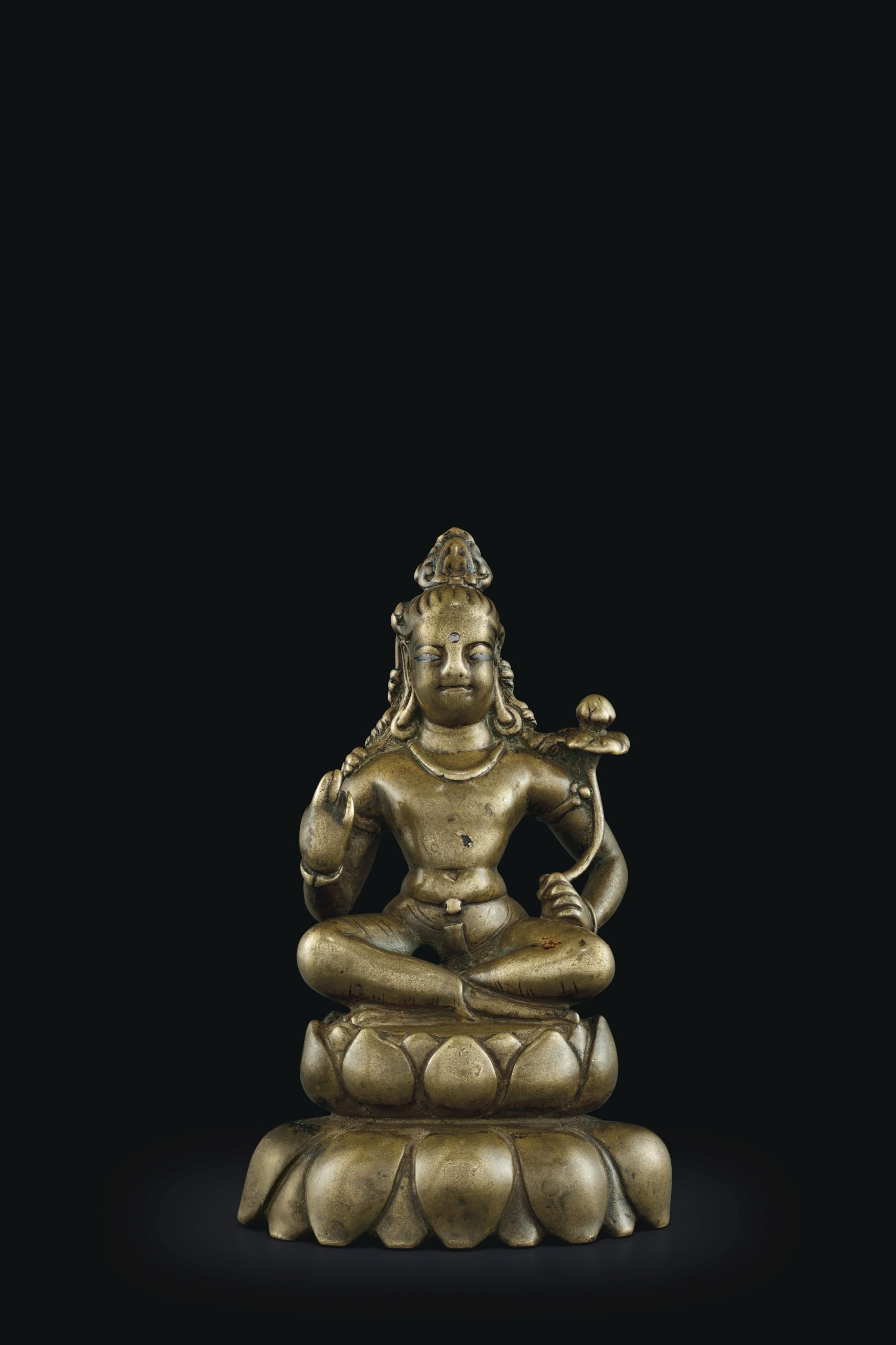
斯瓦特地區 八/九世紀 銅嵌紅銅與銀蓮華手觀音坐像 SWAT VALLEY, 8TH-9TH CENTURY
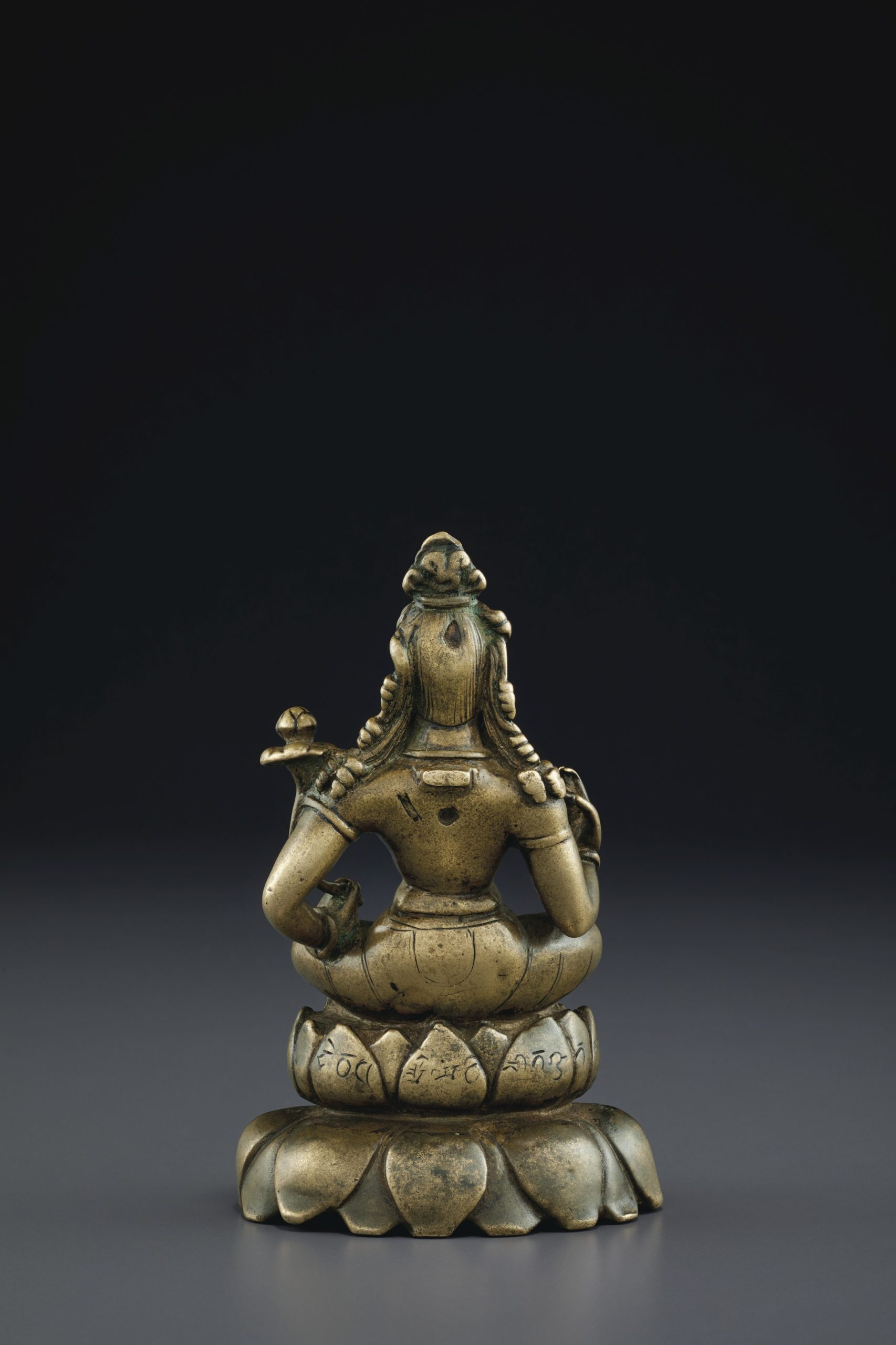
斯瓦特地區 八/九世紀 銅嵌紅銅與銀蓮華手觀音坐像 SWAT VALLEY, 8TH-9TH CENTURY
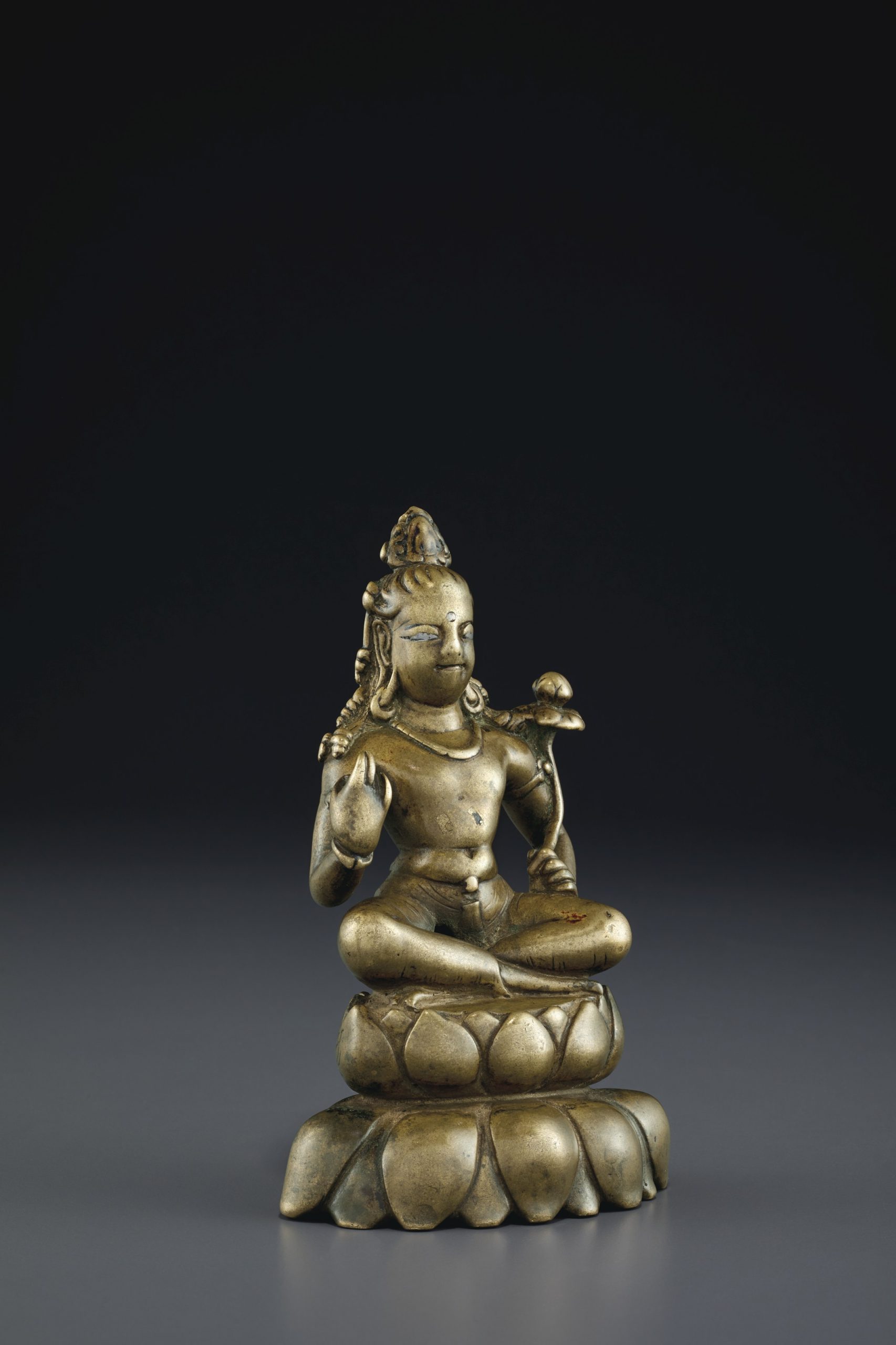
斯瓦特地區 八/九世紀 銅嵌紅銅與銀蓮華手觀音坐像 SWAT VALLEY, 8TH-9TH CENTURY
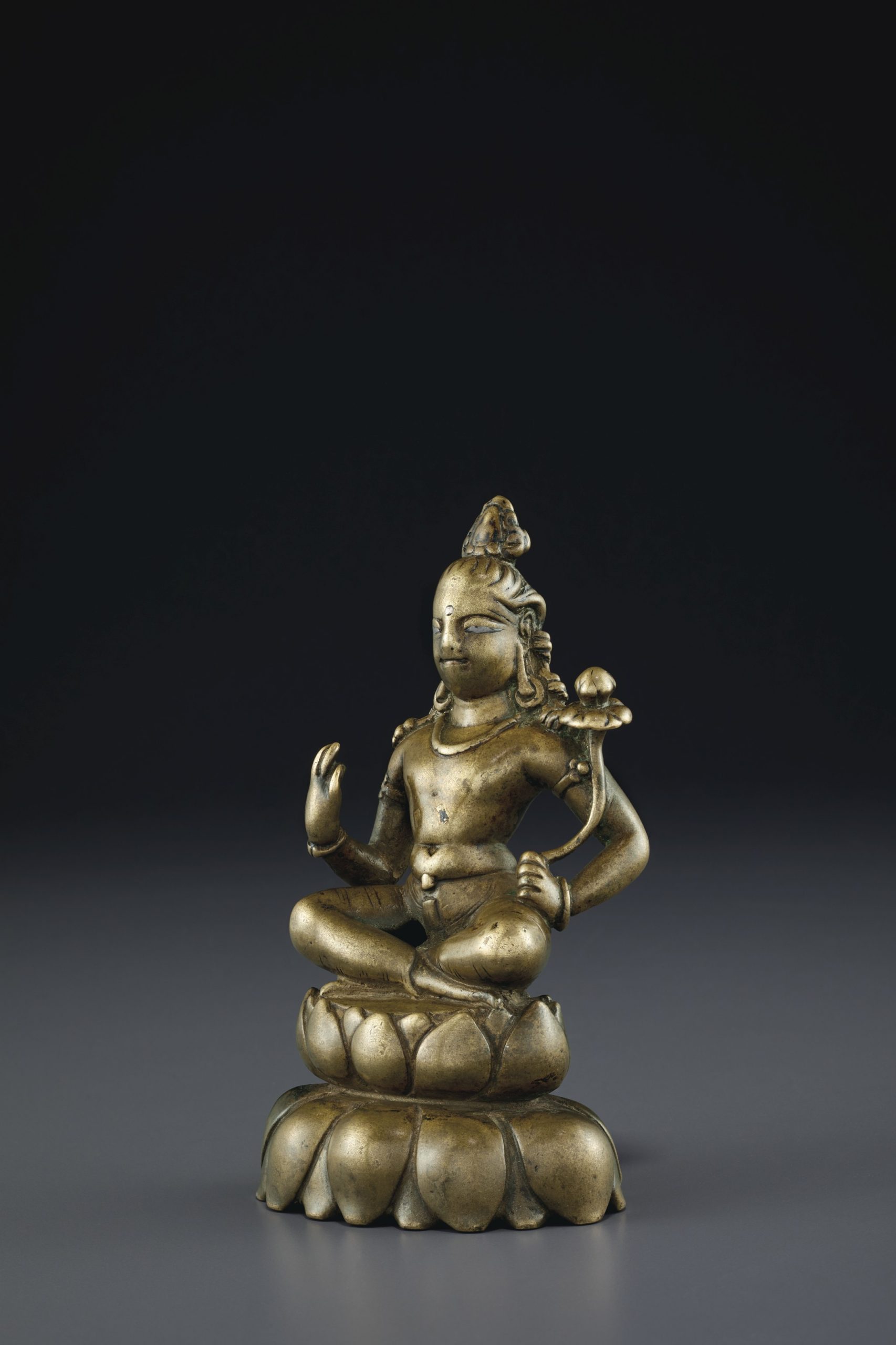
斯瓦特地區 八/九世紀 銅嵌紅銅與銀蓮華手觀音坐像 SWAT VALLEY, 8TH-9TH CENTURY
THE PROPERTY OF A PRIVATE WEST COAST COLLECTOR
A COPPER- AND SILVER-INLAID BRONZE FIGURE OF PADMAPANI LOKESHVARA
SWAT VALLEY, 8TH-9TH CENTURY
斯瓦特地區 八/九世紀 銅嵌紅銅與銀蓮華手觀音坐像
成交价 USD 175,000
估价 USD 40,000 – USD 60,000
拍品终止拍卖:
16 3月 2021
A COPPER- AND SILVER-INLAID BRONZE FIGURE OF PADMAPANI LOKESHVARA
SWAT VALLEY, 8TH-9TH CENTURY
细节
4 7/8 in. (12.4 cm.) high
来源
Collection of James and Marilynn Alsdorf, Chicago, by 1981.
Sotheby’s New York, 23 March 2000, lot 21.
出版
U. von Schroeder, Indo-Tibetan Bronzes, Hong Kong, 1981, pp. 84-85, cat. no. 6B.
P. Pal, A Collecting Odyssey: Indian, Himalayan and Southeast Asian Art from the James and Marilynn Alsdorf Collection, Chicago, 1997, pp. 132, 309-10, cat. no. 169.
Himalayan Art Resources, item no. 24606.
拍品专文
This widely published figure of Padmapani Lokeshvara displays classic stylistic elements from Swat Valley, including the almond-shaped eyes with delicate silver inlay, the pronounced modeling of the muscles around the navel with powerful upper torso, and the accentuated roundness of the beaded jewelry. A diminutive figure of Amitabha is visible on the crown of the head, further confirming the identity of the bodhisattva. The back of the lotus base bears an inscription.
Prototypes of the unusual double-lotus throne with overlapping petals in the Swat Valley can be seen as early as the seventh century, including a bronze figure of the bodhisattva Avalokiteshvara in the collection of the Metropolitan Museum of Art, acc. no. 2012.247, as well as a contemporaneous Swat bronze figure of Avalokiteshvara offered at Bonhams Hong Kong, 2 October 2018, lot 14.
Compare the distinctive physiognomy, the right hand raised in varada mudra and the tiered lotus base of the current work with further contemporaneous bronzes depicting bodhisattvas, illustrated by U. von Schroeder, Indo-Tibetan Bronzes, Hong Kong, 1981, pp. 84-85, cat. nos. 6A, 6C—6E.
参考:苏富比 922
INDIAN, HIMALAYAN & SOUTHEAST ASIAN ART
PROPERTY OF A PRIVATE BROOKLYN COLLECTOR
尼泊尔 铜合金小佛像 A SMALL COPPER ALLOY FIGURE OF BUDDHA Nepal, 12th/13th Century

2,000 — 3,000美元
拍品已售 13,750 美元 成交價 (含買家佣金)
拍品詳情
A SMALL COPPER ALLOY FIGURE OF BUDDHA Nepal, 12th/13th Century
the Buddha seated in dhyanasana with right hand gently extended in bhumisparshamudra and right hand folded in his lap in dhyanamudra, wearing a pleated robe draped in loose folds over the left shoulder and wrapped around the legs, the earlobes elongated towards the shoulders, the articulated tight curls covering the head and ushnisha, the serene face with downcast eyes and a meditative expression
Himalayan Art Resources item no. 13620.
Height 1 3/4 in. (4.4 cm.)
狀況報告
In overall good condition. With areas of wear to the gilding. Mounted to a base
來源
Christie’s London, Asian Decorative Arts, April 3, 2003, lot 72.
INDIAN, HIMALAYAN & SOUTHEAST ASIAN ART
2019年3月21日 | 上午 10:00 EDT
紐約
参考:苏富比 274
中國藝術珍品
瑞士私人收藏
西藏、十四/十五世紀 銅鎏金佛坐像
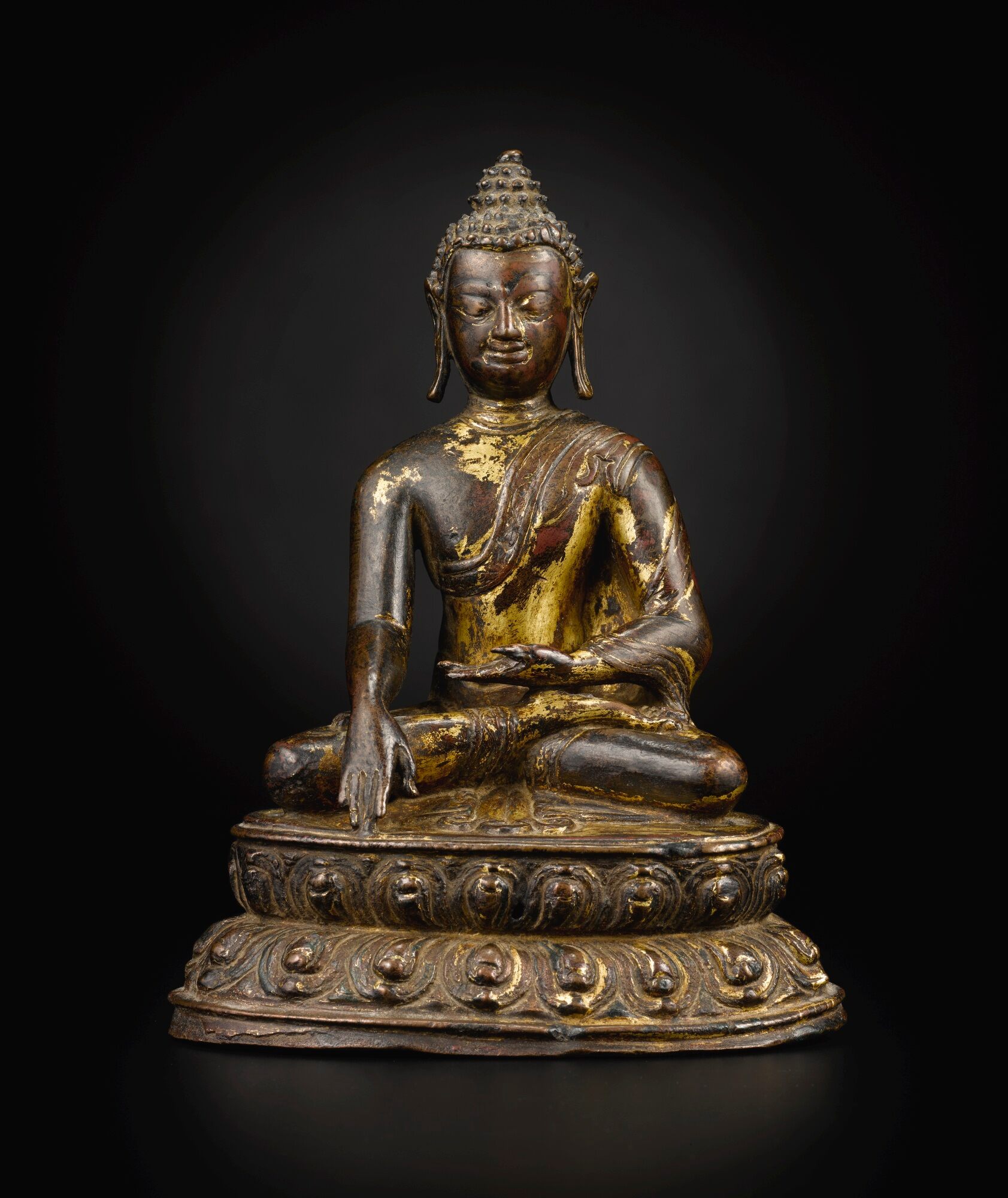
4,000 — 6,000英鎊
拍品詳情
西藏、十四/十五世紀 銅鎏金佛坐像
16.5 公分;6 1/2 英寸
中國藝術珍品
2016年11月9日 | 上午 11:30 GMT
倫敦
参考:佳士得 拍賣 2578
印度及東南亞藝術
紐約|2012年9月12日
拍品549|Property of a Private Connecticut Collector
鎏金释迦牟尼铜佛像
A gilt bronze figure of Shakyamuni Buddha
NEPAL, 15TH CENTURY
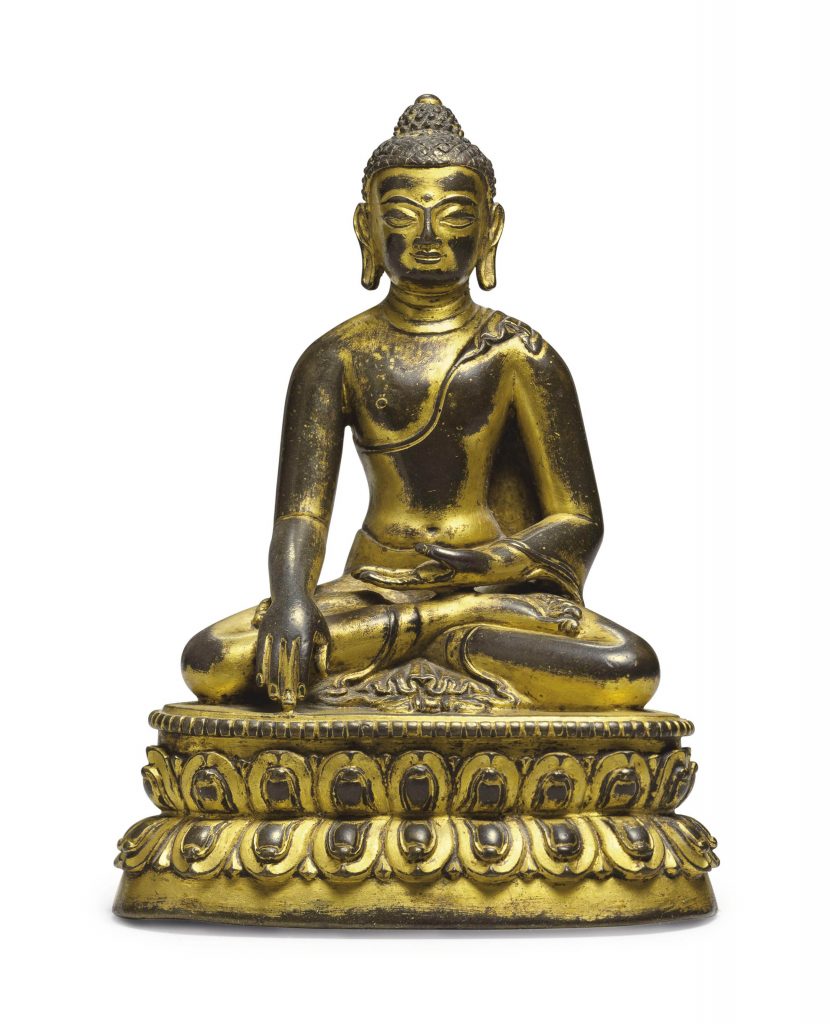
成交總額 USD 15,000
估價 USD 8,000 – USD 12,000
A gilt bronze figure of Shakyamuni Buddha
Nepal, 15th Century
Seated in dhyanasana on a double-lotus base, his hands in bhumisparsamudra with the vajra resting before him, clad in a diaphanous sanghati with the folds elegantly piled beneath the ankles, the face with elongated eyes flanked by pendulous earlobes and surmounted by a prominent ushnisha, the base sealed and incised with a double-vajra
4 5/8 in. (11.7 cm.) high
來源
Private collection, New York, acquired from Spink and Son, Ltd., London, 22 July 1974
参考:佳士得 拍賣 2640
Doris Wiener珍藏
紐約|2012年3月20日
拍品108 尼泊尔 14世纪 鎏金铜佛 阿弥陀佛
A gilt bronze figure of Amitabha
NEPAL, 14TH CENTURY
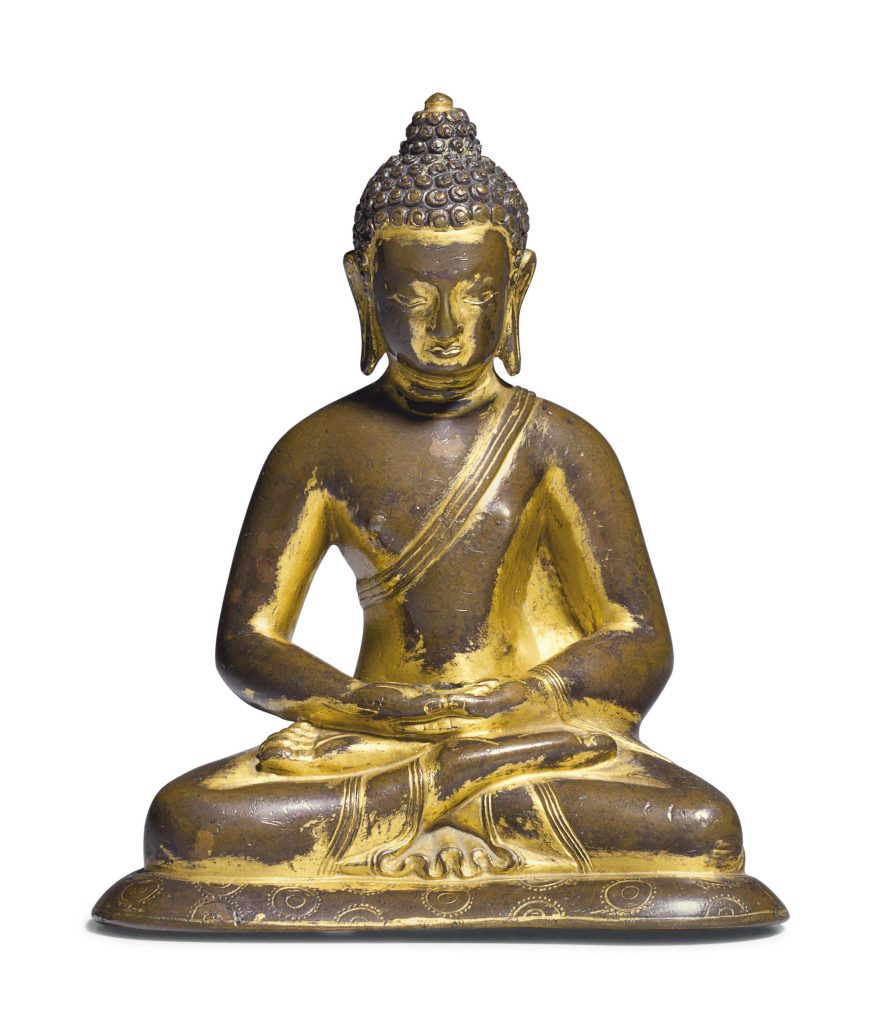
成交總額:USD 12,500
估價:USD 10,000 – USD 15,000
A gilt bronze figure of Amitabha
Nepal, 14th century
Seated in dhyanasana on a cushion incised with a circular pattern, hands resting in his lap, clad in a sheer sanghati draped over the shoulder and gathered in folds under the ankles, the face with downcast, almond-shaped eyes flanked by elongated earlobes, the hair in tight curls with the ushnisha capped by a knop
5 1/8 in. (13 cm.) high
來源
Doris Wiener Gallery, New York, 1979
文獻及展覽
展覽
Navy Pier Show, Chicago, 1985
International Fine Arts and Antique Dealers Fair, New York, 1985
参考:佳士得拍賣 14484
印度、喜瑪拉雅及東南亞工藝精品
紐約|2017年9月13日
拍品609
印度北部或西藏 十二/十三世紀 嵌銀和紅銅釋迦牟尼坐像
Northeastern India or Tibet, 12th/13th century
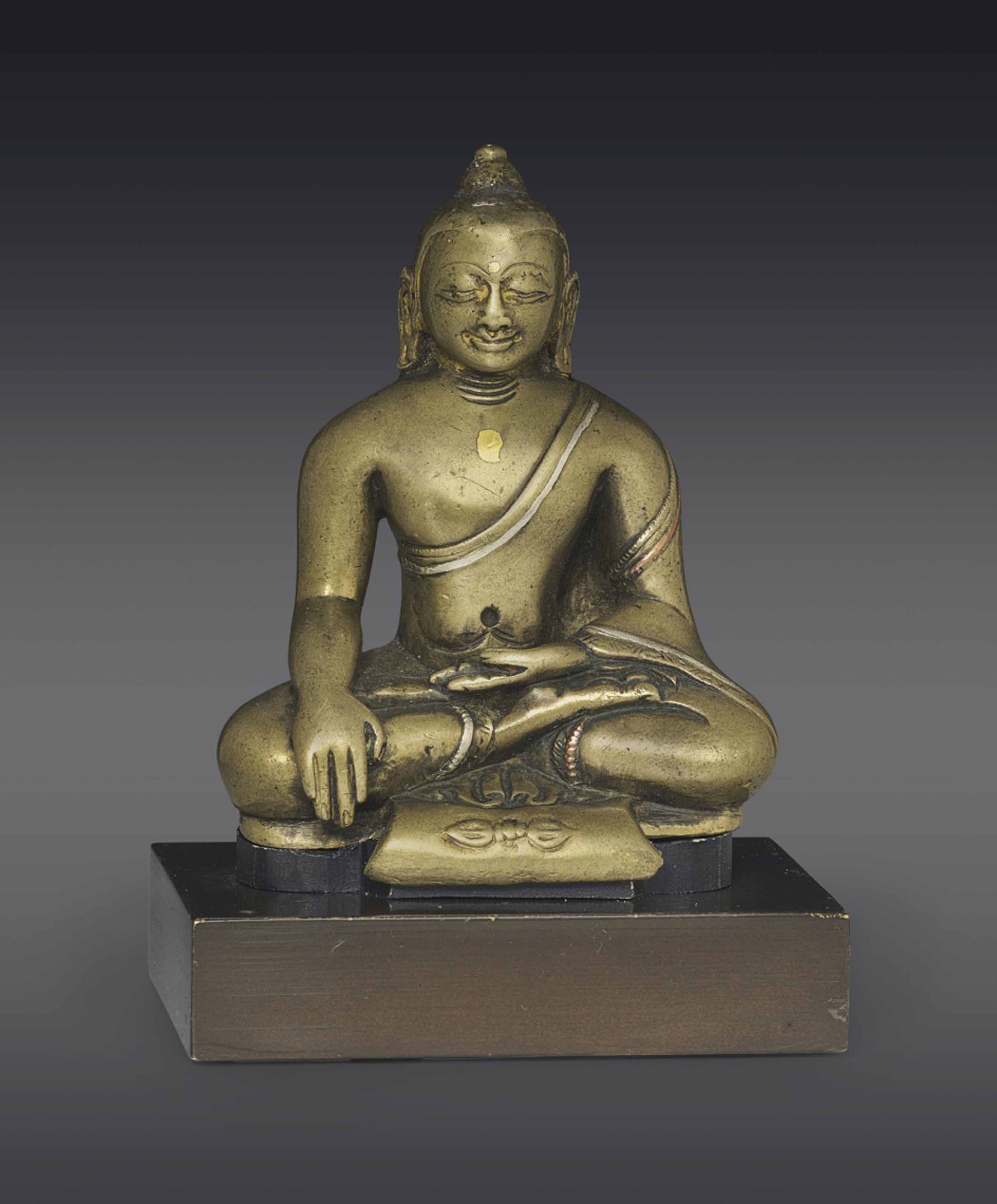
印度北部或西藏 十二/十三世紀 嵌銀和紅銅釋迦牟尼坐像
成交總額 USD 30,000
估價 USD 2,000 – USD 3,000
印度北部或西藏 十二/十三世紀 嵌銀和紅銅釋迦牟尼坐像
2 ¼ in. (6 cm.) high
來源
Acquired by the 1970s, by repute.
Accessioned by the Brooklyn Museum of Art, New York, 2010 (TL2010.38.44).
文獻及展覽
文獻
Himalayan Art Resource (himalayanart.org), item no. 24323
拍品專文
This small but exquisite early bronze figure of Buddha Shakyamuni displays a unique combination of stylistic features that suggest influences from both Tibet and northeastern India. The modeling of the body with broad shoulders and inflated chest which narrows at the waist, as well as the inlay of precious metals to accentuate the hem of the sanghati, are comparable to Pala school sculpture from India (see U. von Schroeder, Buddhist Sculptures in Tibet Vol. 1, India and Nepal, Hong Kong, 2001, pp.266-267, cat no.85c). However, the very rounded shape of the head and facial features are more similar to Tibetan examples from the period, as is the greenish hue of the metal (see U. von Schroeder, Indo-Tibetan Bronzes, Hong Kong, 1981, p.172, cat.no. 30B). While it is difficult to say for certain from which culture this work originates, it is undoubtedly the creation of a skilled artist, commissioned by a wealthy patron with the means to include costly silver and copper inlay.
参考:佳士得拍賣 11421錦瑟華年
安思遠私人珍藏
第四部分:中國工藝精品 ─ 金屬器、雕塑及早期瓷器
紐約|2015年3月20日
拍品759 唐 鎏金銅佛坐像
CHINA, TANG DYNASTY (AD 618-907)
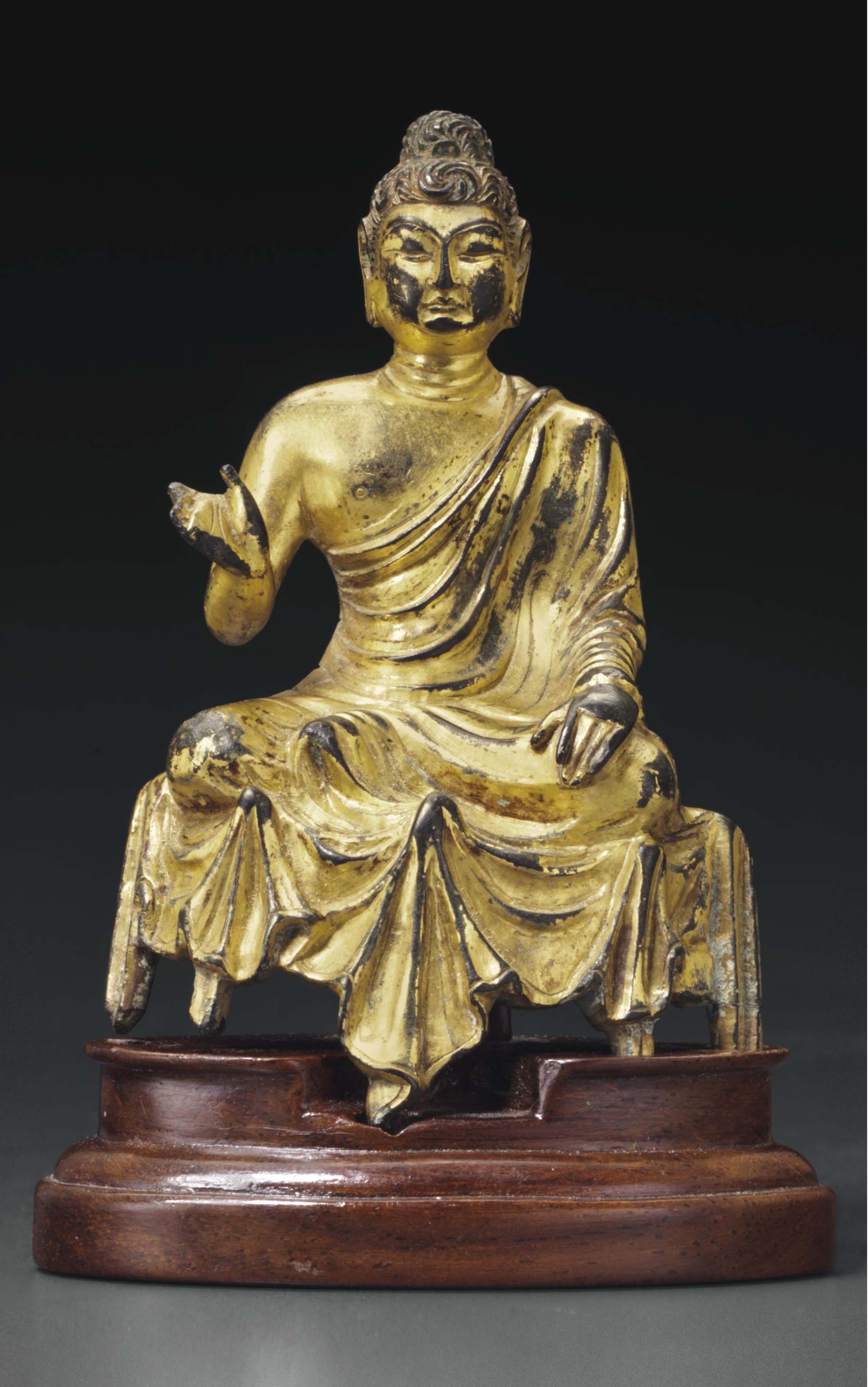
成交總額:USD 161,000
估價:USD 20,000 – USD 30,000
唐 鎏金銅佛坐像
來源
Christian Humann (d.1981), New York, named the Pan-Asian Collection by 1977.
The Collection of Robert H. Ellsworth, New York, acquired in 1982.
參考:紐約大都會博物館
斯瓦特风格 7世纪
观世音菩萨 铜像
Bodhisattva Avalokiteshvara
7th century
Pakistan (Swat Valley)
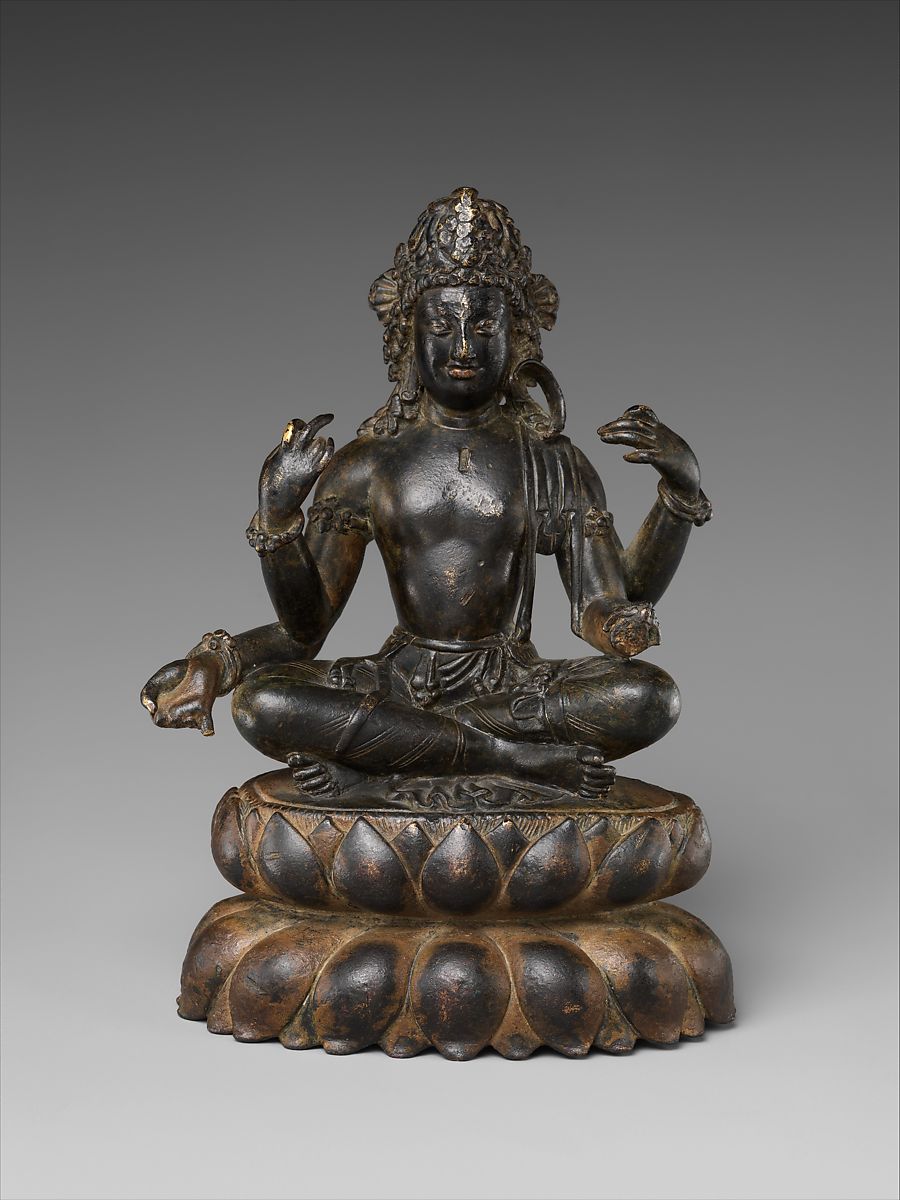
7th century
Pakistan (Swat Valley)
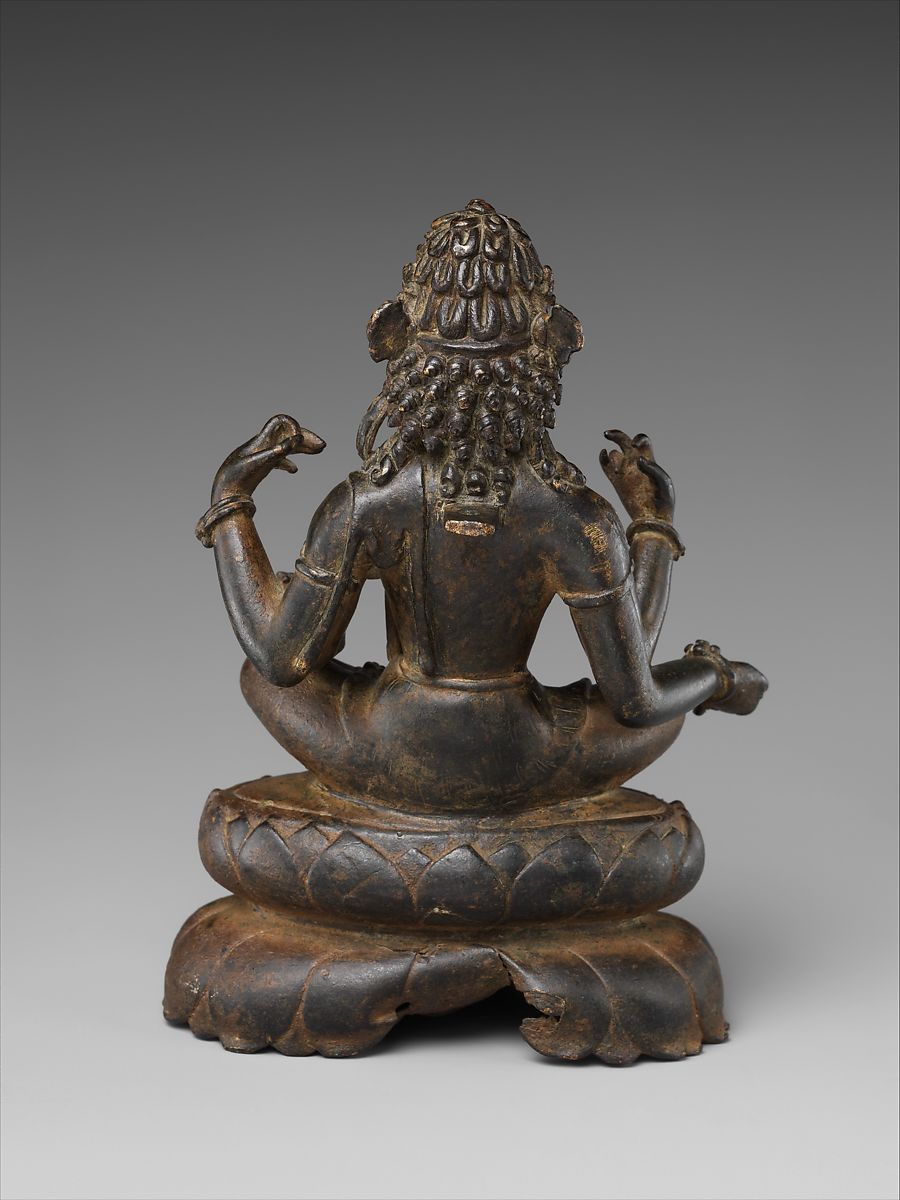
7th century
Pakistan (Swat Valley)
This is one of the greatest early medieval metal icons associated with Buddhist art of the Swat Valley. The work is closely connected to related major schools of religious image making in Gilgit (northern Pakistan) and Kashmir, and its physiognomy and drapery embodies elements of the late Gandharan style. The four-armed form of Avalokitesvara marks the beginning of a long tradition of figures known as the “Bodhisattva of the six-syllables,” associated with the famous prayer “Om Manipade Hum.” This iconographic form is a visualization of that prayer.
On view at The Met Fifth Avenue in Gallery 237
Bodhisattva Avalokiteshvara, Brass with silver and copper inlay, Pakistan (Swat Valley)
Object Details
Date:7th century
Culture:Pakistan (Swat Valley)
Medium:Brass with silver and copper inlay
Dimensions:H. 6 3/4 in. (17.1 cm); W. 4 3/4 in. (12.1 cm); D. 3 1/2 in. (8.9 cm)
Classification:Sculpture
Credit Line:Purchase, The Vincent Astor Foundation, Anonymous, Mr. and Mrs. Gilbert H. Kinney, and Nancy Fessenden Gifts; John Stewart Kennedy and Rogers Funds, by exchange; Gifts of Cynthia Hazen Polsky, Mrs. Jacob M. Kaplan, and Samuel Eilenberg, by exchange, 2012
Accession Number:2012.247
Provenance
Christie’s, London , 27th March 1972, lot 184; Leonidas Goulandris until 2012; [sold to Carlton Rochell, Ltd., 2012, New York]
Timeline of Art History
Timelines
South Asia: North, 500-1000 A.D.
參考:紐約大都會博物館
加德满都谷地 12世纪
鎏金菩萨 铜佛
Bodhisattva
12th century
Nepal (Kathmandu Valley)
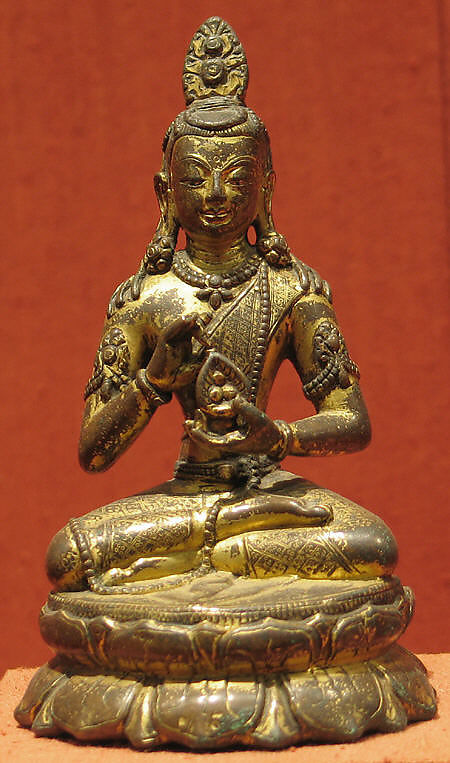
12th century
Nepal (Kathmandu Valley)
On view at The Met Fifth Avenue in Gallery 252
Object Details
Period:Thakuri period
Date:12th century
Culture:Nepal (Kathmandu Valley)
Medium:Gilt-copper alloy
Dimensions:H. 4 in. (10.2 cm)
Classification:Sculpture
Credit Line:Gift of Spink & Son Ltd. and Douglas A. J. Latchford, 1989
Accession Number:1989.237.1
Provenance
Spink & Son Ltd. , London, and Douglas A. J. Latchford, London (by 1989; given to MMA jointly)
Exhibition History
New York. The Metropolitan Museum of Art. “Art of the Himalayas,” December 15, 2010–December 4, 2011.
Timeline of Art History
Timelines
Himalayan Region, 1000-1400 A.D.
參考:紐約大都會博物館
印度克什米尔 7-8世纪
镶铜龈 黄铜佛
Buddha, Brass inlaid with copper and silver,
India (Kashmir region),7th–8th century
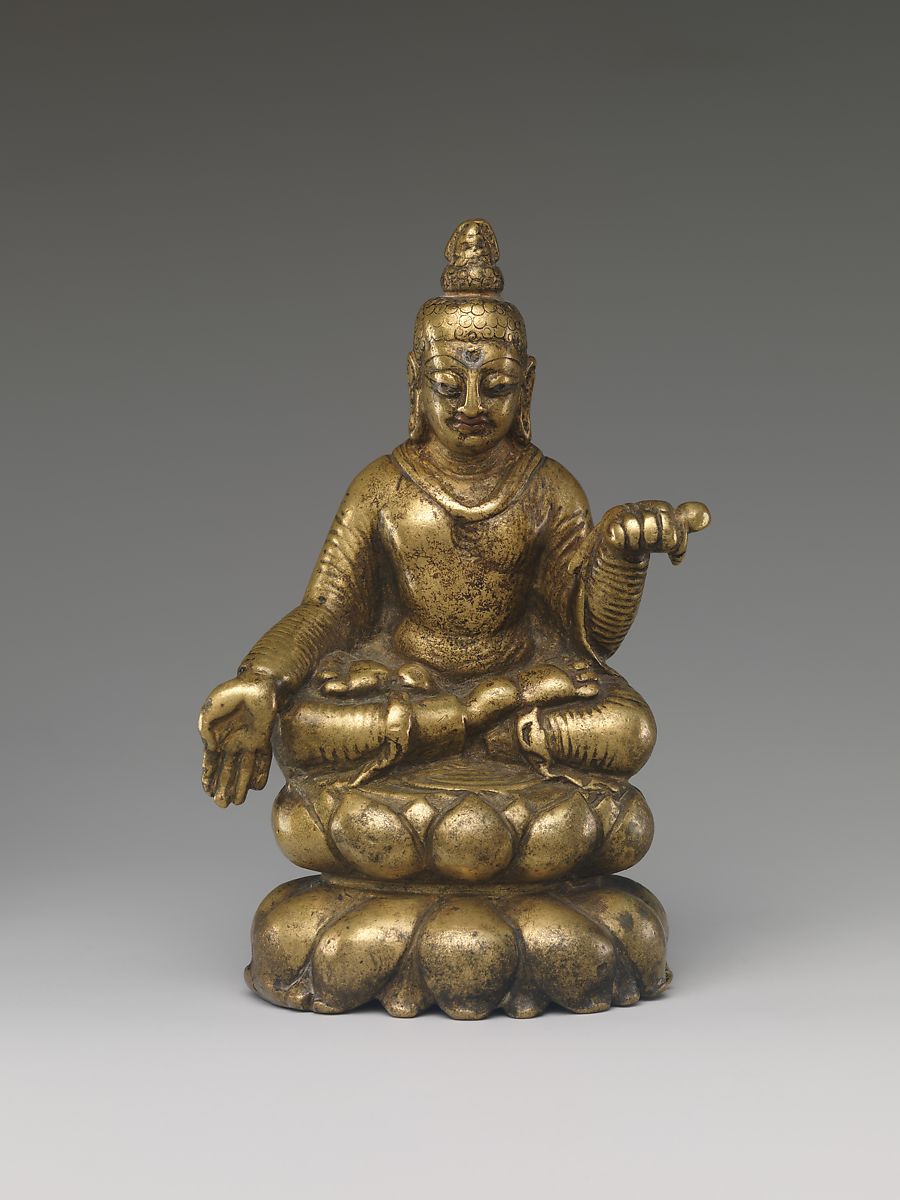
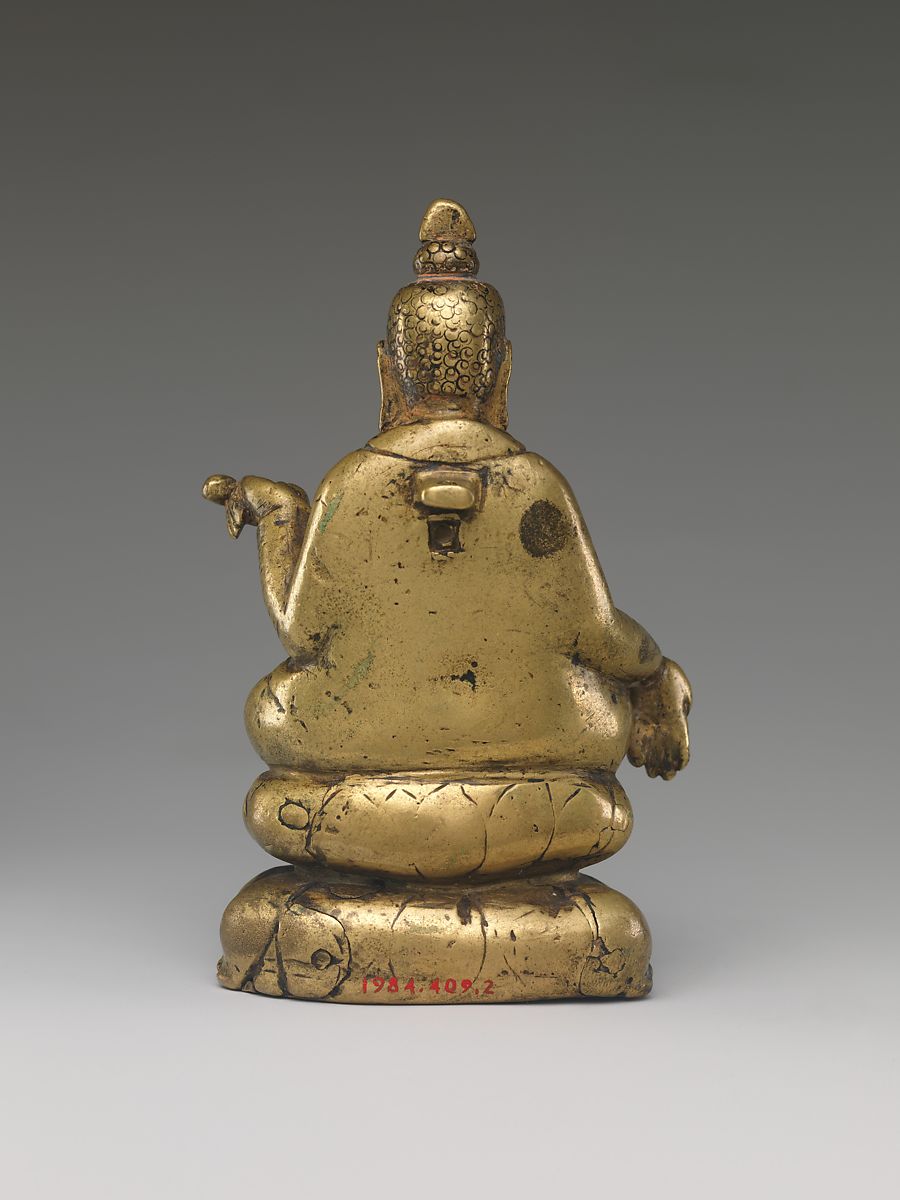
Object Details
Date:7th–8th century
Culture:India (Kashmir region)
Medium:Brass inlaid with copper and silver
Dimensions:H. 3 7/8 x W. 2 1/2 x D. 1 3/8 in. (9.8 x 6.4 x 3.5 cm)
Classification:Sculpture
Credit Line:Gift of Mr. and Mrs. Michael Phillips, 1984
Accession Number:1984.409.2
Provenance
Mr. and Mrs. Michael Phillips , Beverly Hills, CA (until 1984; donated to MMA)
Timeline of Art History
Timelines
South Asia: South, 500-1000 A.D.
MetPublications
Wisdom Embodied: Chinese Buddhist and Daoist Sculpture in The Metropolitan Museum of Art
Tara 7th century Pakistan (Swat Valley region)
This goddess sits with crossed legs on a double lotus throne and holds her hands a gesture of adoration anjali mudra) but twisted; as this unique hand posture is clear and well executed, we must assume that it has a specific meaning, now lost. She wears her hair in a fanlike coiffure and has large ear ornaments, a Gupta-style legacy perpetuated in the northwest.
参考:紐約大都會博物館
Tara, Brass inlaid with silver and copper,
Pakistan (Swat Valley region)
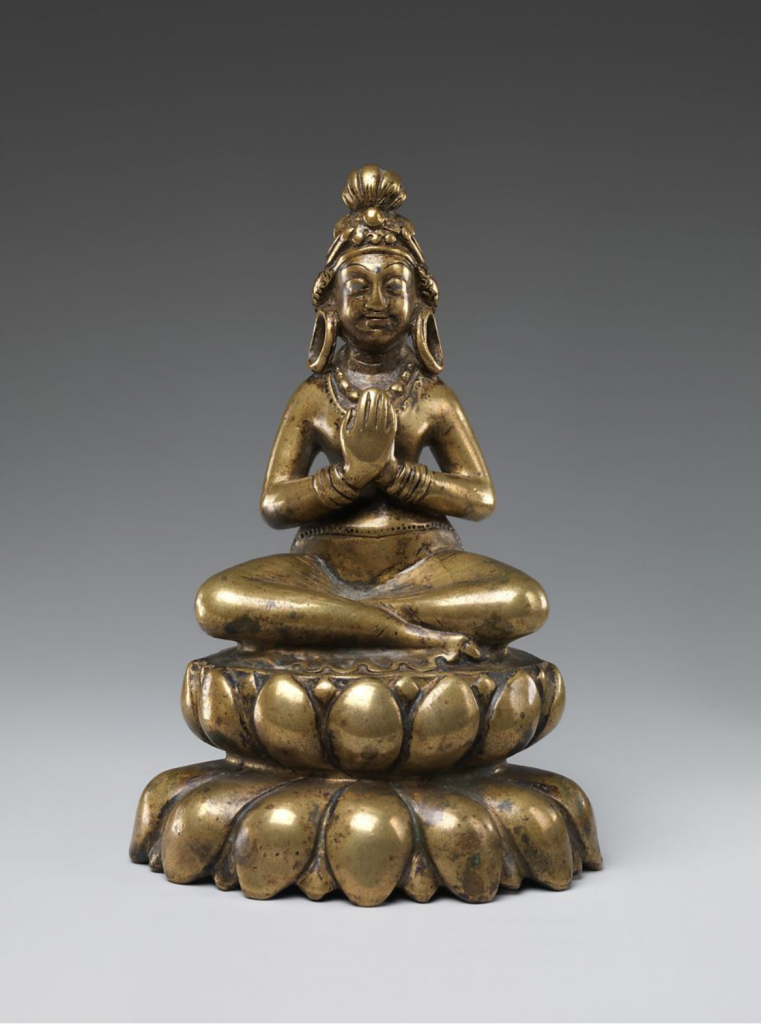
Tara, Brass inlaid with silver and copper, Pakistan (Swat Valley region)
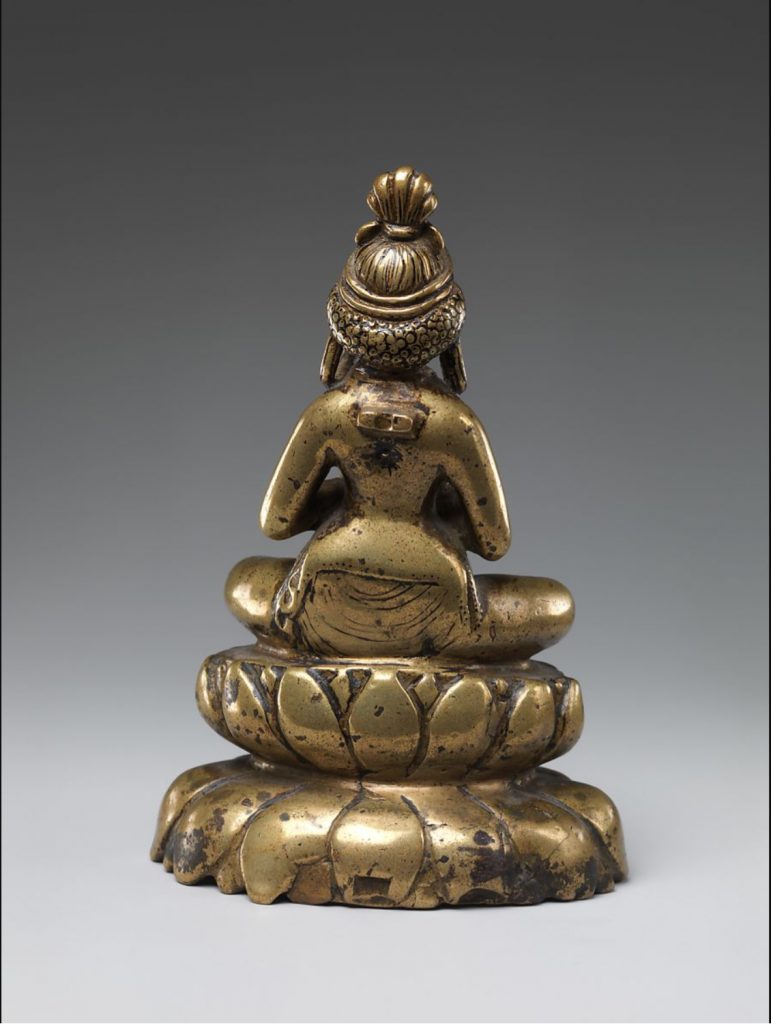
Tara, Brass inlaid with silver and copper, Pakistan (Swat Valley region)
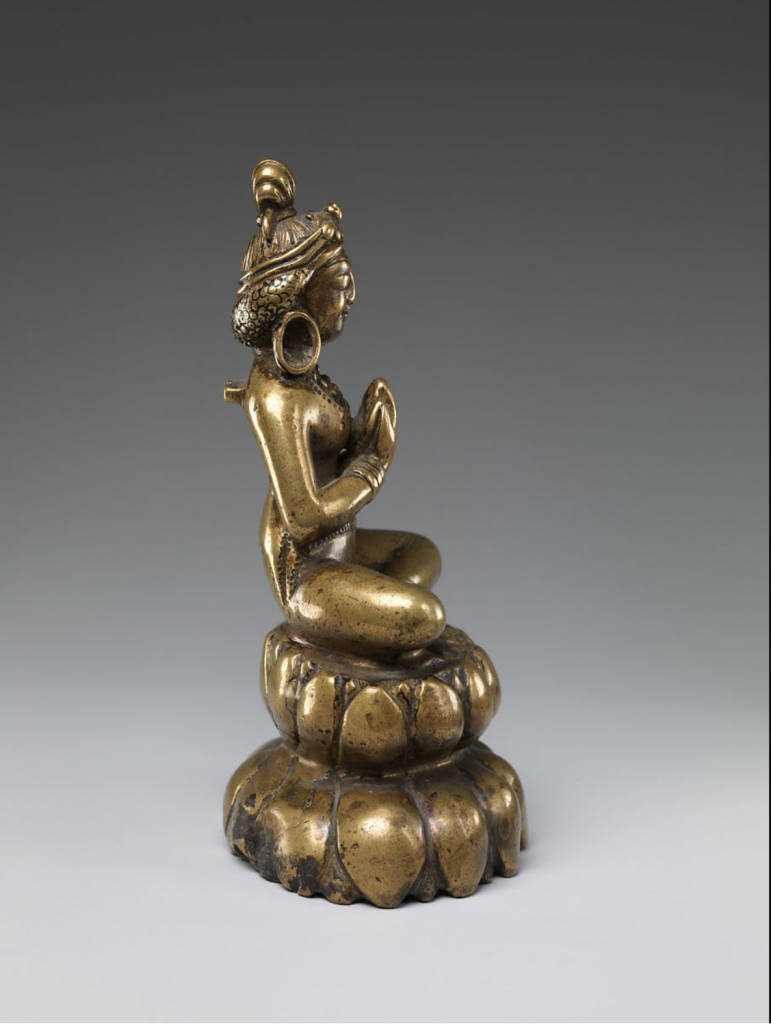
Tara, Brass inlaid with silver and copper, Pakistan (Swat Valley region)
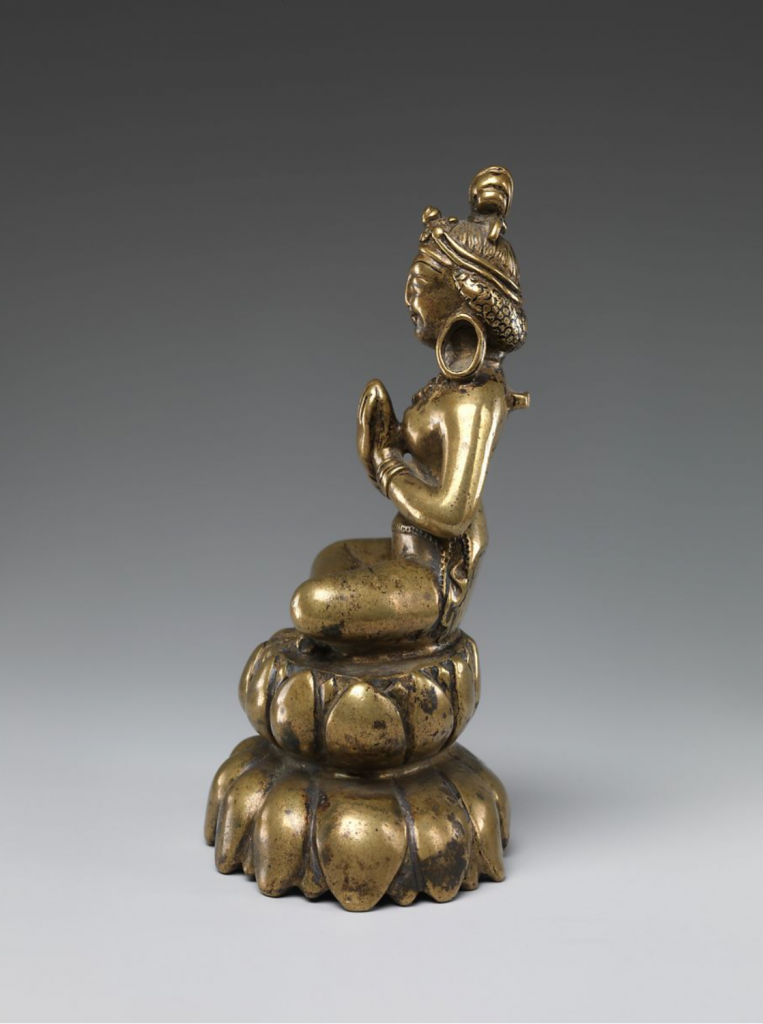
Tara, Brass inlaid with silver and copper, Pakistan (Swat Valley region)
Object Details
Title: Tara
Date: 7th century
Culture: Pakistan (Swat Valley region)
Medium: Brass inlaid with silver and copper
Dimensions: H. 4 5/8 in. (11.8 cm); W. 3 1/8 in. (7.9 cm); D. 2 1/8 in. (5.4 cm)
Classification: Sculpture
Credit Line: Samuel Eilenberg Collection, Gift of Samuel Eilenberg, 1987
Accession Number: 1987.142.62
Provenance
Samuel Eilenberg , New York (until 1987; donated to MMA)
Exhibition History
New York. The Metropolitan Museum of Art. “The Lotus Transcendent: Indian and Southeast Asian Art from the Samuel Eilenberg Collection,” October 2, 1991–June 28, 1992.
New York. The Metropolitan Museum of Art. “Mother India: The Goddess in Indian Painting,” June 29, 2011–November 27, 2011.
References
Schroeder, Ulrich von. Indo-Tibetan Bronzes. Hong Kong: Vishual Dharma Publications, 1981, pp. 86–87, cat. no. 7C, fig. 7C.
Timeline of Art History
Timelines
South Asia: North, 500-1000 A.D.
MetPublications
The Lotus Transcendent: Indian and Southeast Asian Art from the Samuel Eilenberg Collection
参考: ASIAN ARTS 46 FRENCH SPECIFIC COLLECTION
Small statuette of Buddha in gilded copper alloy Tibet XIV E century
A SMALL GILT COPPER-ALLOY FIGURE OF BUDDHA, TIBET, 14TH CENTURY
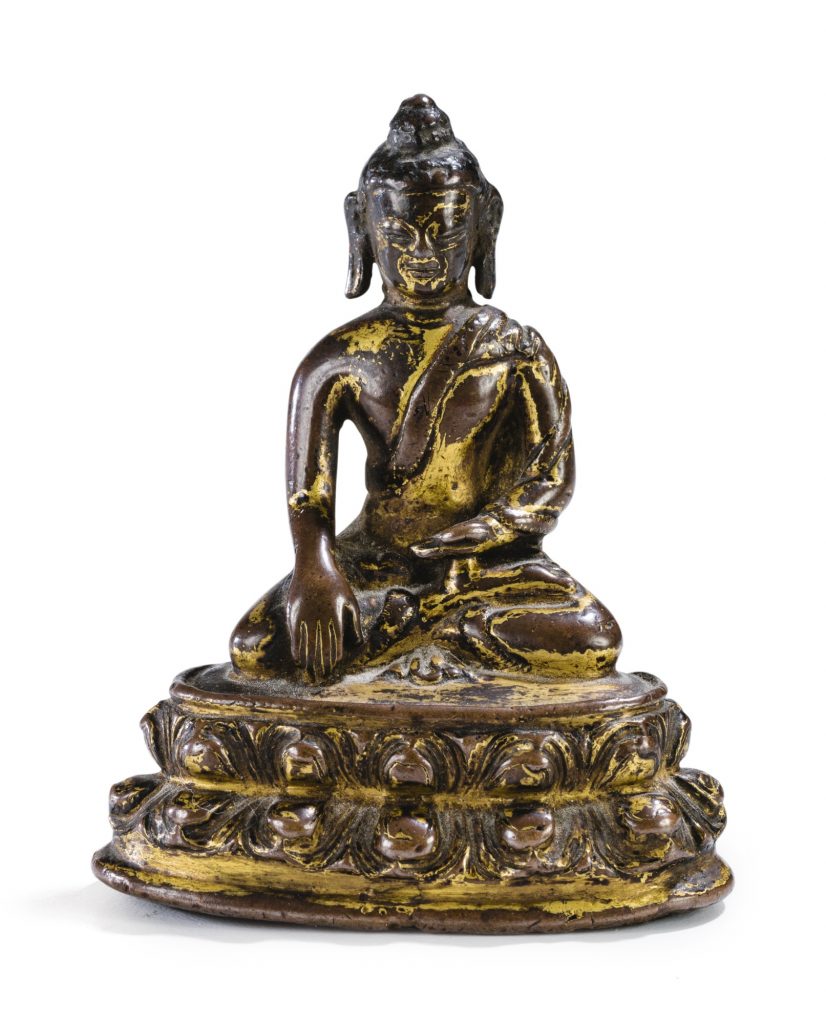
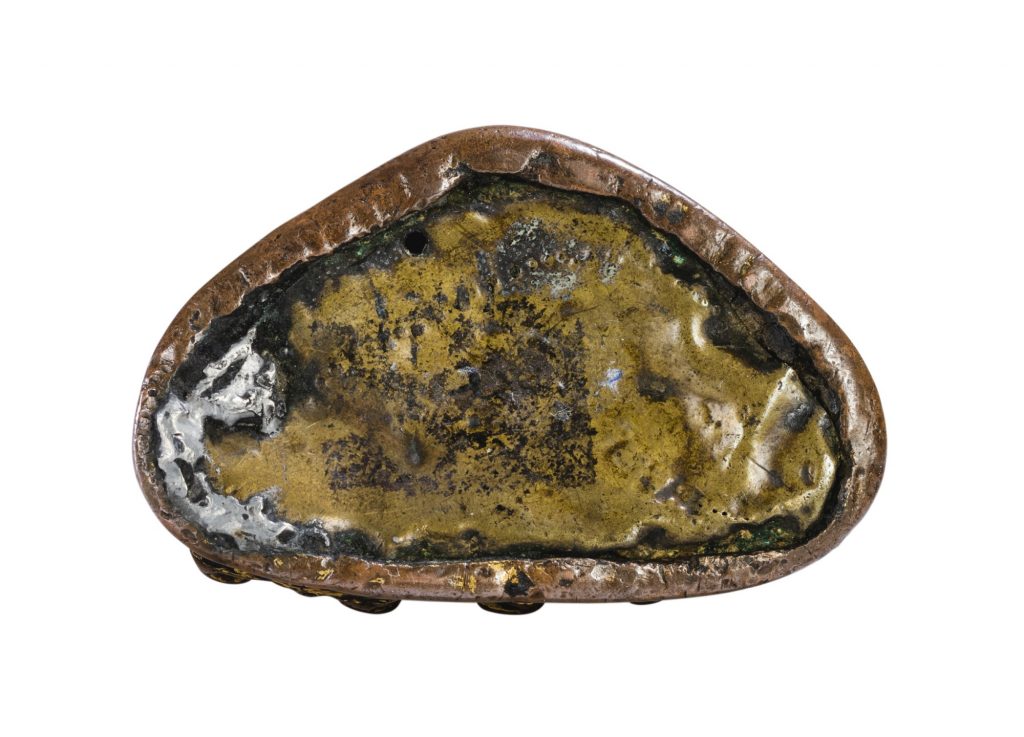
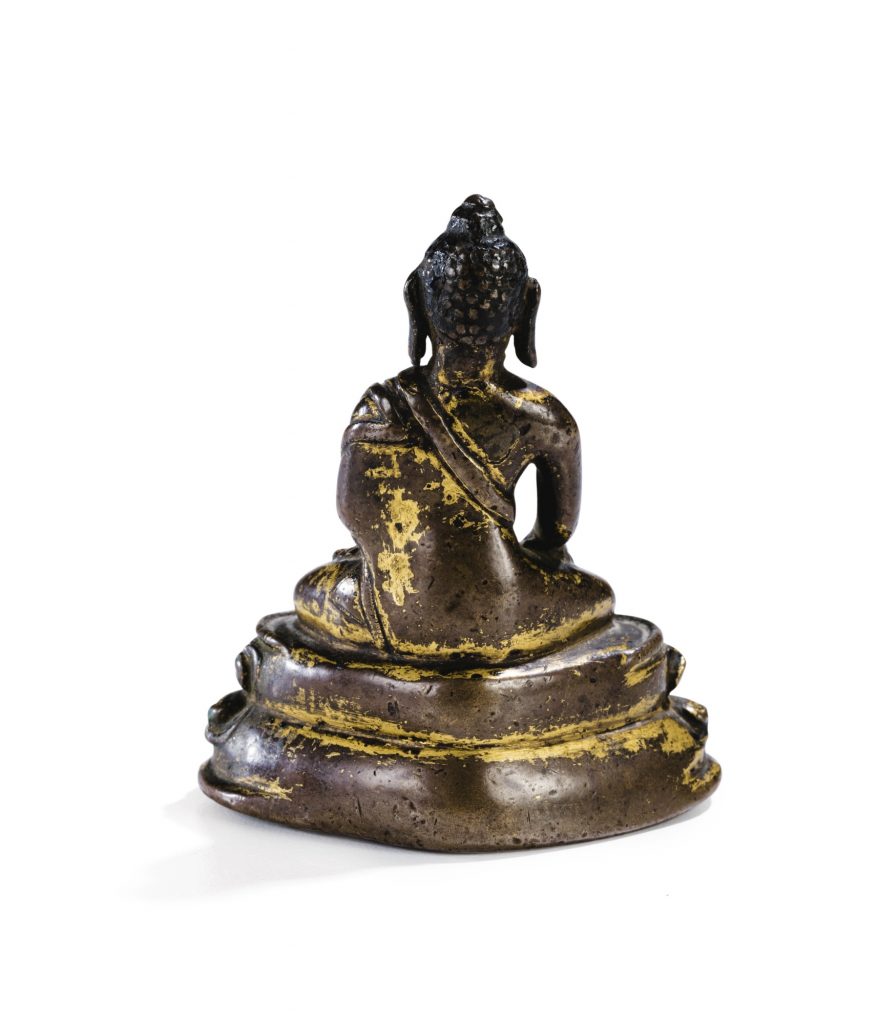
Estimate 1,500 — 2,000 EUR
LOT SOLD. 1,875 EUR
sitting in vajraparyankasana , right hand in bhumisparshamudra and left hand in dhyanamudra , sealed
7 cm, 2 3/4 in.
Small casting flaw to the upper back, overall wear to the gilding, the base sealed.
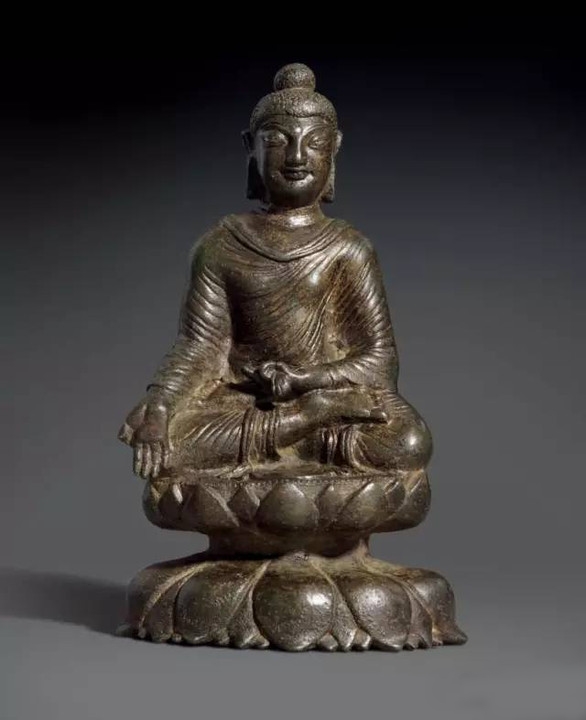
高13.4 cm
估价:40,000-60,000美元
参考: 國家博物館
泥金銅金剛薩埵像
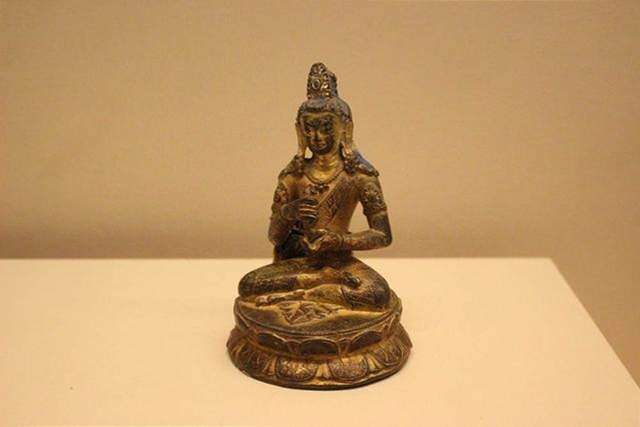
公元10世紀
2011年國家文物局劃撥 金剛薩埵意為「金剛勇猛心」,是密教第二祖。密教在印度流行後,金剛薩埵造像開始盛行,有時有明妃為伴,總是以菩薩形顯現。此像是東北印度帕拉王朝時期樣式,流行於公元8-12世紀。
参考: 國家博物館
鎏金銅金剛手菩薩坐像
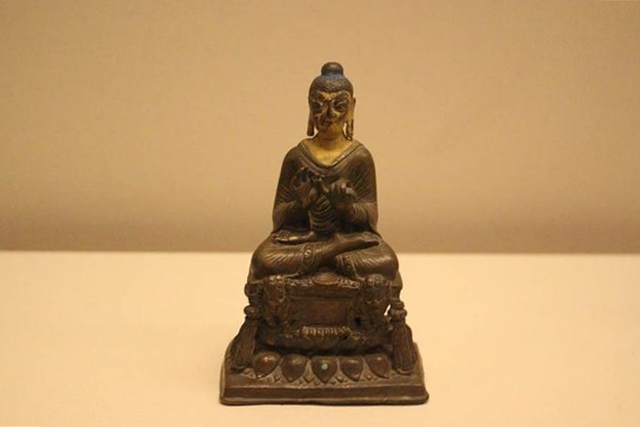
2011年國家文物局劃撥 此像雙手托握金剛杵於胸前,結跏趺坐於圓形蓮台上,上面陰刻「川」字紋,頗具尼泊爾風格。金剛手菩薩是佛身邊的侍從,在佛教密宗中是八大菩薩之一,被認為是密宗的起源。他手中所持金剛杵象徵無堅不摧,用以摧毀外道。
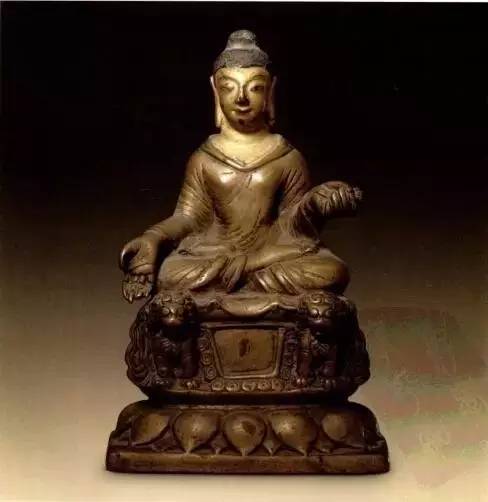
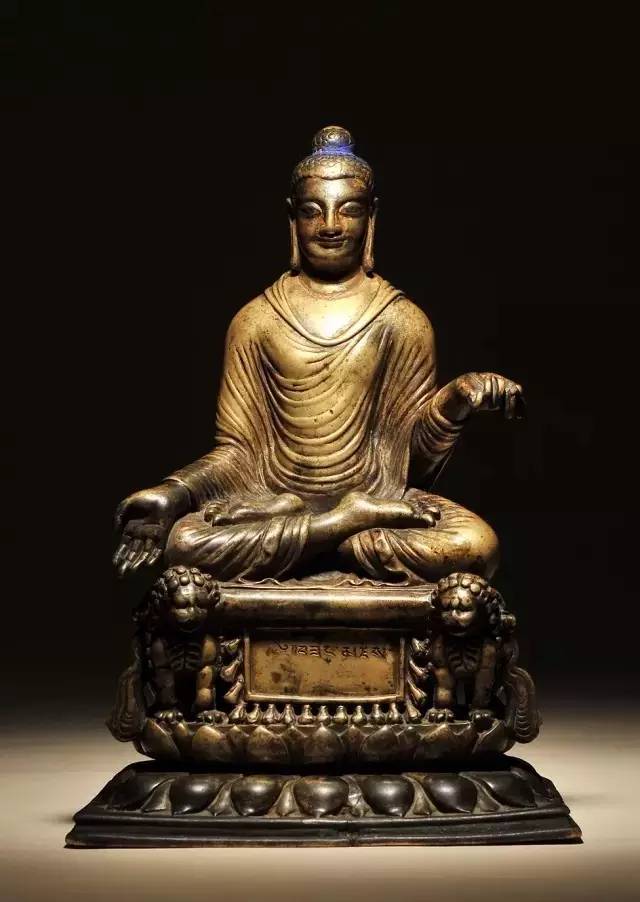
7/8世纪 铜释迦牟尼(错银错红铜)
H:19.5cm
藏文题记:庄严的,精美的!
来源:
1.台湾辽楼居旧藏;
2.五觉斋旧藏。
出版:
1.《西藏佛教艺术》,文化艺术出版社,2008年,第26-27页,图1-14;
2.《藏族文物》,中国藏学出版社,2008年,第31页;
3.《盛放莲花——历代佛教造像撷珍》,文物出版社,2009年,第68-69页;
4.《海外回流西藏文物精粹》,文物出版社,2012年,第24-27页,亦为封面作品;
5.《佛韵——造像艺术集粹》,文物出版社,2013年,第70-73页。
展览:
1.“海外回流西藏文物精粹展”,西藏博物馆,2012年7月25日至9月25日;
2.“佛韵——造像艺术集粹”,首都博物馆,2013年11月8日至11月28日。

![[临渊阁]天地一家春](https://www.antiquekeeper.ca/wp-content/uploads/2023/03/antiquekeeper_banner_image_2-4.jpg)
